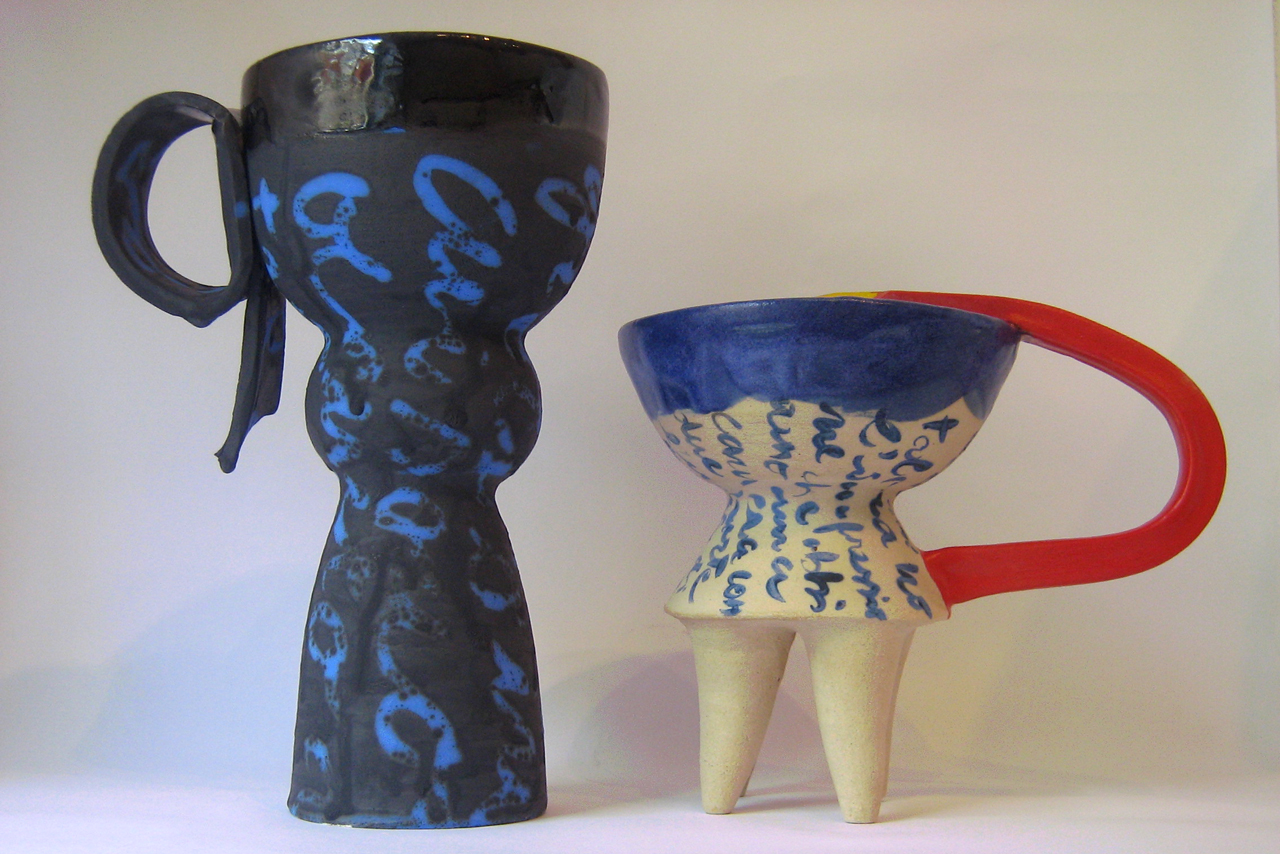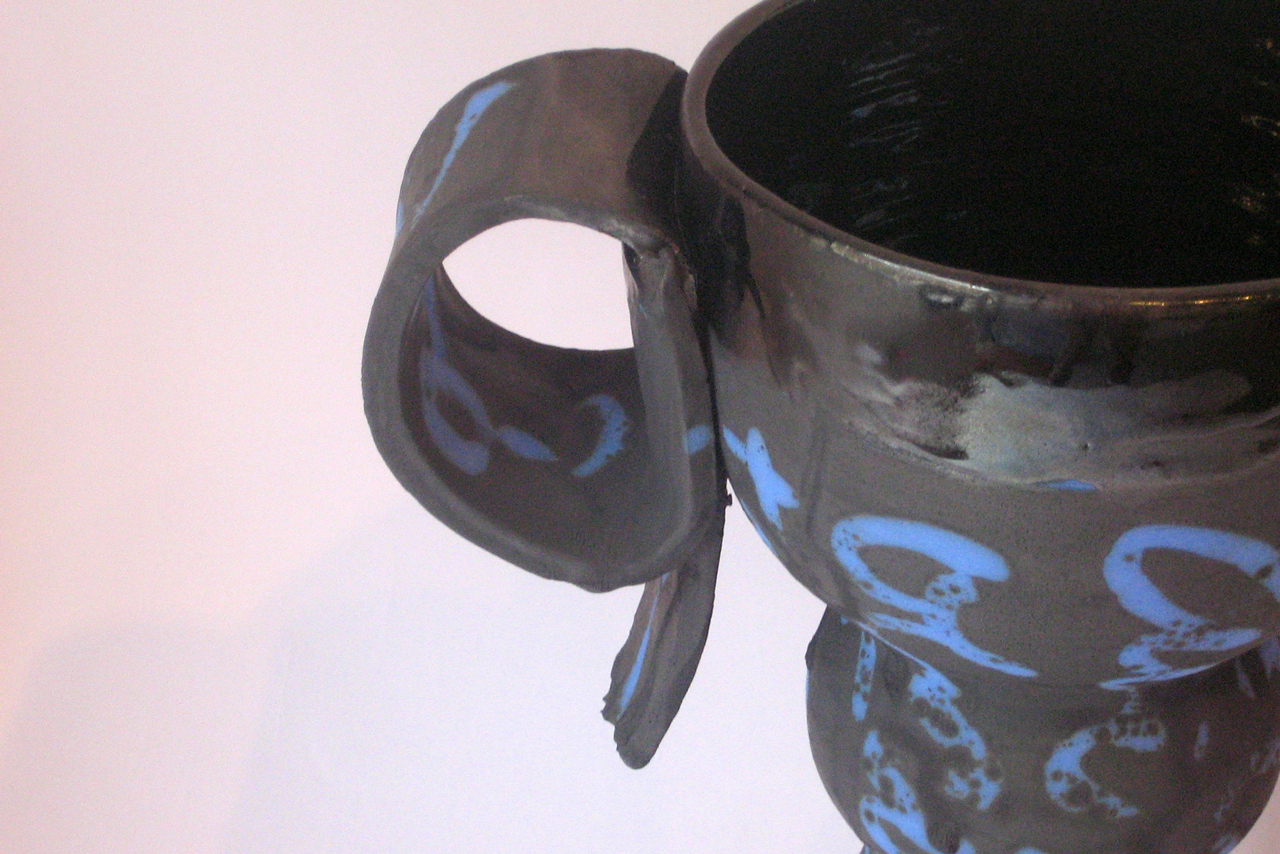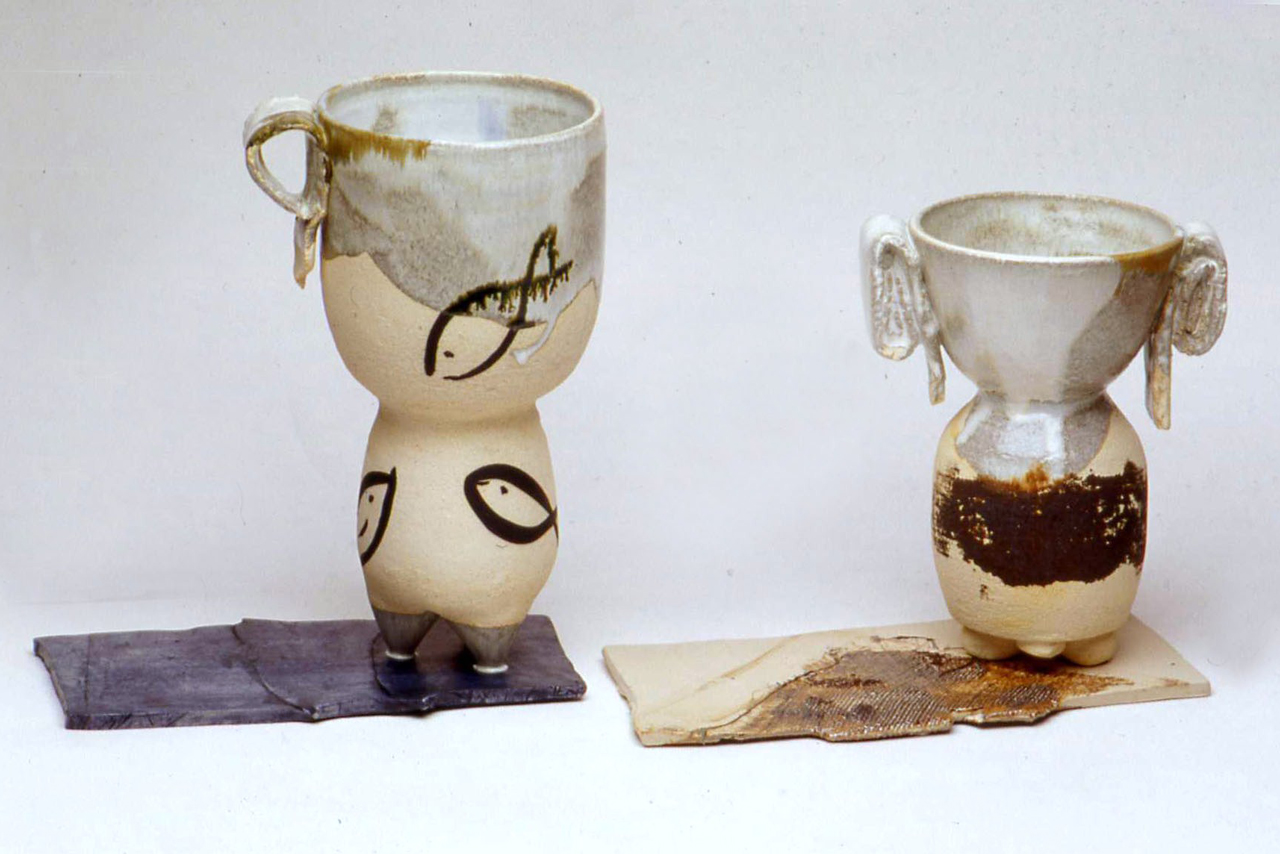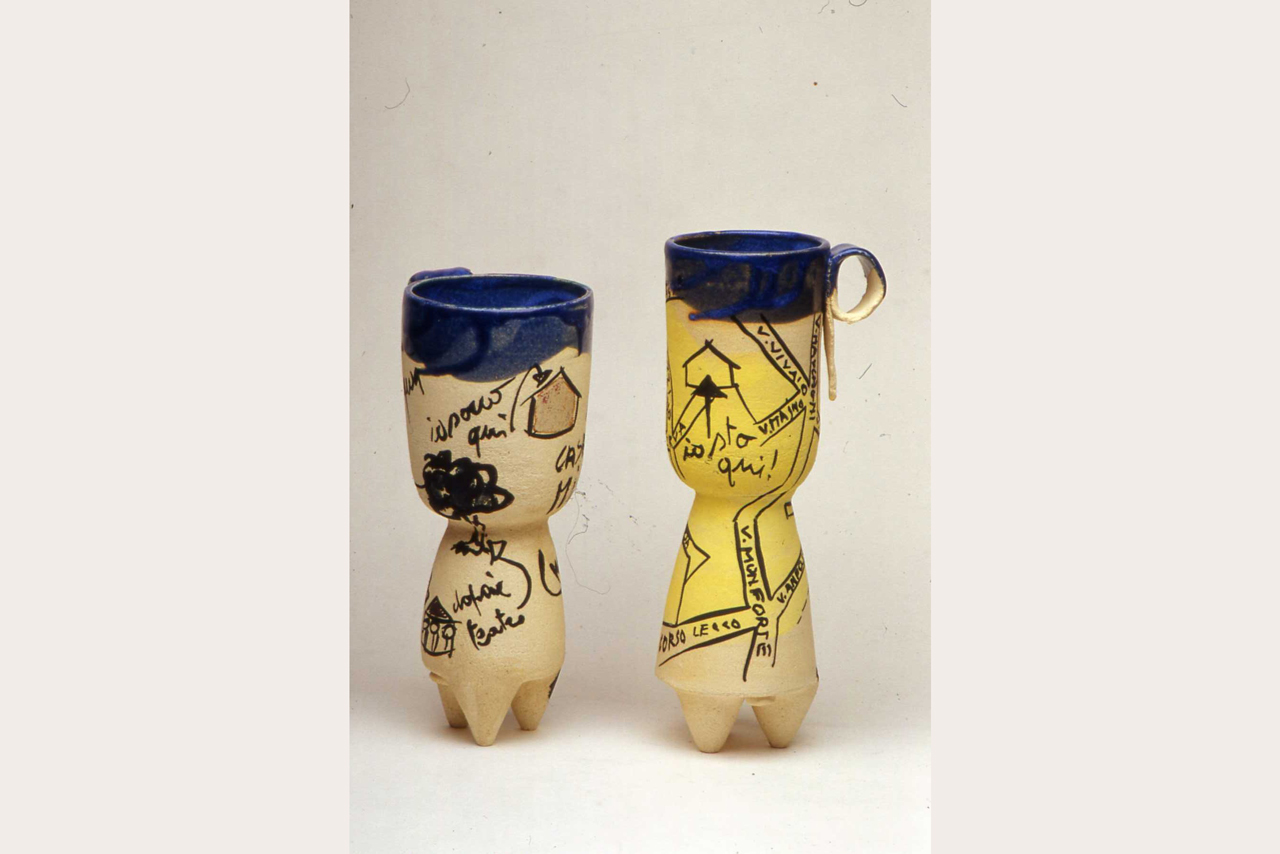Artworks
Public Diary in Grottaglie
2019
120x120xh0,5 cm
Stoneware, slip, ceramic serigraphy
Diario Pubblico a Grottaglie
2019
120x120xh0,5 cm
Gres, ingobbi, serigrafia ceramica
Grottaglie is one of the most important Italian towns with a ceramic vocation. Its Neighborhood of Ceramics makes this town a living museum.
The protagonists of the work Public Diary in Grottaglie are the portraits and testimonies of many of the people who have connected their existence with ceramic world.
This work was showed in 2019 in the exhibition Diario pubblico a Grottaglie: appunti di viaggio, (Public Diary in Grottaglie: Travel Notes), at the Ancient Monastery of Cappuccini of Grottaglie, Italy.

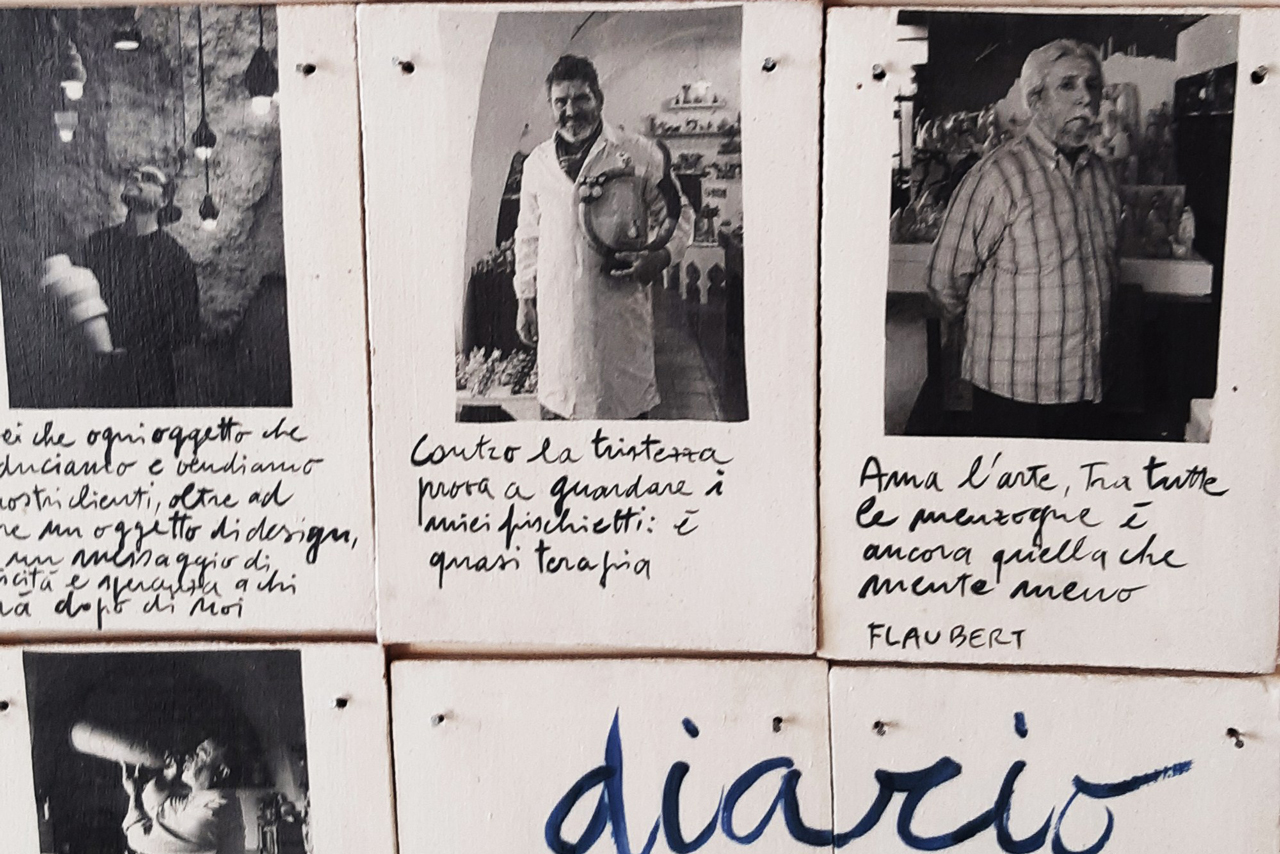
Writer’s Hopscotch
2019
60x90xh1 cm
Stoneware, slip, ceramic serigraphy
Gioco del Mondo dello Scrittore
2019
60x90xh1 cm
Gres, ingobbi, serigrafia ceramica
The player of each Hopscotch makes a route to reach a final destination. So, the Hopscotch is the metaphorical route of life and all the elements that are part of it. The writer’s Hopscotch is a route filled by the exclusive passion for writing.
This work was showed in 2019 in the exhibition Diario pubblico a Grottaglie: appunti di viaggio, (Public Diary in Grottaglie: Travel Notes), at the Ancient Monastery of Cappuccini of Grottaglie, Italy.
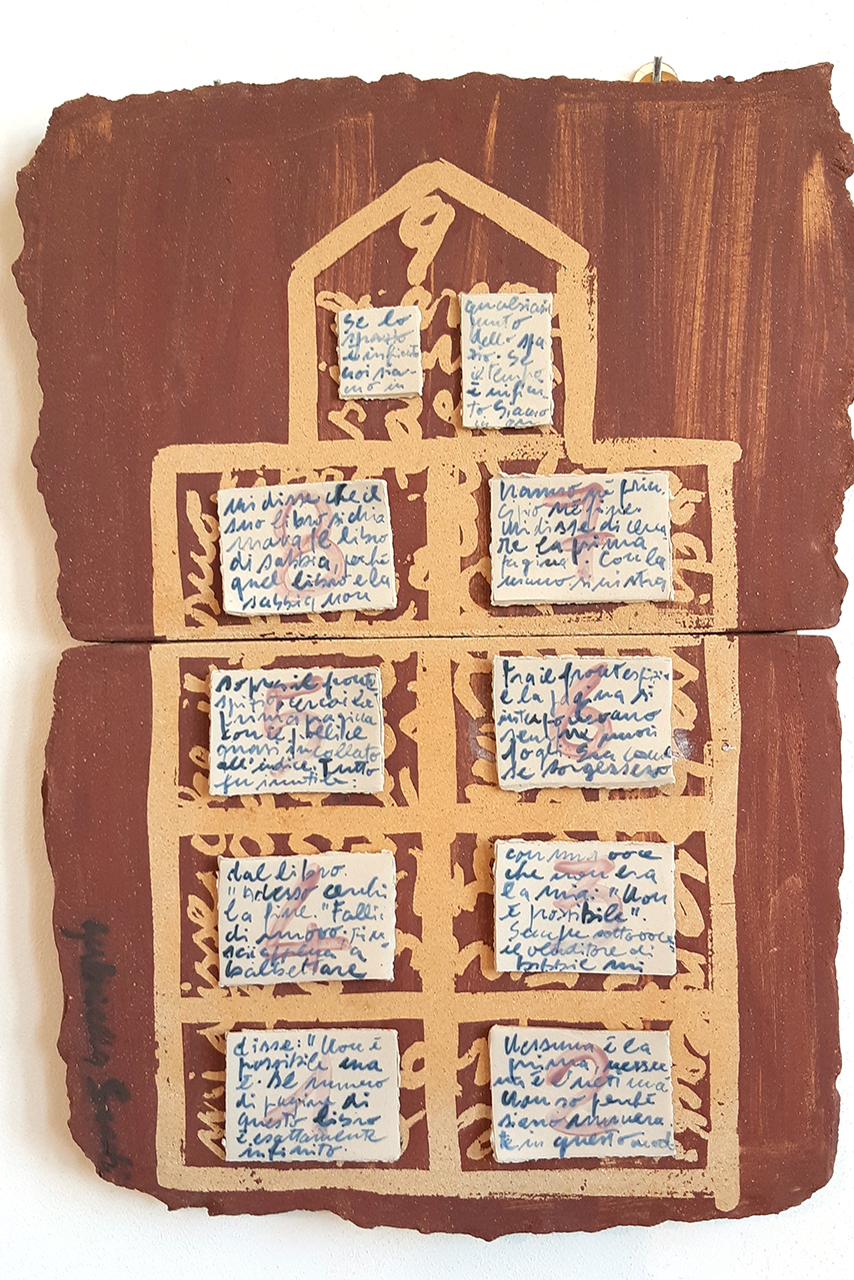
Child’s Hopscotch
2019
60x90xh1 cm
Stoneware, slip, ceramic serigraphy
The path that the child faces in his Hopscotch is characterized by the presence of the games, of the first school experiences, of the dearest affections. But there is even fear for all that seems incomprehensible and frightening to him.
This work was showed in 2019 in the exhibition Diario pubblico a Grottaglie: appunti di viaggio (Public Diary in Grottaglie: Travel Notes), at the Ancient Monastery of Cappuccini of Grottaglie, Italy.
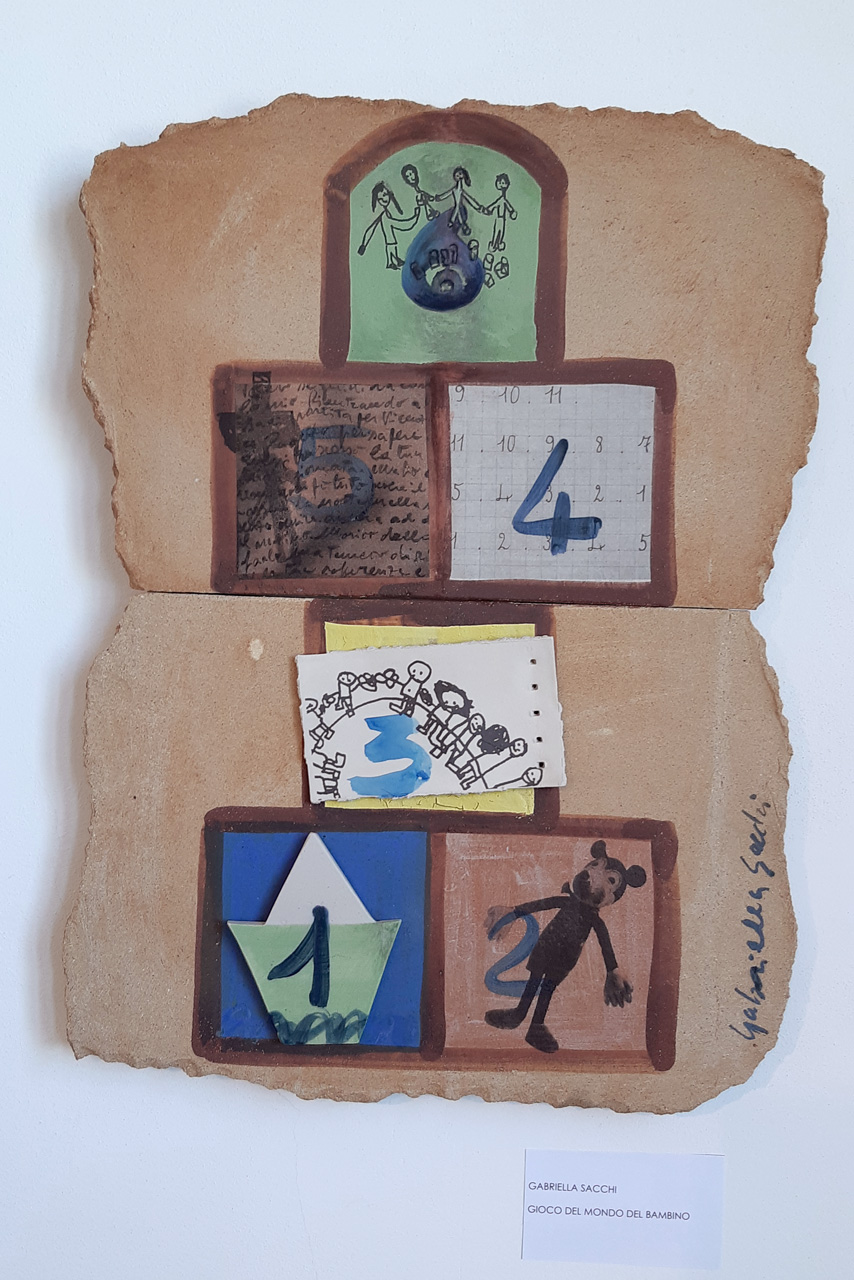
1980 Journey to China/2018 Journey to Taiwan
2018/2019
160x27xh9 cm
Paper clay, glazes, photoceramics
I went to China in 1980. That trip was important for me because in the 70’s China represented a myth for my generation that had idealized the personalities and political ideals of that country. During my trip I bought some cheap objects that represented that country for me. I went to Taiwan in 2018 on the occasion of the Congress of the International Academy of Ceramics. My generation thought that Taiwan was the country that had betrayed China. During my recent journey I thought that China is very similar to Taiwan today. The boxes of my work are the containers of my memories.
This work was selected in 2019 at the Biennial Ceramic Exhibition of Cluj, Romania.



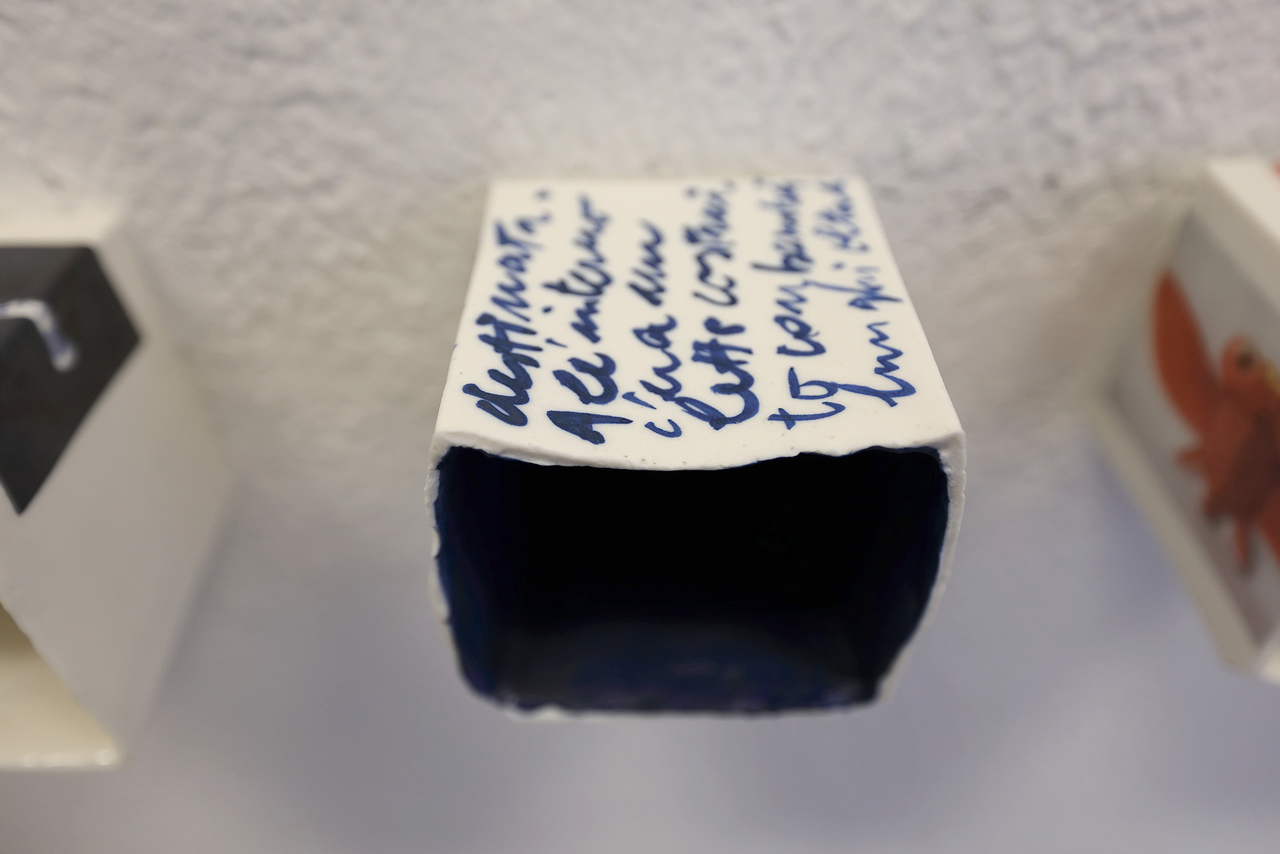
Nourishment
2019
104x40xh9 cm
Paper clay, slip, glazes, ceramic photography
Camminando su strade di città e campagna ho raccolto molti tipi di semi osservando le loro forme, i colori, le superfici, la loro apparente forza o fragilità.
Ho immaginato la loro trasformazione per diventare piante e costituire il nutrimento per uomini, animali, ambienti naturali. Ma altri tipi di semi sono evocati in quest’opera: la poesia, la letteratura, l’arte sono semi che nutrono la mente e trasformano le persone e le società.



New Europe
2018
200x180xh4 cm
Majolica, photoceramics
In my parents’ home there was a collection of dishes that has accompanied my life in that house. The same collection, that is in my home now, has inspired the new dishes I have created. The drawings and photos I have chosen are reminiscent of the faces, stories and movements of migrant people who are transforming Europe.
This work was selected in 2018 at the International Ceramic Competition of Andenne, Belgium.
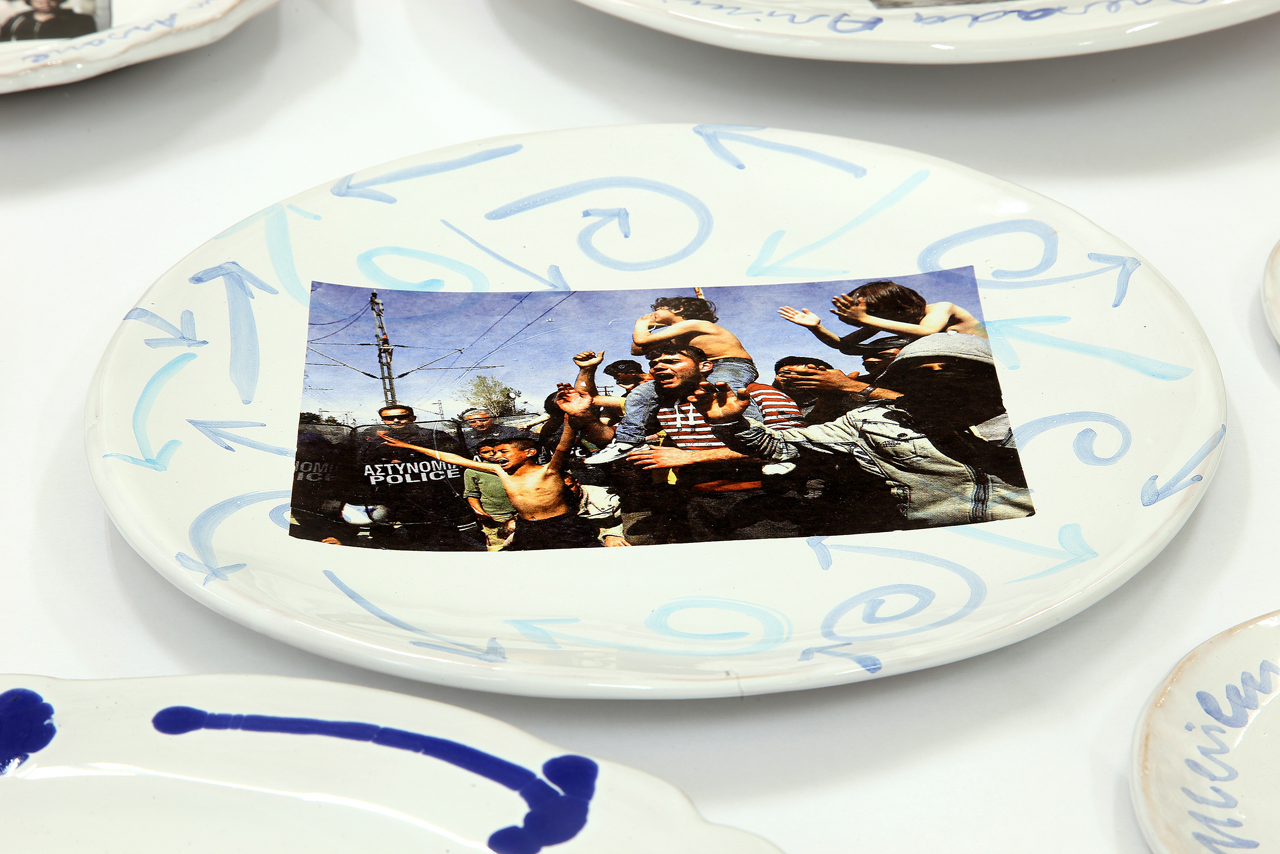
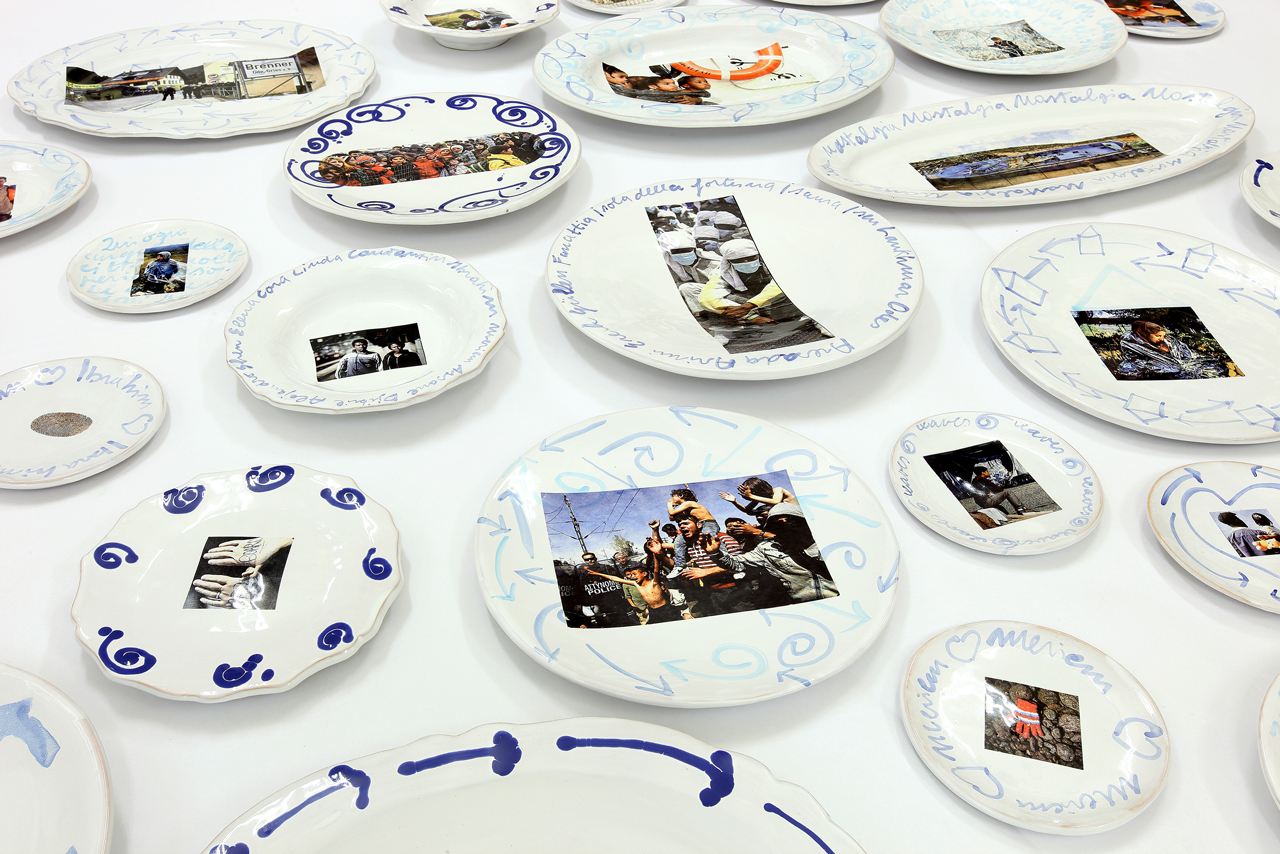
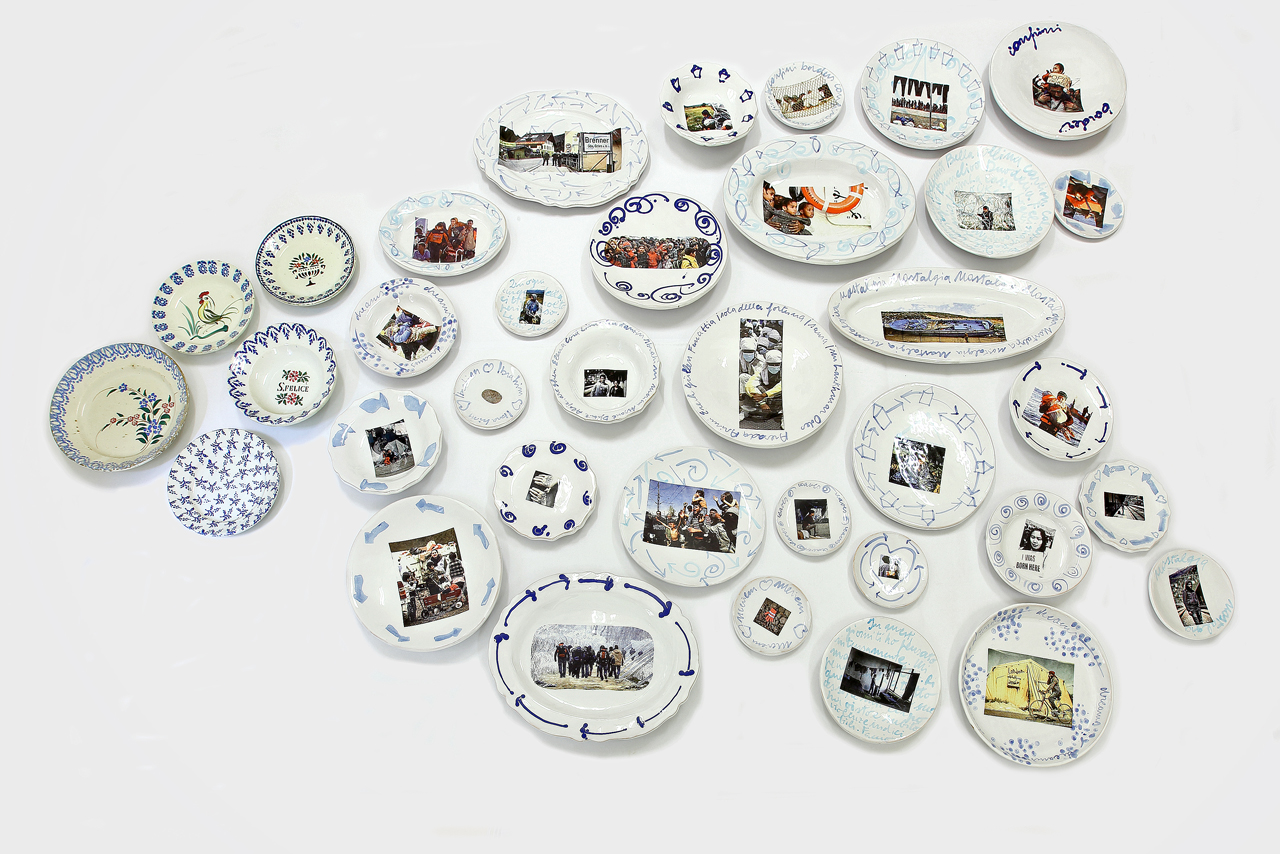
Randomness/Design
2018
217x110xh8 cm
Gres, majolica, slip, glazes, ceramic serigraphy
Design and randomness are present in each creative process. One of these elements sometimes prevails over the other in an unexpected way and this can depend on various factors. The compositional game that characterizes this wall work comes from the use of ceramic materials randomly accumulated over time.
This work is located in the artist’s house in S.Giorgio Scarampi in Piedmont (Italy).


Notes of Travel
2018
Every wall works measures 60x62xh15 cm
Stoneware, slip, glazes, photo ceramics
This work is like a diary with the pictures and texts that describe the travels I made to Puglia from the 70’s till the most recent years. The connection between this region and ceramics has been highlighted in this work. This bond has helped me to love Puglia and it has pushed me to come back to this country to know it better.
In 2018 this work won the second prize at the International Ceramic Contest of Grottaglie (Italy).
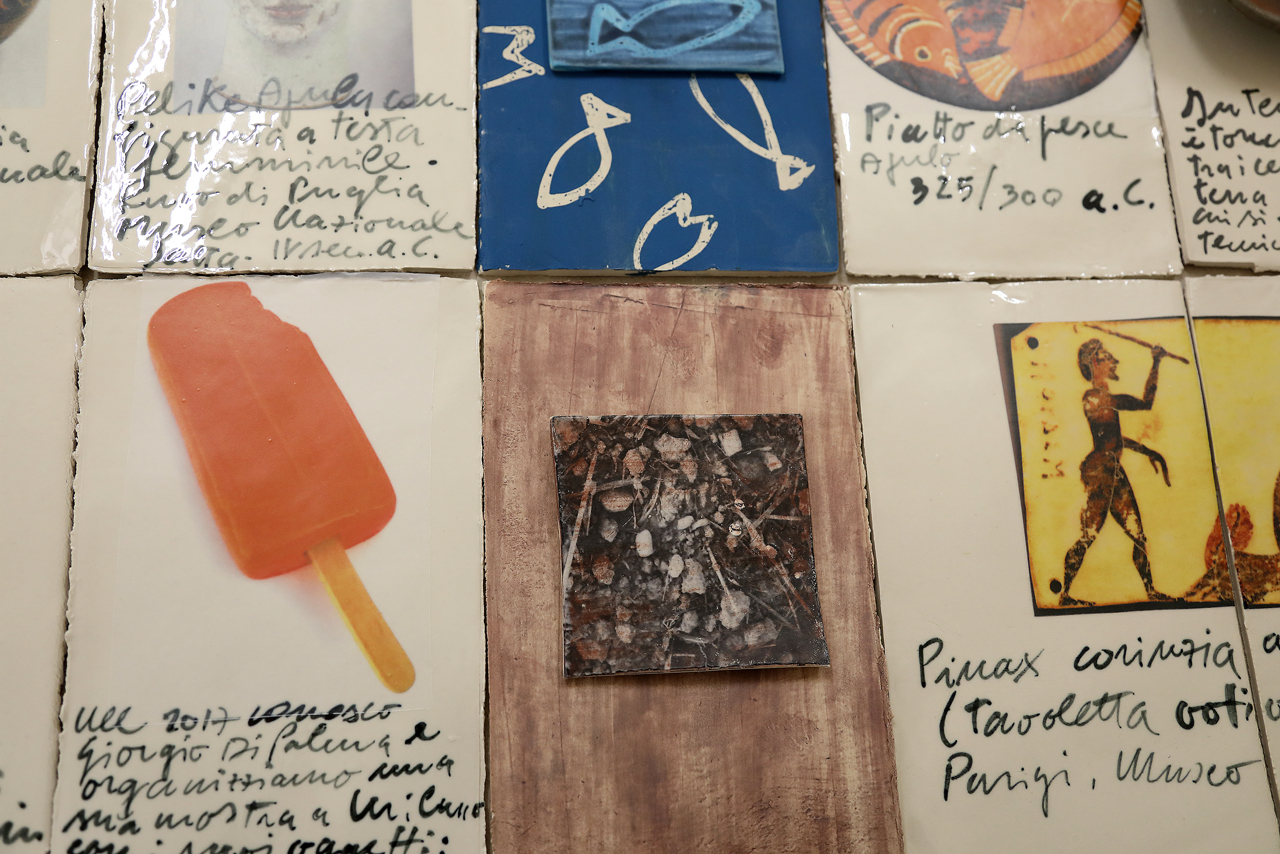

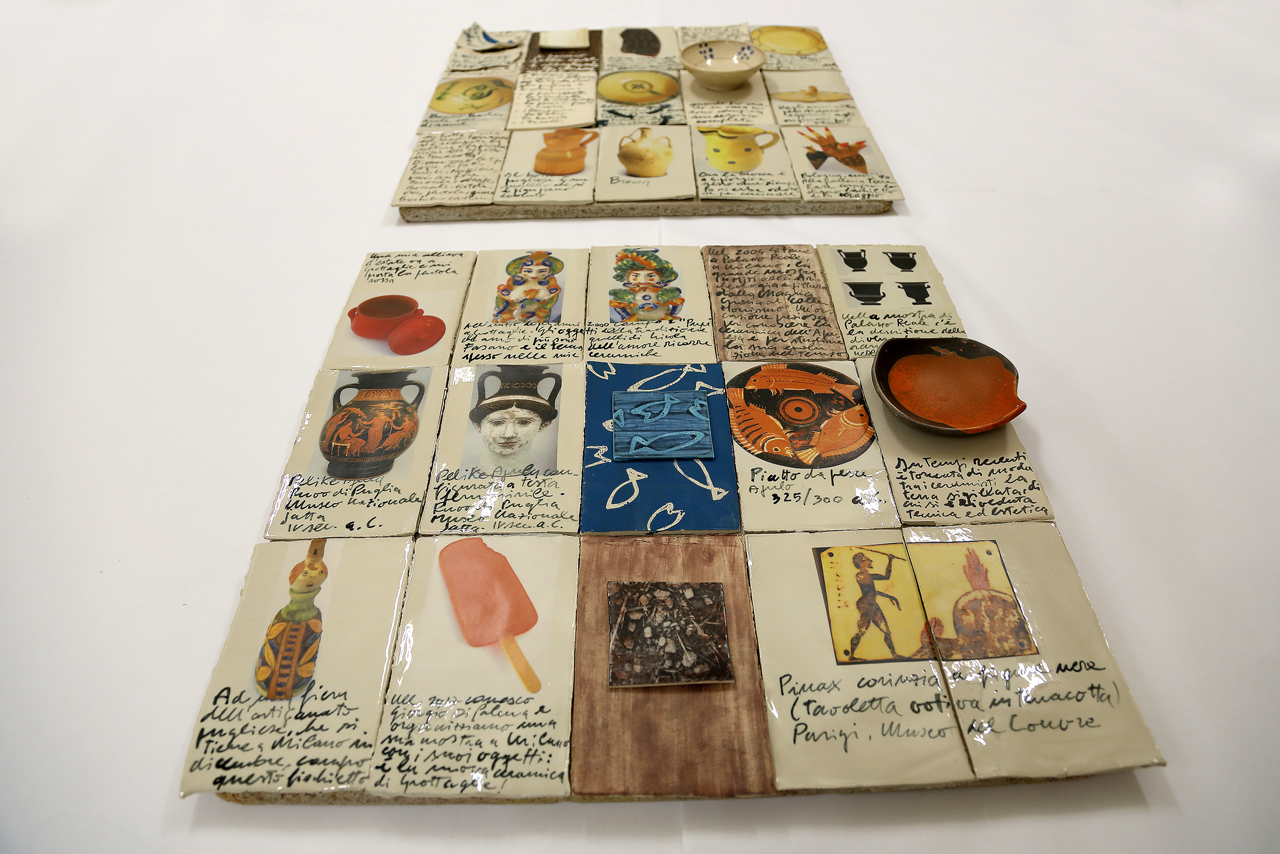
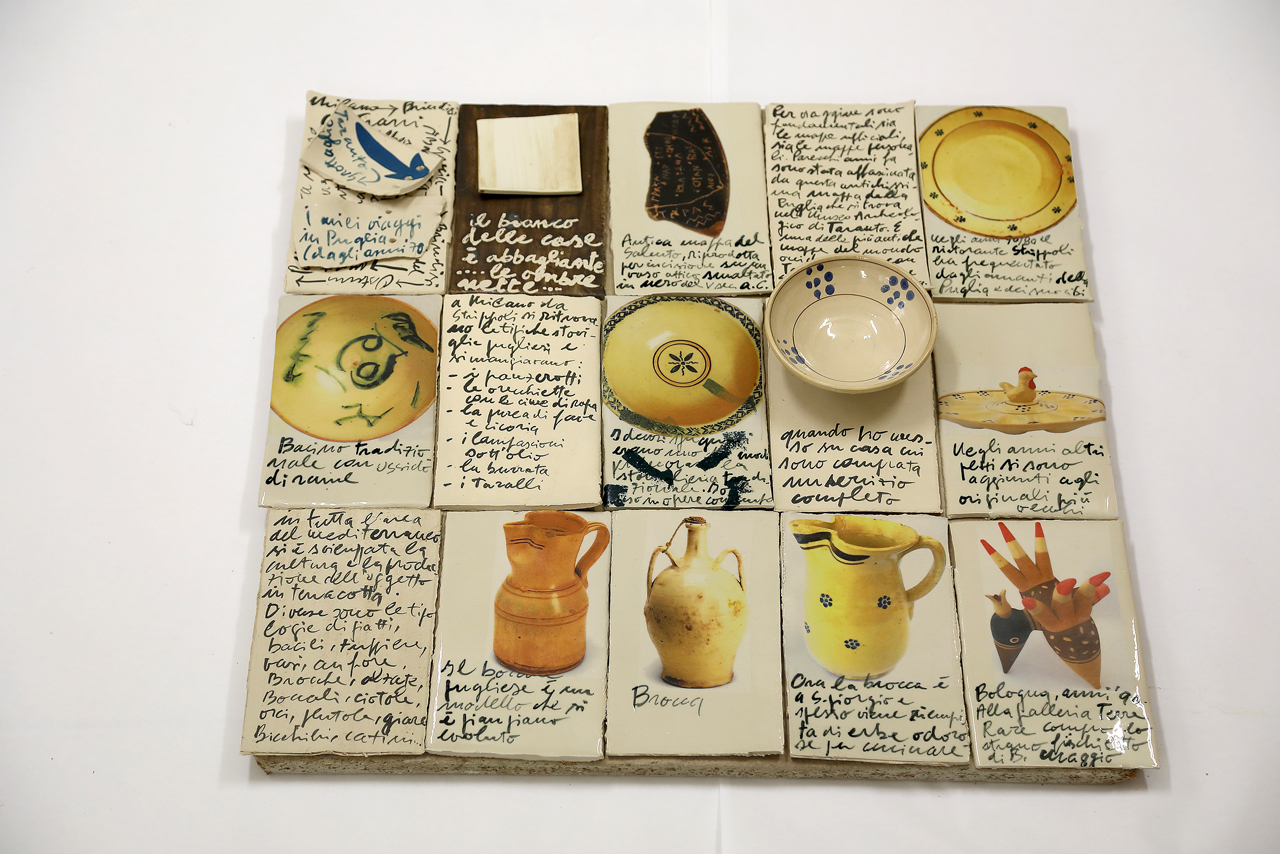
Peony
2018
104x40xh9 cm
Majolica, ceramic photography
In Oriental culture and art the peony is an important symbol that has been represented in many different ways. It has even influenced Western art, especially ceramics. One of the most famous designs of Faenza ceramics comes from the transformation of the oriental image of the peony. The art world is very often inspired by tradition and it creates expressive forms containing human memory, our present, our future.
This work was selected in 2018 by the New Taipei City Yingge Ceramic Museum (Taiwan) on occasion of the exhibition New Orientalia of the IAC members.
This work is part of the permanent collection of the museum.




Gentle Morning Breeze
2018
30x6xh20 cm
27x5xh17 cm
23x3xh14 cm
Porcelain, slip, ceramic serigraphy
These three little boats form a single work. They evoke the concept of lightness with their shapes, colours, names: Gentle, Morning, Breeze.
This work was created on the occasion of the exhibition organized by Day by Day Gallery, Rome.
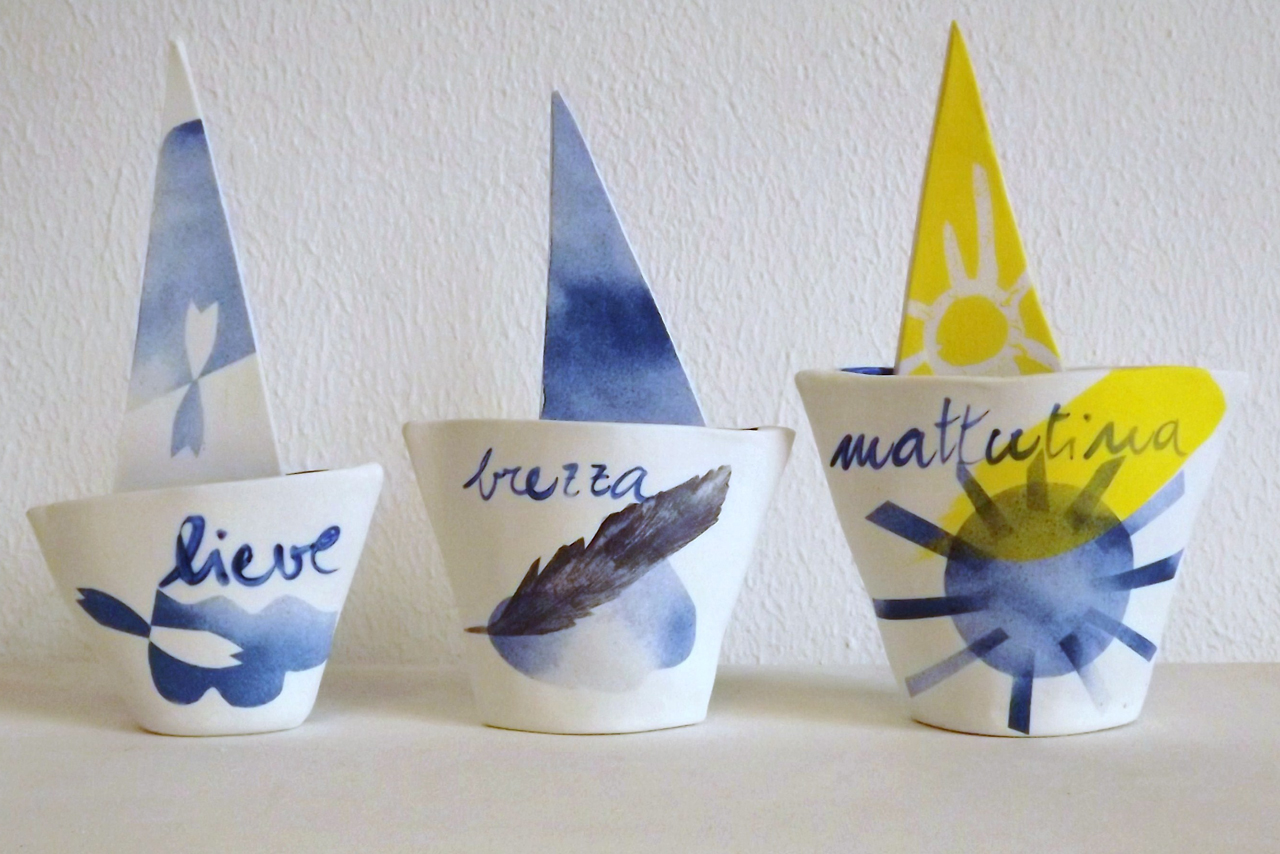


Narcissus
2017
20x20xh20 cm
Gres, slip, glazes, mirror
Narciso
2017
20x20xh20 cm
Gres, ingobbi, smalti, specchio
In Greek mythology, Narcissus is a beautiful vain young man who dies in a pool of water where he is looking at himself.
The work is a cube that contains some images referring to the Greek myth on five of its surfaces. On the superior side of the cube there is a mirror with a central hole. Looking through this hole it’s possible to see a glossy glazed surface simulating the existence of a pool of water.
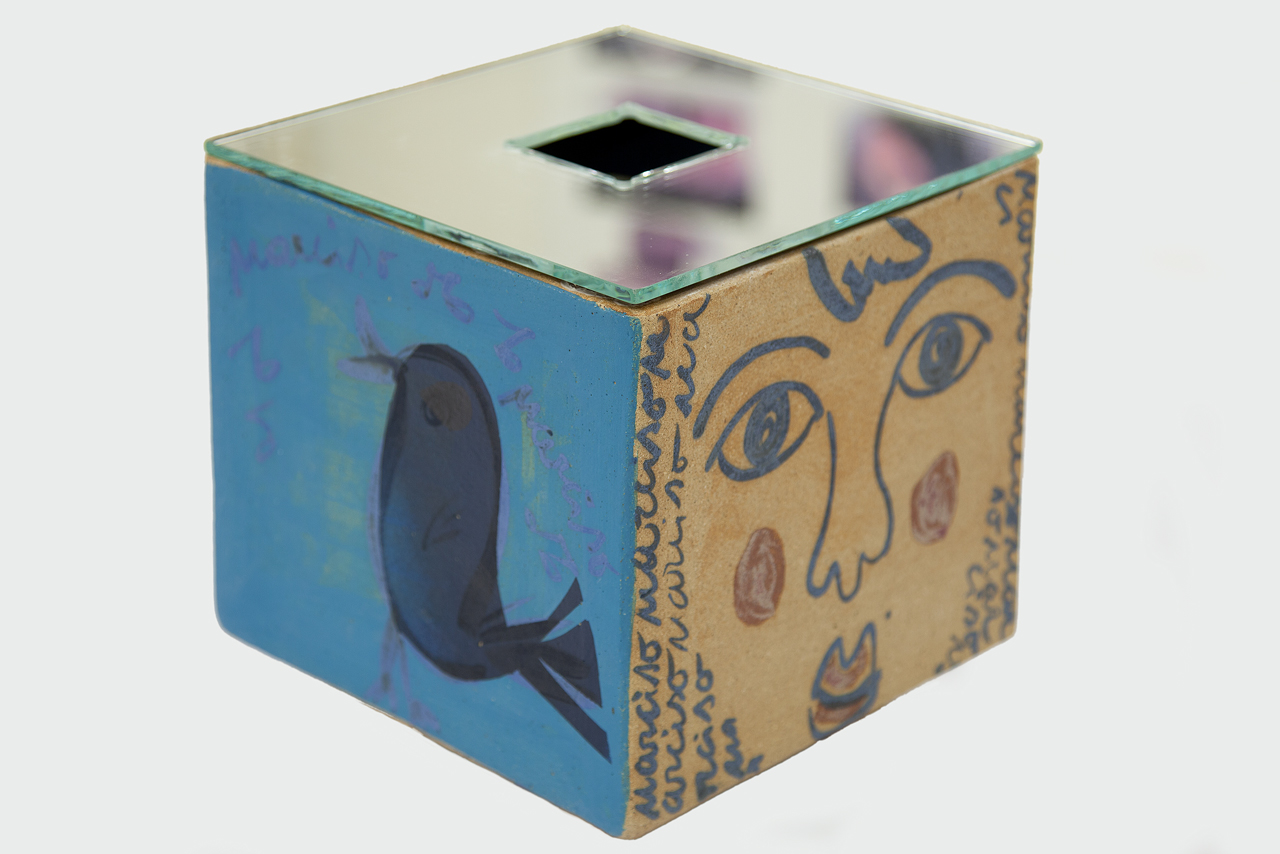


European Stories in Ceramics
2017
104x40xh9 cm
Majolica, photoceramics
Many emigrants are going through Europe looking for a better life. Their everyday presence is as important as the food we put on our plates.
This work was selected in 2017 at the International Ceramic Competition of L’Alcora, Spain.

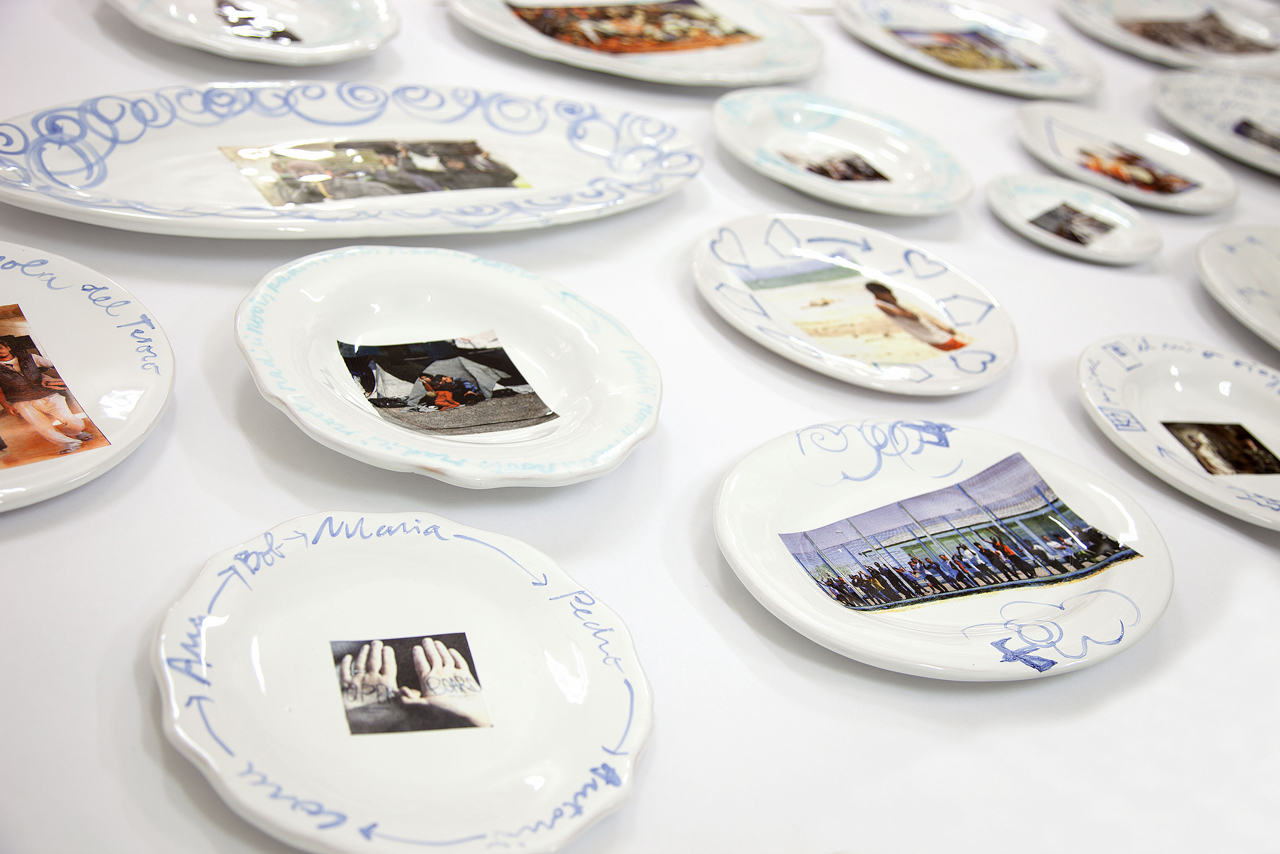
Crosswise Writings
2017
170x130xh5 cm
Stoneware, slip, glazes, ceramic serigraphy
This wall work is made up of many stoneware slabs with fragments of writing, graphic designs, engravings, colours that are part of some projects that were born in different times and situations.
This work is located in the artist’s house in S.Giorgio Scarampi in Piedmont, Italy.
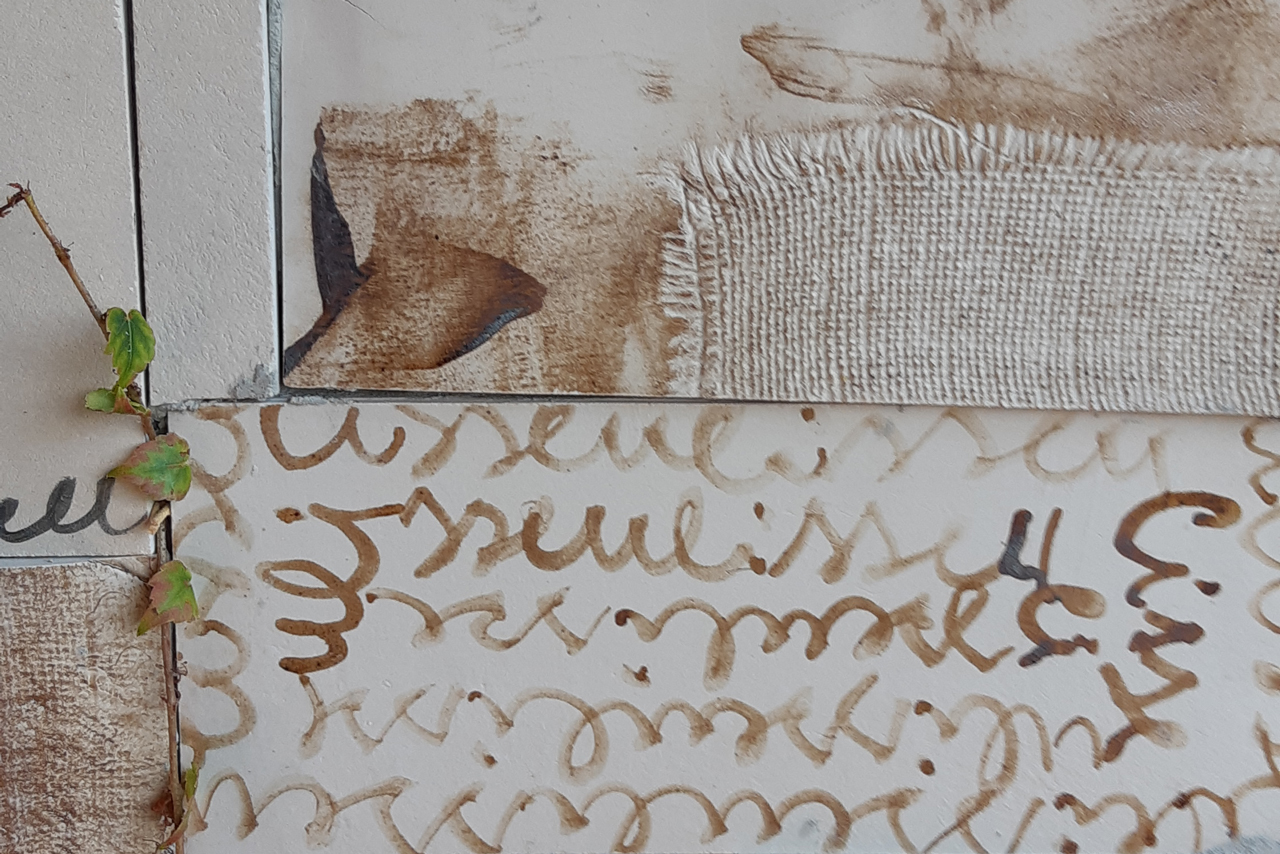



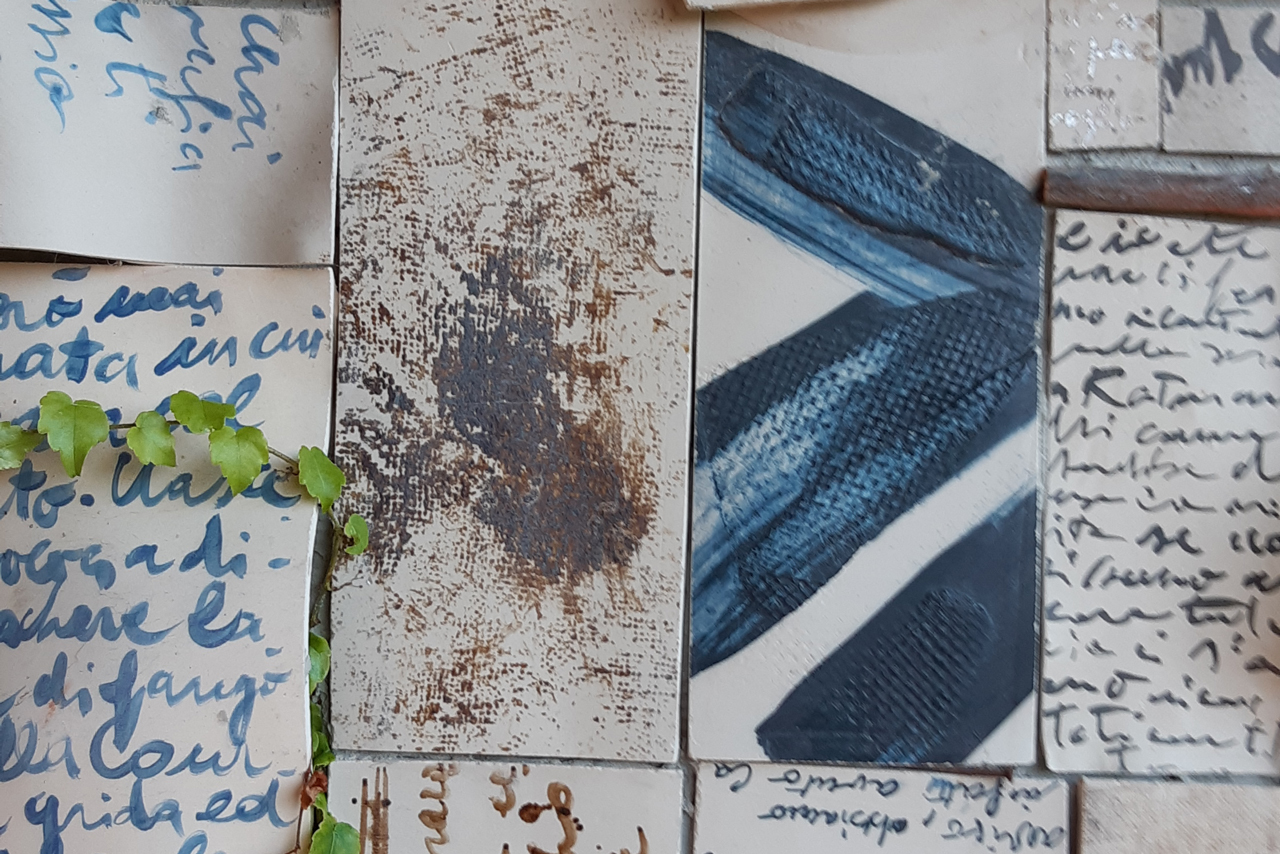

Blowin’ in the Wind
2017
250x100xh25 cm
Gres, slip, ceramic serigraphy
Millions of people leave their countries to migrate. Each of them has a name, identity, personal history. Each of them loves someone and something feeling sentiments and emotions. During their journeys many migrants get lost like small sheets of paper blowin’ in the wind.
This work was selected in 2017 at the 11th International Ceramic Competition of Mino (Japan).
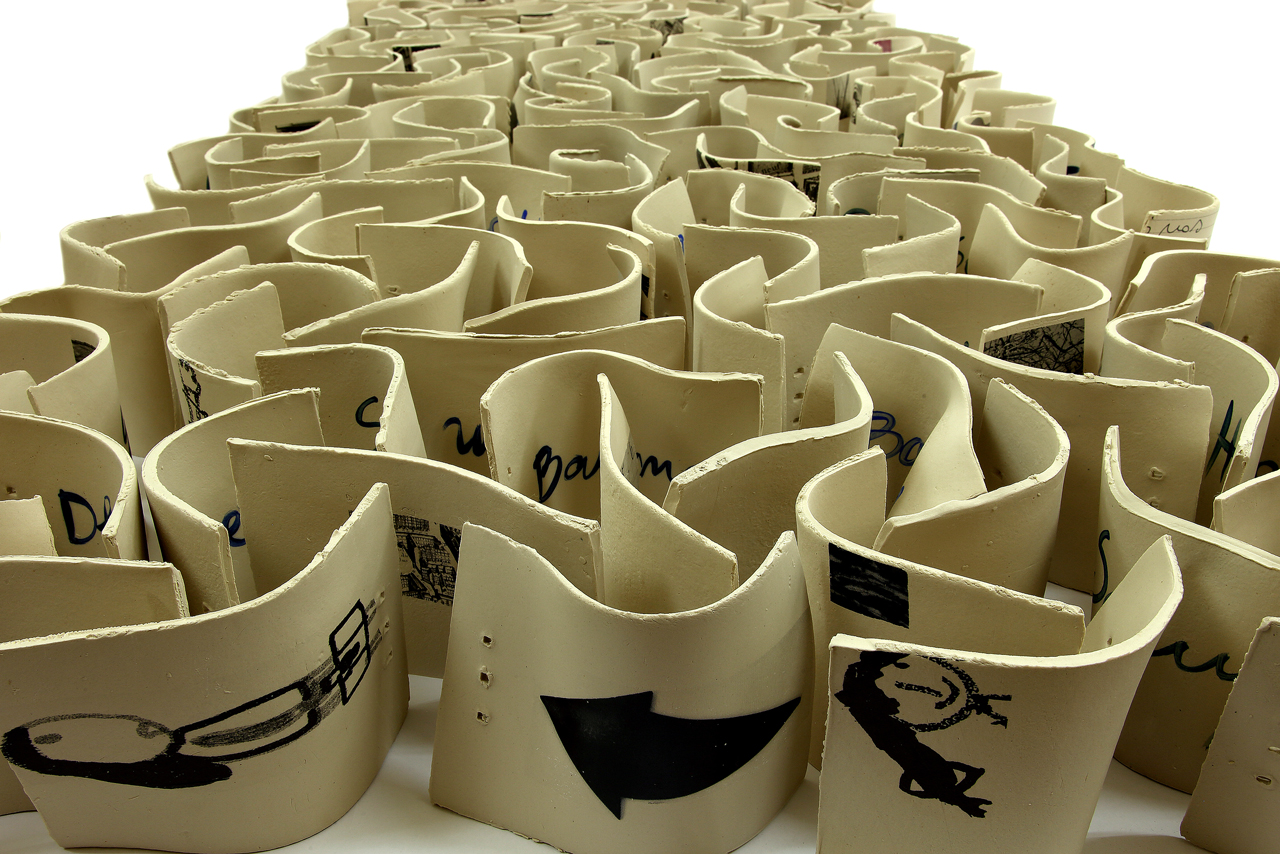

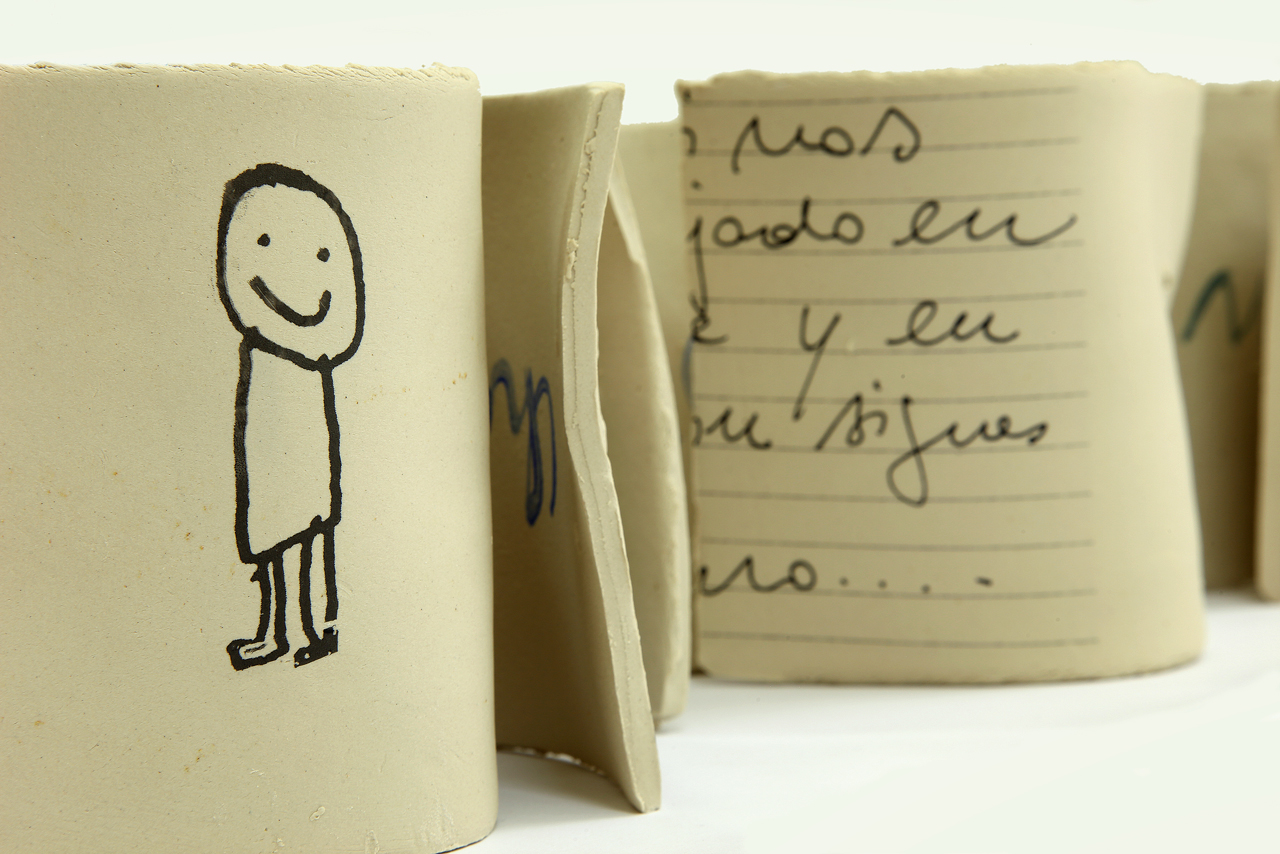
Hopscotch
2017
20x20xh24 cm
Gres, slip, ceramic serigraphy
The game called “Gioco del mondo” or “Campana” in Italy is present in many other countries and cultures. When children play, they draw some lines on the ground forming a definite area. Then they divide this area into smaller spaces. They arrive to the final destination jumping from one space to another. These works are three-dimensional Hopscotches. The stages, feelings and encounters characterizing and accompanying the run of human life have been represented on the surfaces of this work.
Some of these works have been selected on different occasions such as in 2017 at the XIII International Ceramic Biennial of Aveiro (Portugal), in 2016 at the exhibition Terre in vista, approdo alla ceramica contemporanea, Sukya Gallery in Lamezia and in 2018 at the Ceramic Exhibition of Castellamonte, Italy.
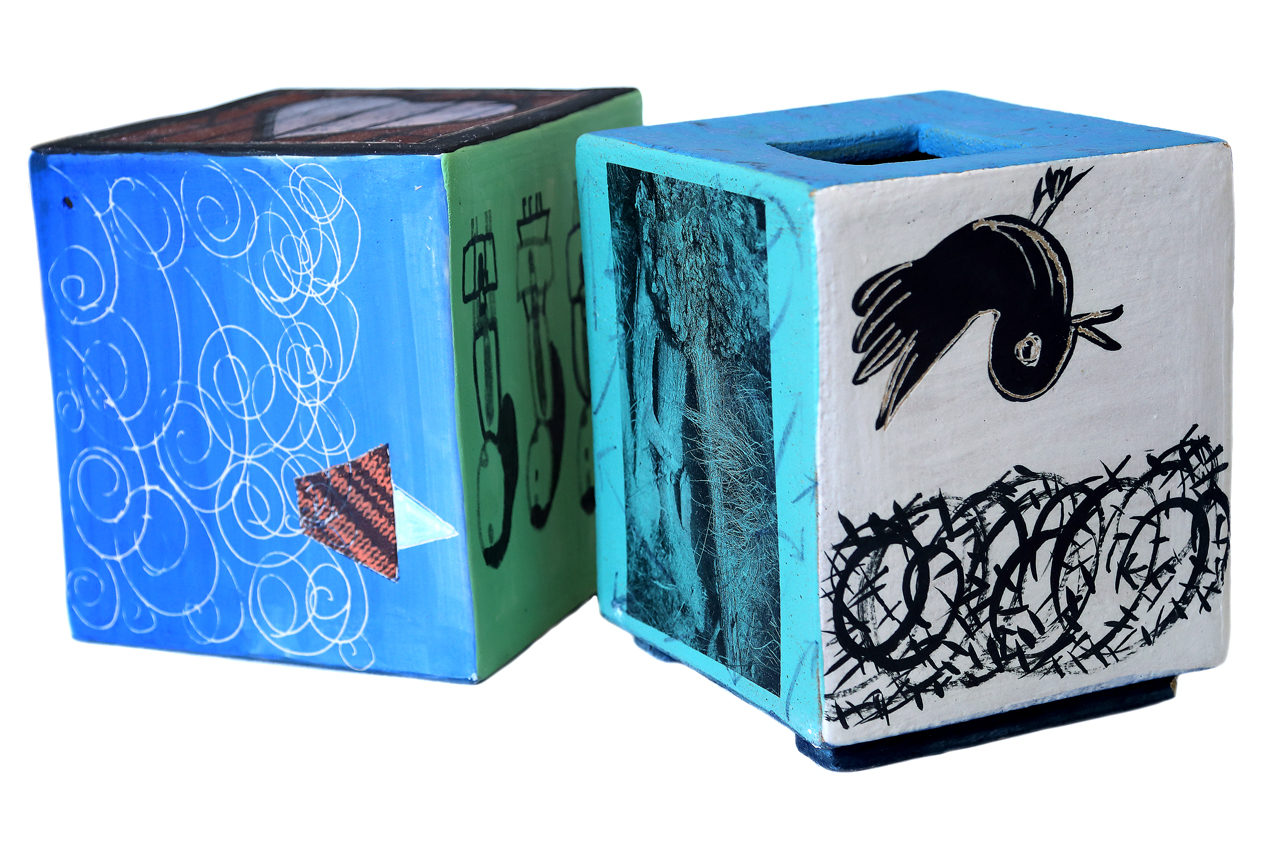
Travel Box
2016
20x20xh20 cm
Gres, slip, ceramic serigraphy
Travels and migrations characterize the whole history of humanity. The work Travel Box is an object that contains some of the most important and symbolic things for the traveller who is far from his home and family. The box is full of old and new memories at the end of the journey.
This work was selected in 2018 by the New Taipei City Yingge Ceramic Museum (Taiwan) on occasion of the IAC Members’ Free Expression Exhibition.
This work is part of the permanent collection of the museum.
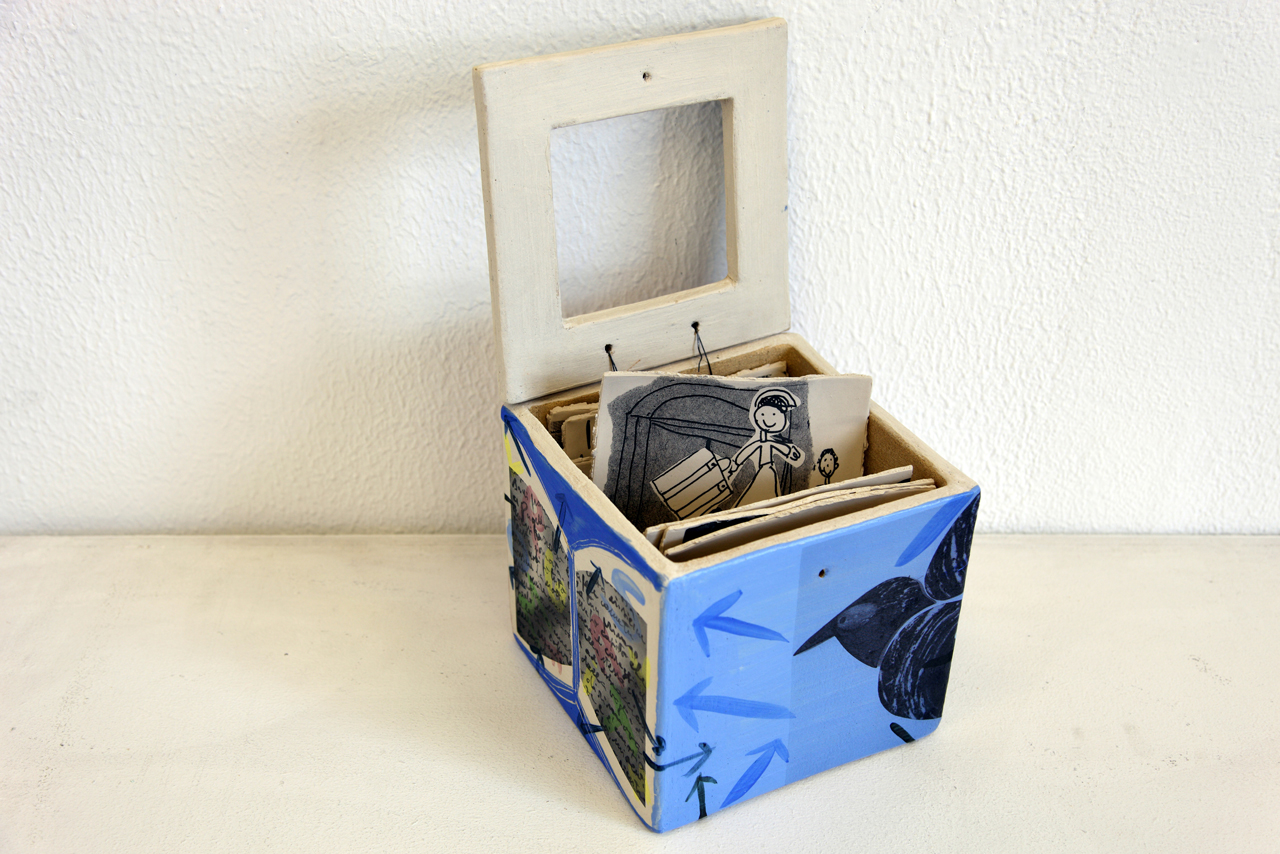
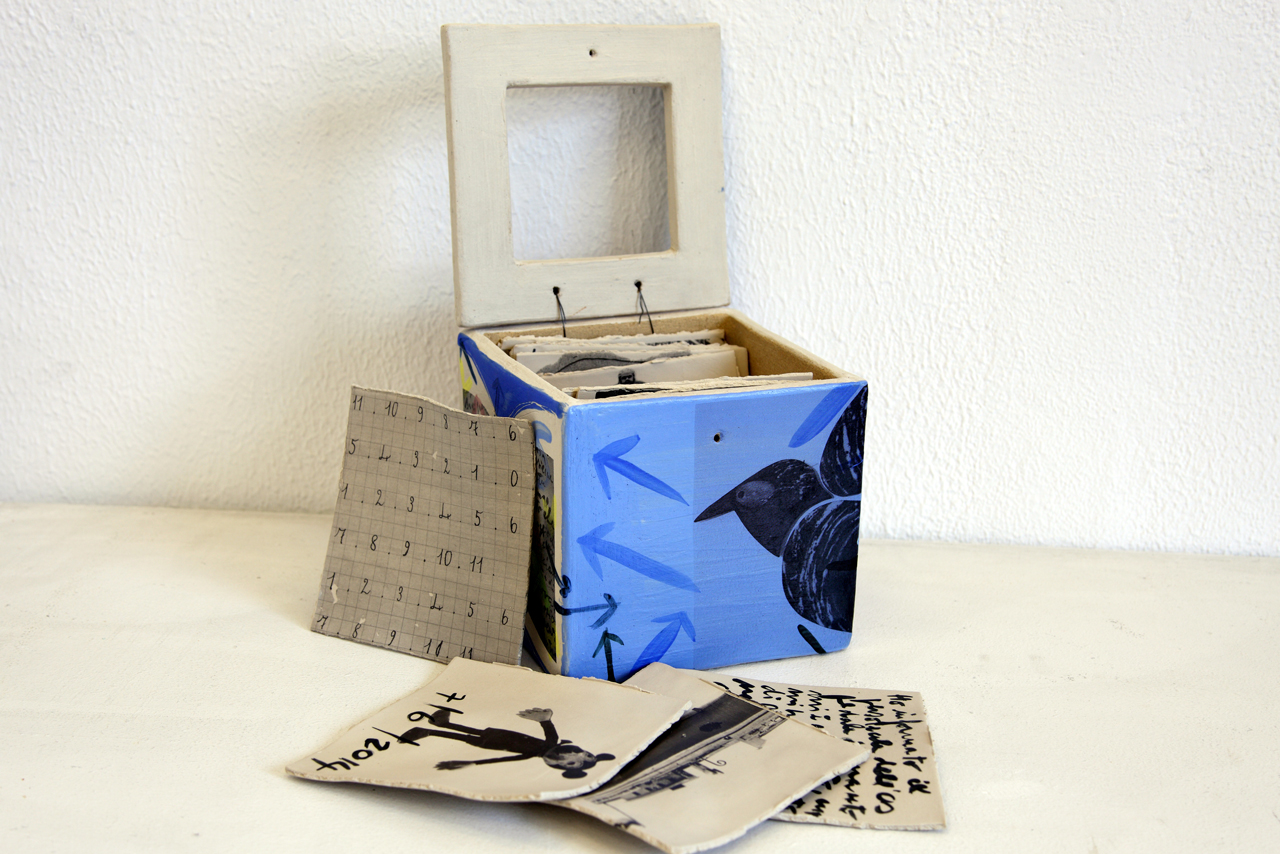

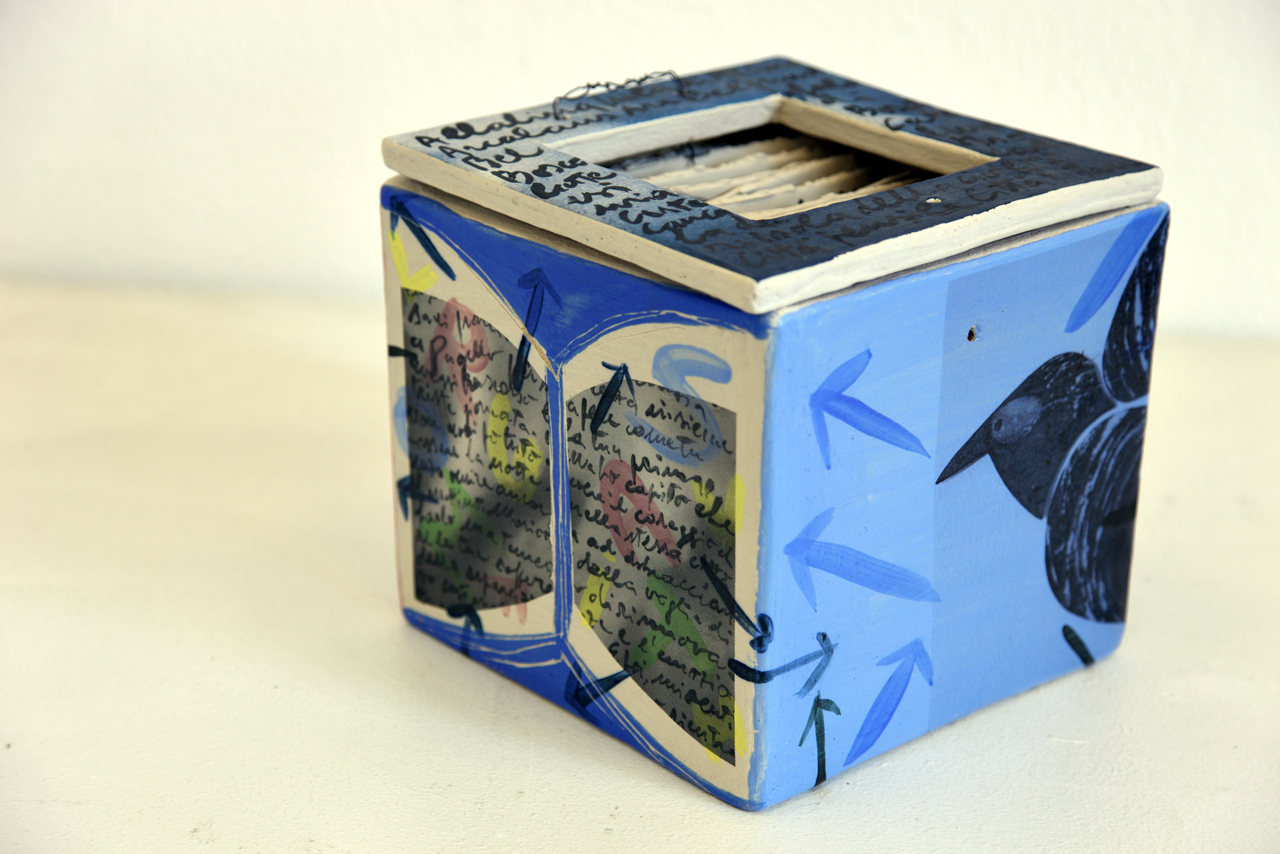
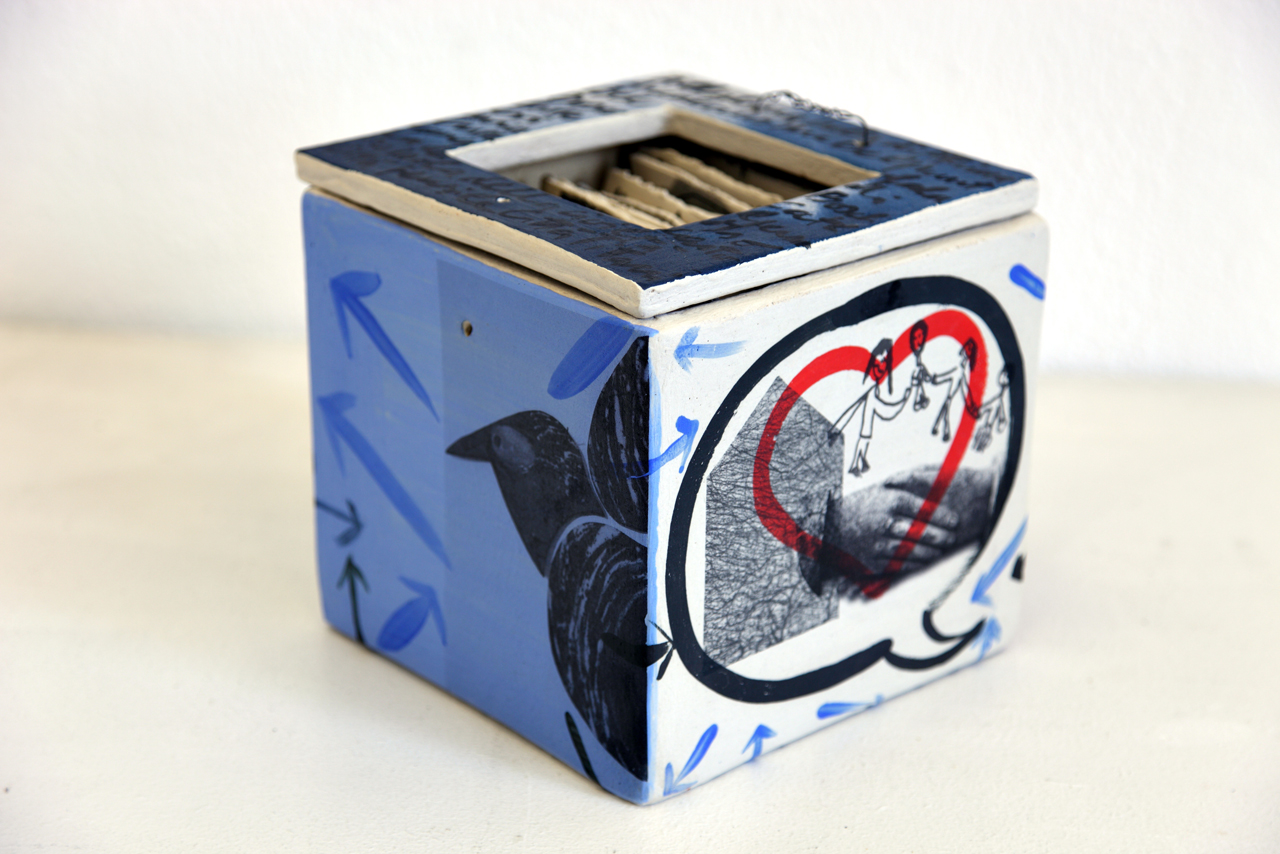

Earth
2015
60x100xh2 cm
Gres, porcelain, slip, ceramic serigraphy
The colours, shadows, lights, that characterize the surface of the earth in different seasonal and environmental situations have been the elements of a photo research that has inspired this work. Other images have been added to these, they are part of the ceramic world. This work is a tribute to the earth that generates ceramics.
In 2015 this work won the mention of the Technical Commission of the Ceramic Museum of Montelupo on the occasion of the Baccio da Montelupo Prize of Montelupo Fiorentino, Italy.


Roots / Wine
2014 - in progress
21x15xh9 cm
Stoneware, slip, glazes, ceramic serigraphy
Many foods are deeply part of the culture of the territory where they were borned: wine is one of them. The wine culture, as so as the ones of bread and oil, are deeply-rooted in the lives of many people.
This work is in the Permanent Collection Vaselle d’Autore, of the Ceramic Museum of Torgiano, Italy.

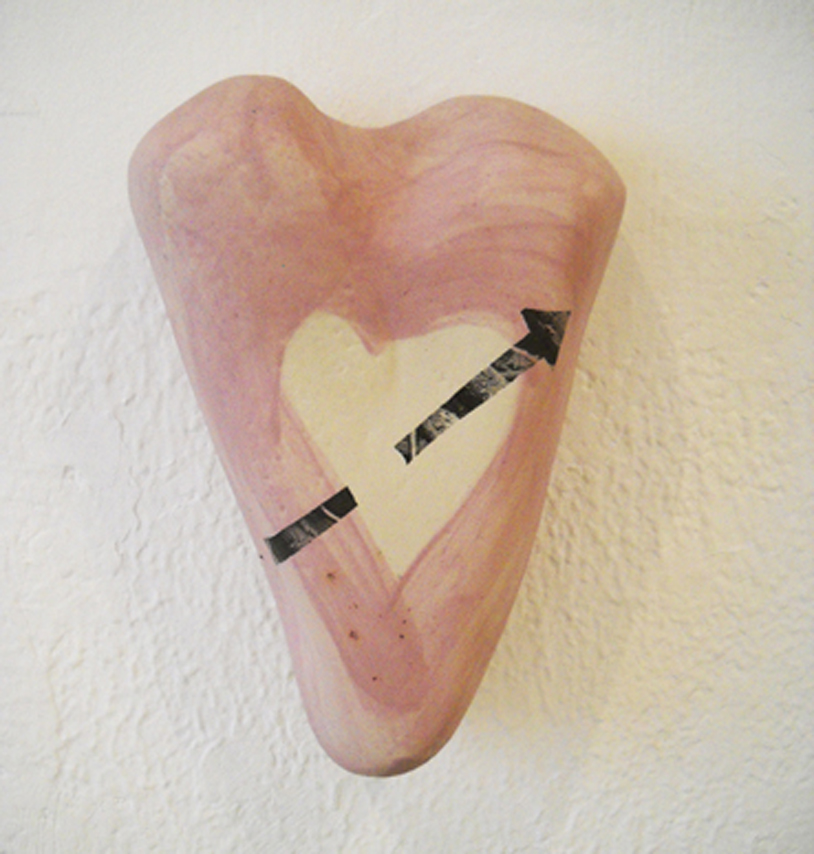
Roots / Hearts
2014
10x33xh29 cm
8x27xh27 cm
7x20xh23 cm
Stoneware, slip, ceramic serigraphy
Affection is among the elements that most connects individuals to a territory, and it can determine important choices of life.
Roots/Hearts has been selected in some exhibition in Italy and abroad.

Waves on the Future
2014
Each wave measures 14x7xh6 cm
Stoneware, slip
The need of food, job, affection, as well as the escape from wars and all kinds of oppressions, are the elements that push people to leave. The dreams, desires, objectives of people are written on the sea waves and the movement of the waves is like the new energy that the emigrants bring to the countries where they decide to stop.
In 2014 this work was selected at the IVth Triennial of Kecskemét (Hungary).
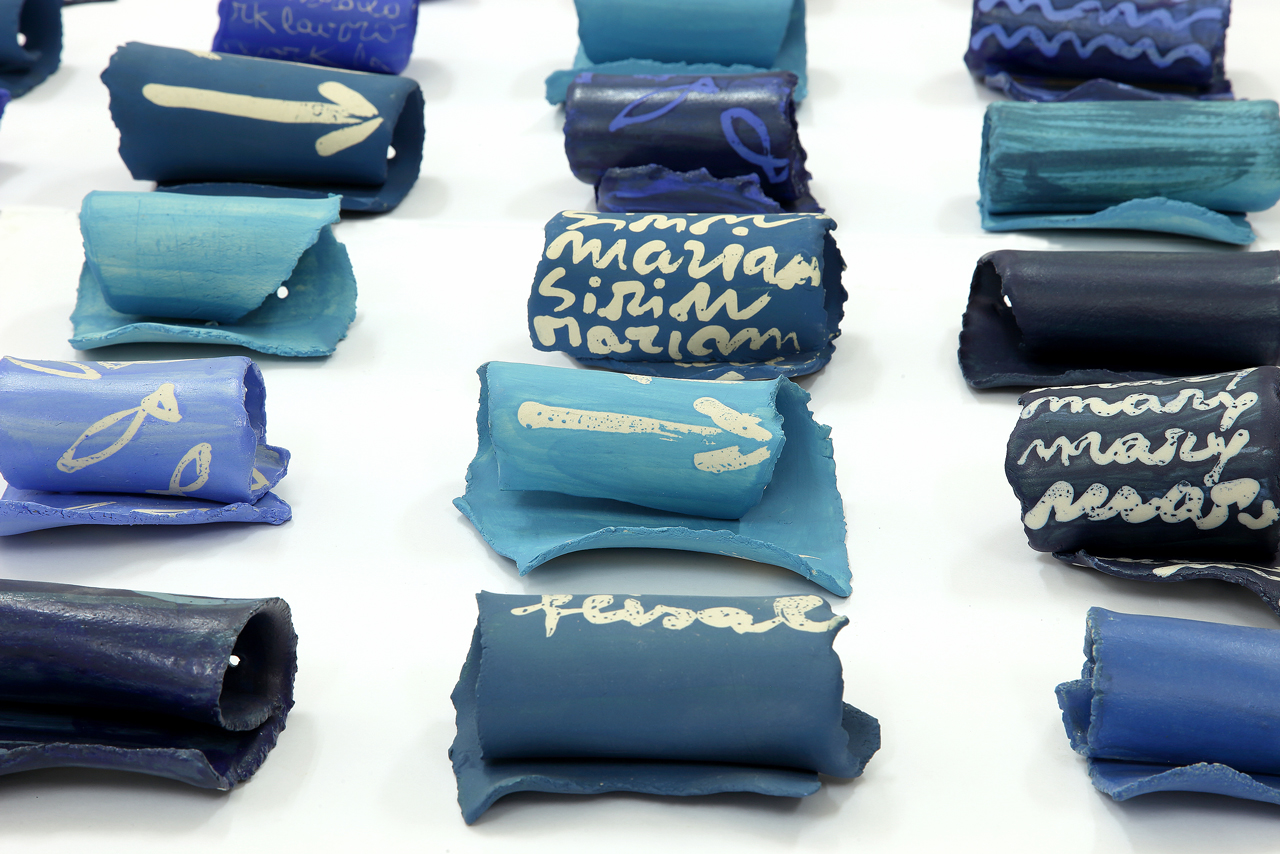
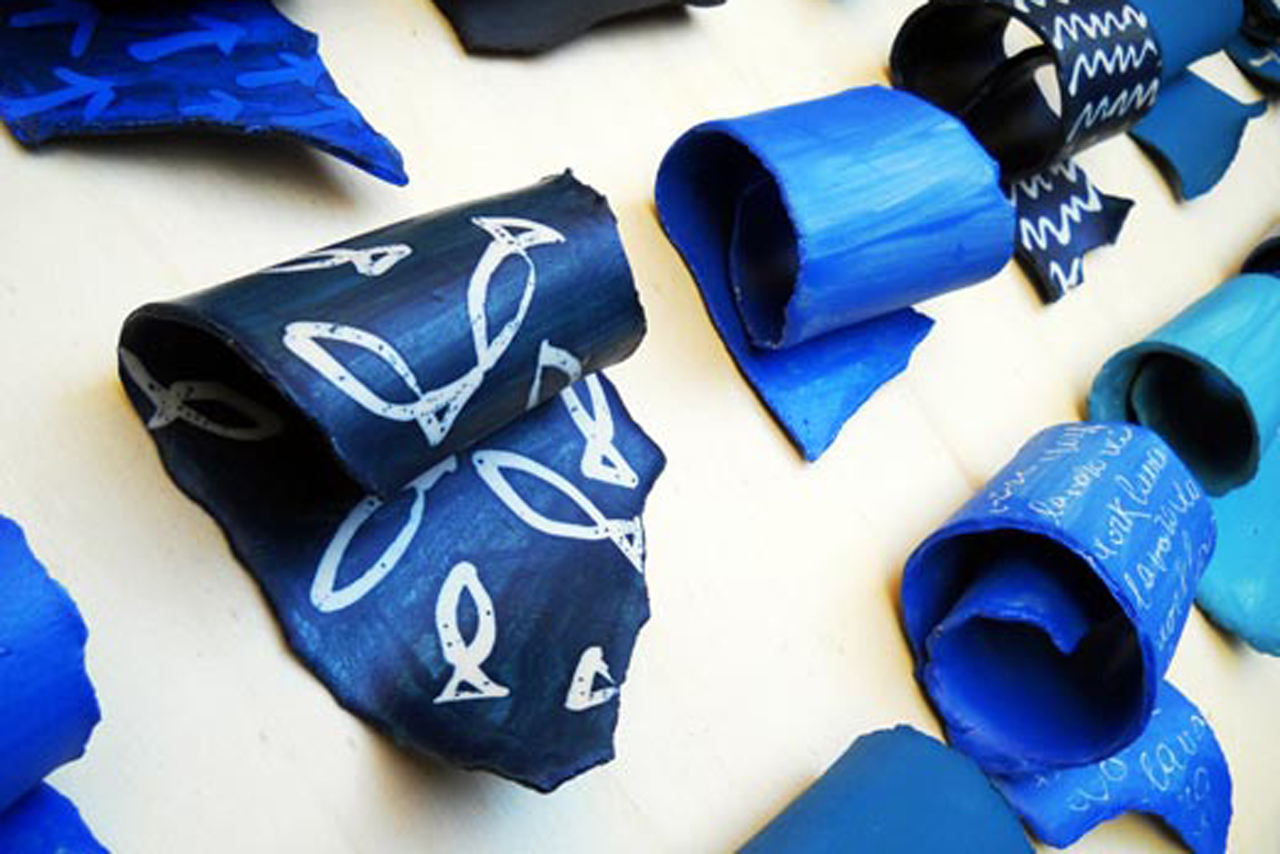

Each Plant has a Different Root
2014
135x218xh5 cm
Porcelain, slip, oxides, ceramic serigraphy
Each plant has a different root as regards its form, dimension, colour. Even the kind of earth, in which the root develops, changes the course of this vegetable element. Home, job, affection form the roots of human beings, but all that people consider as roots change and become the fruit of the transformation of societies over time.
In 2014 this work was selected at the 59th International Contest of Contemporary Artistic Ceramic of Faenza (Italy).


Roots
2013
80x143xh3 cm
Porcelain, slip, ceramic serigraphy
This work was born from a photographic research on roots. The innumerable forms that roots have in the vegetable world are the metaphor of the human lives that have taken roots in many and different cultures.
In 2013 this work won the Best Ceramic Decoration Prize at the International Contest China Kaolin Gran Prix of Jingdezhen, China.


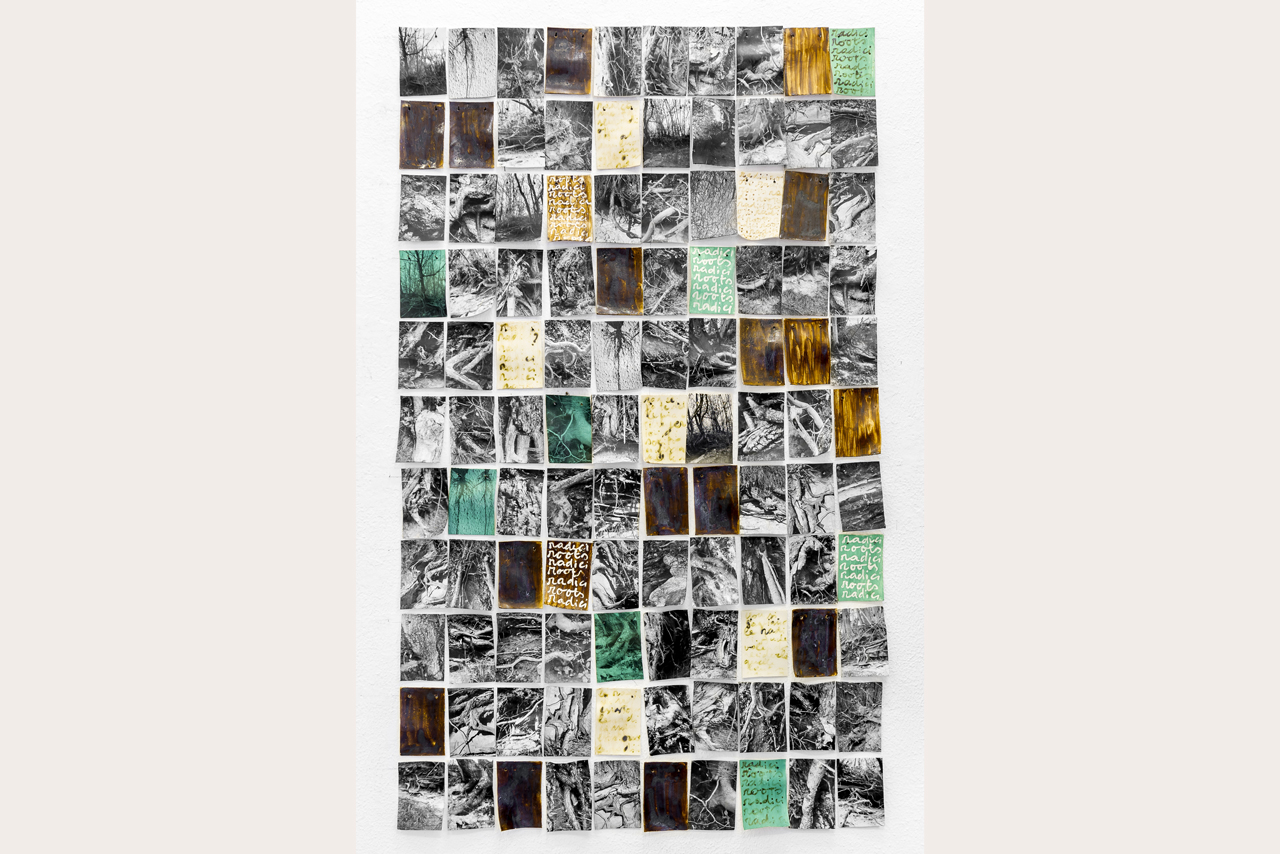
Roots / Home
2013 - in progress
21x15xh9 cm
Stoneware, slip, ceramic serigraphy
The home, in its material and symbolic meaning, is the symbol of rootedness and belonging to a territory.



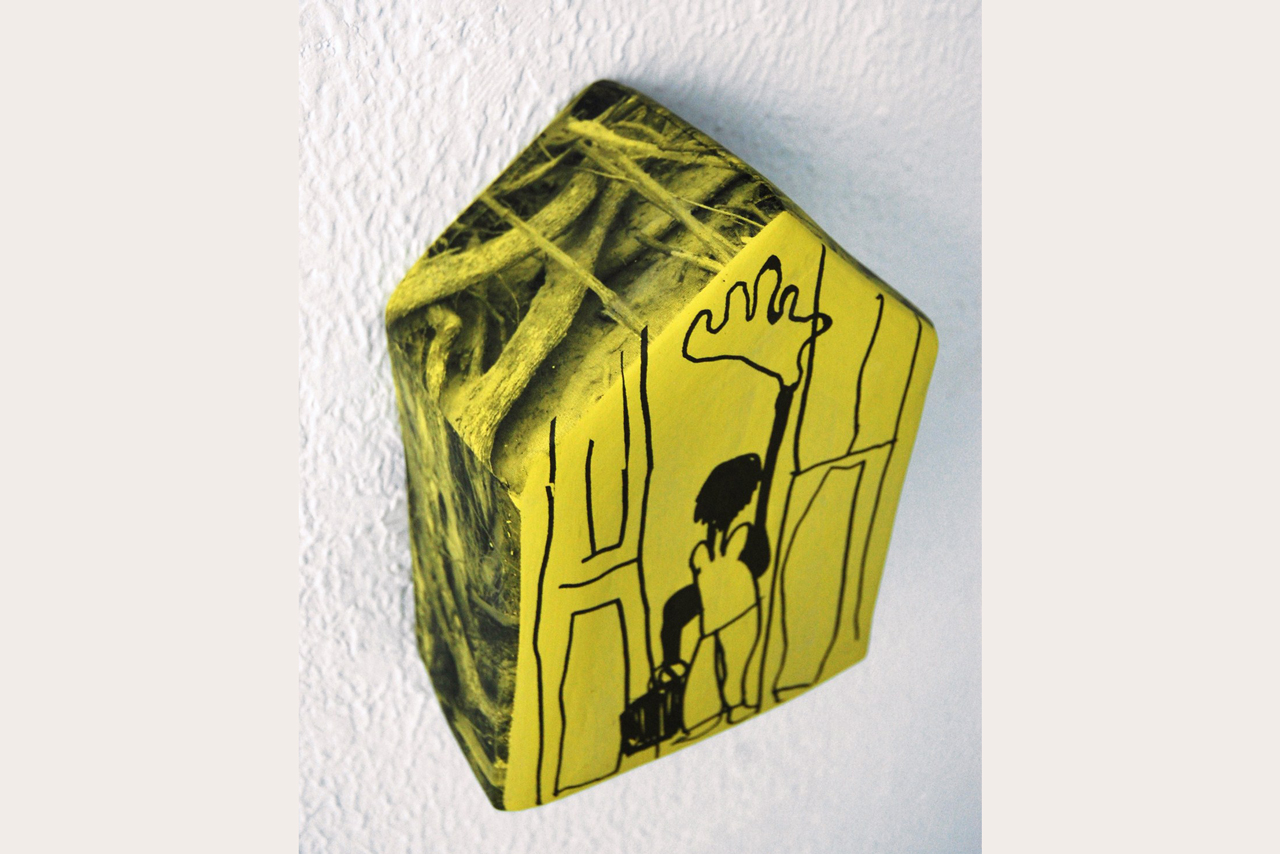
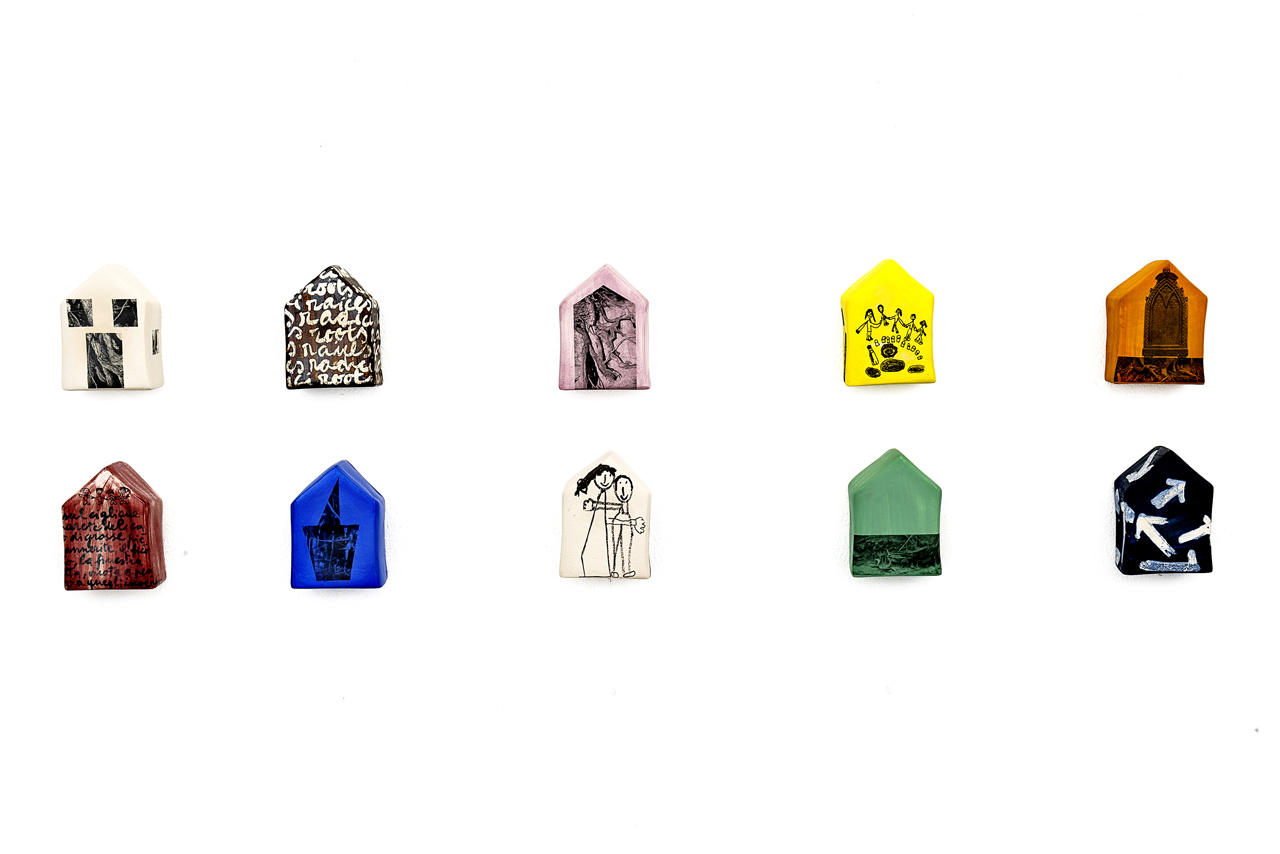
Radici / Culture
2013 – in progress
110x200xh9 cm
Stoneware, slip, ceramic serigraphy
The culture, in its widest meaning, is one of the elements that constitute the roots of the individual.
In 2013 this work was selected at the XIth International Ceramic Contest of Manises (Spain).
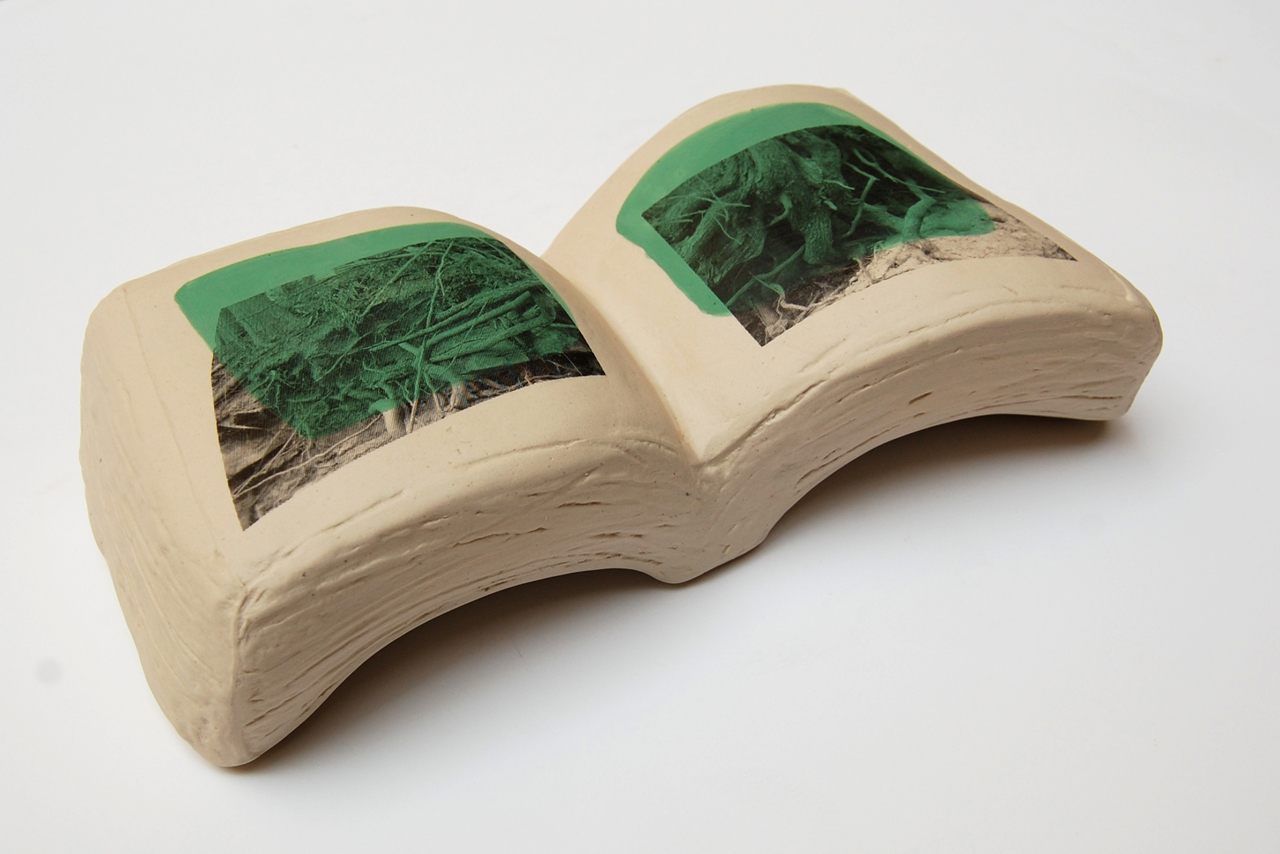


Roots / Bread
2013
110x180xh14 cm
Stoneware, slip, ceramic serigraphy, iron
Bread is a food present in all the societies since the old times. For this reason, it like other foods, is deep-rooted in the culture and life of individuals.



Public Diary, Argillà Faenza
2012
Each slab measures 20x30xh1 cm
Stoneware, slip, ceramic serigraphy
The city of Faenza is the symbol of all that evokes ceramics, not only in Italy but even in the world. In 2012 people, who stayed in Faenza on the occasion of the manifestation Argillà, were photographed together with one of their beloved ceramic objects. The portrait of these people constitute the theme of an exhibition that took place during Argillà 2014.
In 2014 this work was shown at the Theatre Masini of Faenza (Italy).
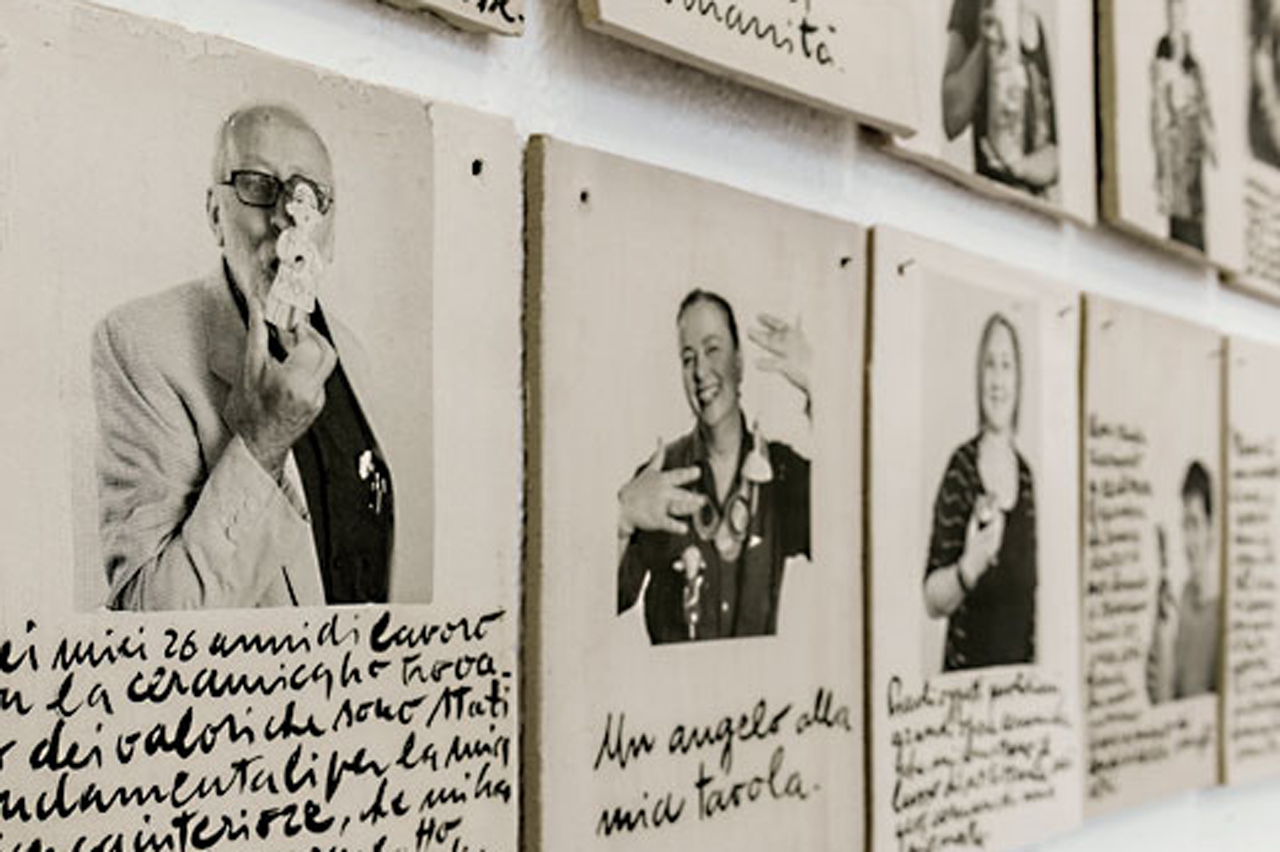

Zodiac
2012
Each slab measures 30x20xh5 cm
Stoneware, slip, glazes
The stars have always been a source of observation and scientific study but, in the same time, they have stimulated the popular imagination that has created tales and myths about them. For example, in many cultures special meanings are attributed to the position of the stars when a person is born. This work is accompanied by some descriptions that ironically alternate the scientific language with the language coming from the popular tradition.
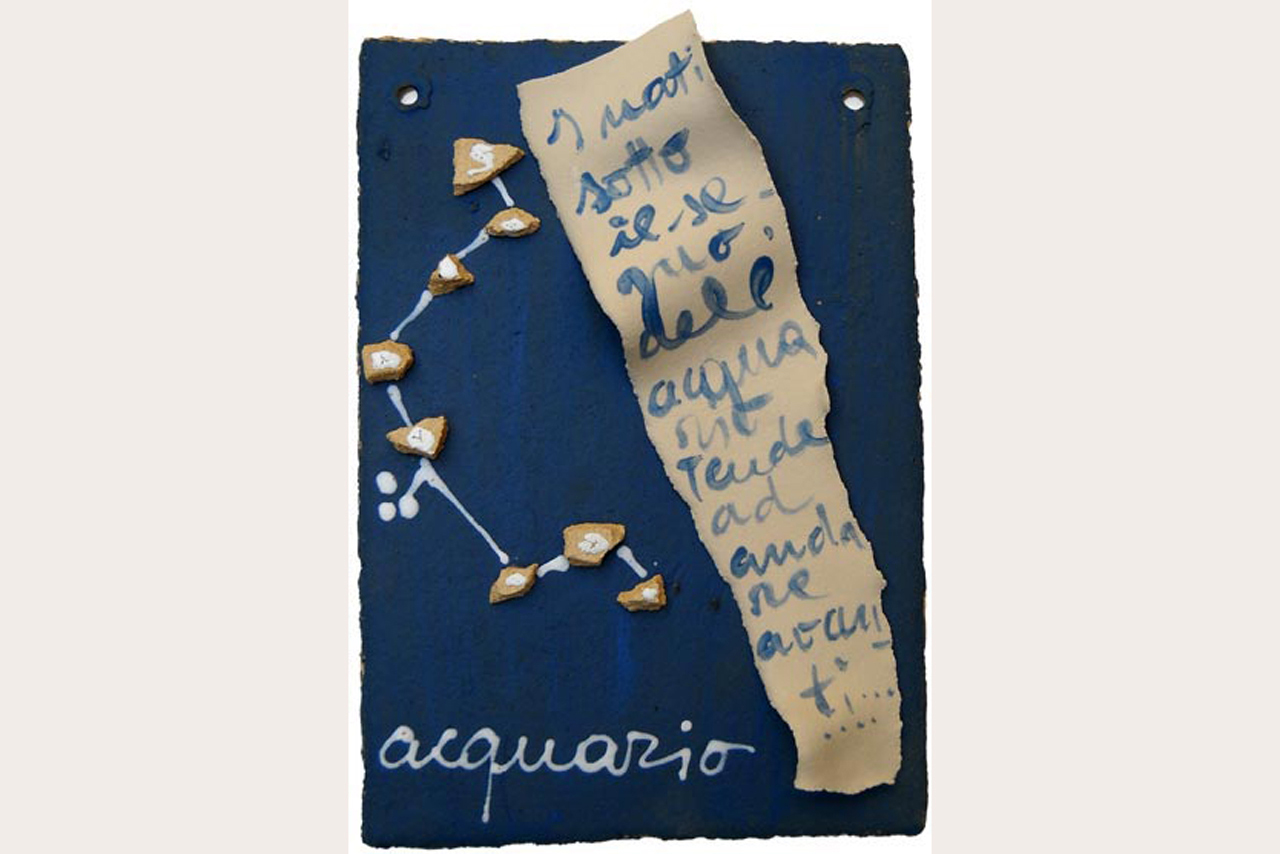
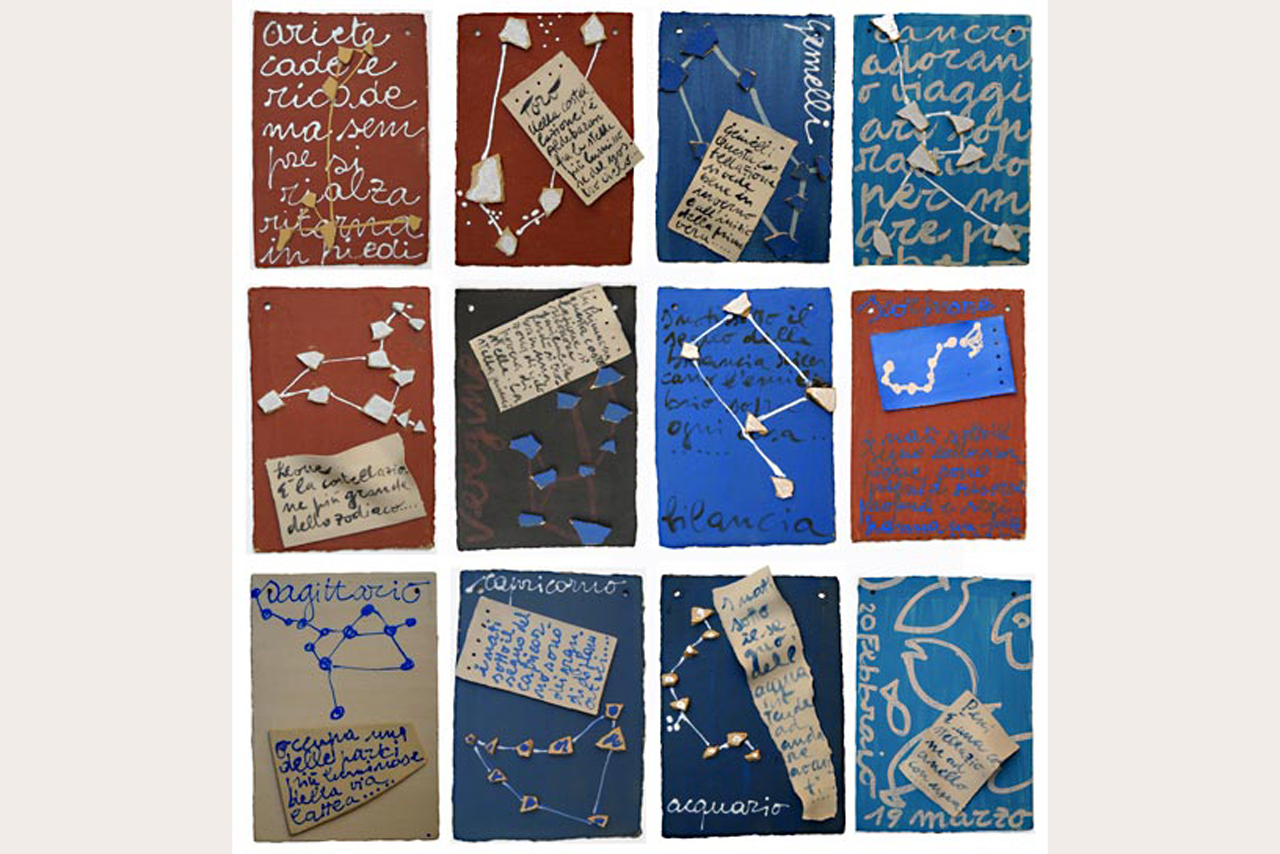
Public Diary in Saint-Quentin-la-Poterie
2011
200x170xh 2 cm
Stoneware, slip, ceramic serigraphy
For many years the production of utilitarian ceramics has characterized the village of Saint-Quentin-la-Poterie, in the south of France. Then the activities connected with ceramics have gradually disappeared. But many ceramists have started a new ceramic production from the eighties. Public Diary in Saint-Quentin-la-Poterie documents this rebirth, through the portraits and testimonies of the people who have again opened their studios and shops.
This work was shown in different manifestations:
in 2011 at the Ceramic Festival of Saint-Quentin-la-Poterie, France.
In 2012 at Argillà, Faenza, Italy
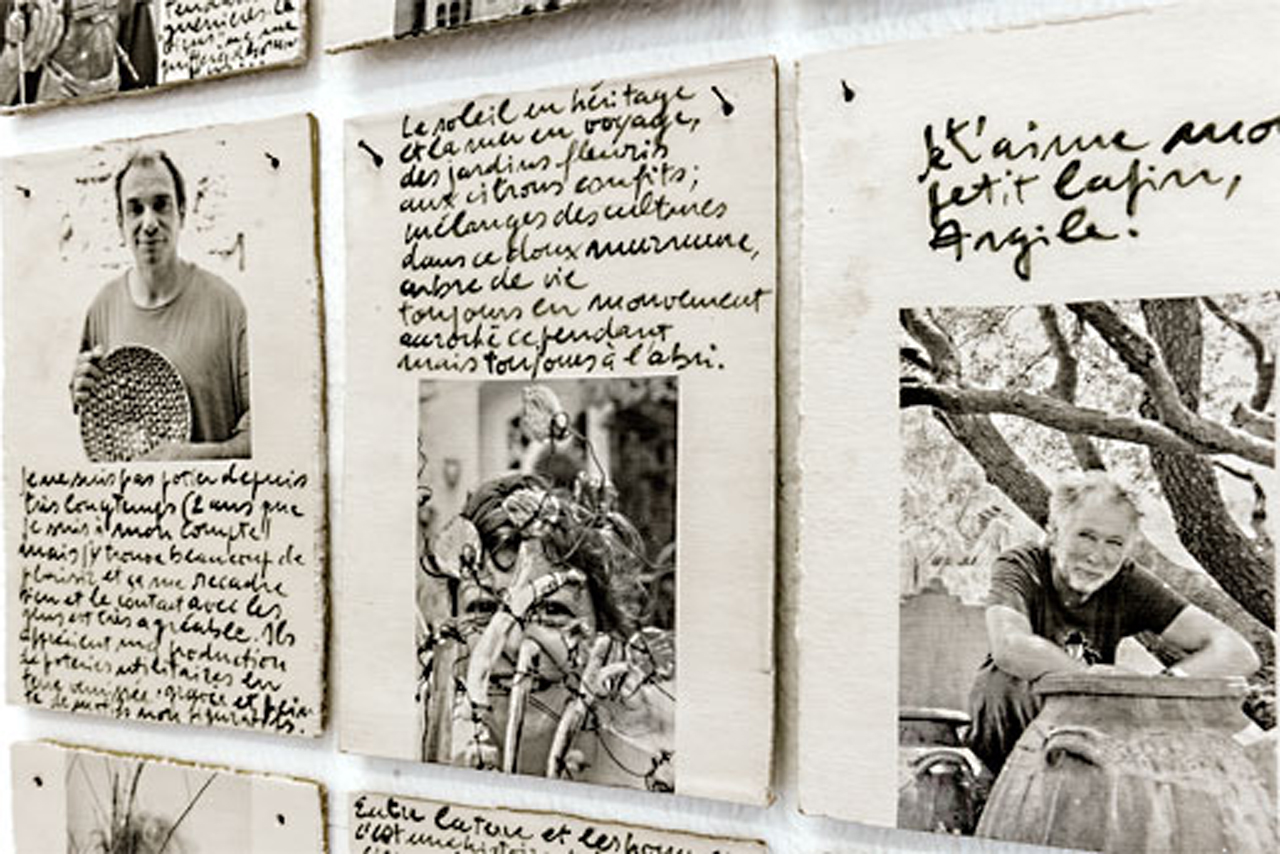
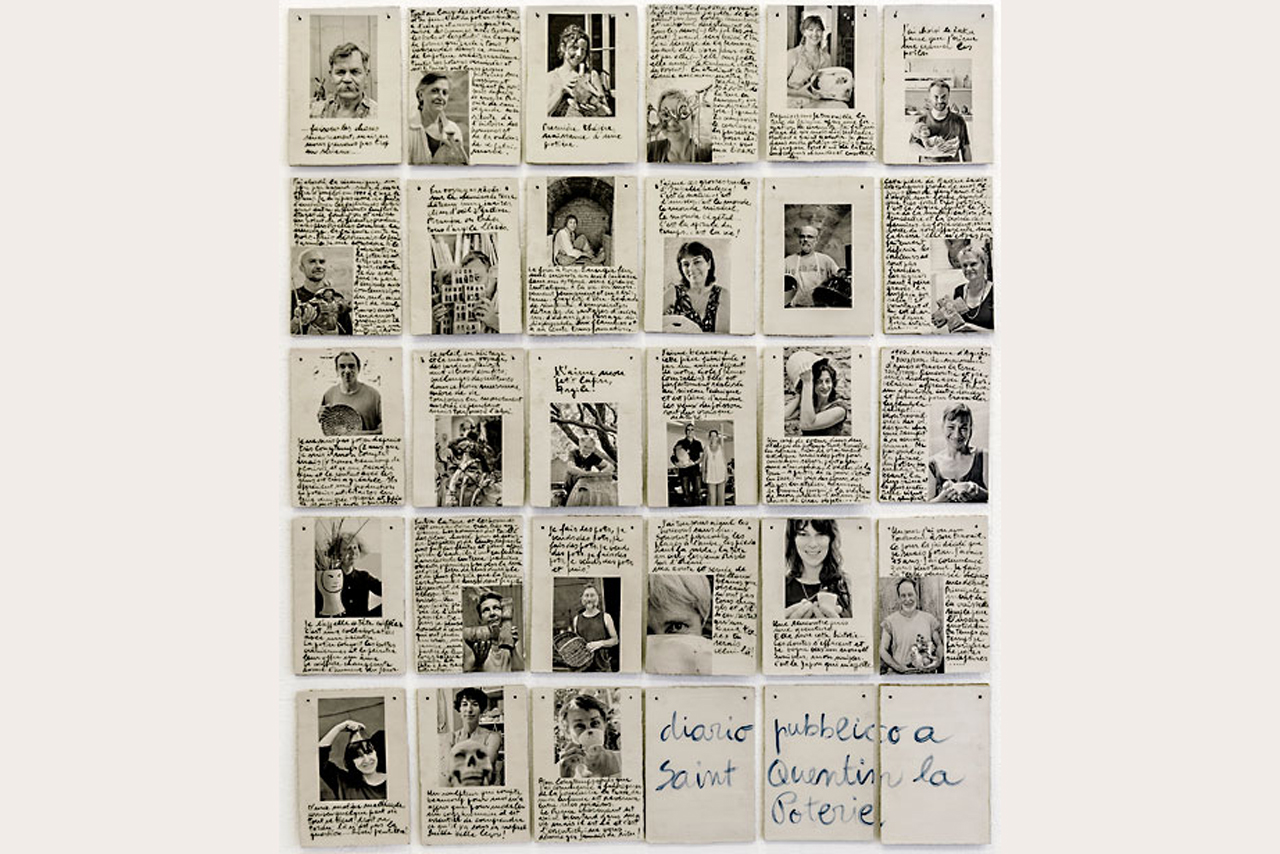
One Year, One Month
2011
255x265xh5 cm
Stoneware, slip, ceramic serigraphy
This work is composed of three hundred and ninety stoneware slabs. Each slab corresponds to one of the days that form a month. The months follow one another from January to December, but this calendar has a peculiarity: the months are not part of the same year but they have been chosen among the ones have represented some significant moments of my life. So they form a sort of personal calendar.
In 2011 this work was selected at the Pavilion of Lombardia of the Biennial of Venice, Mantova (Italy).
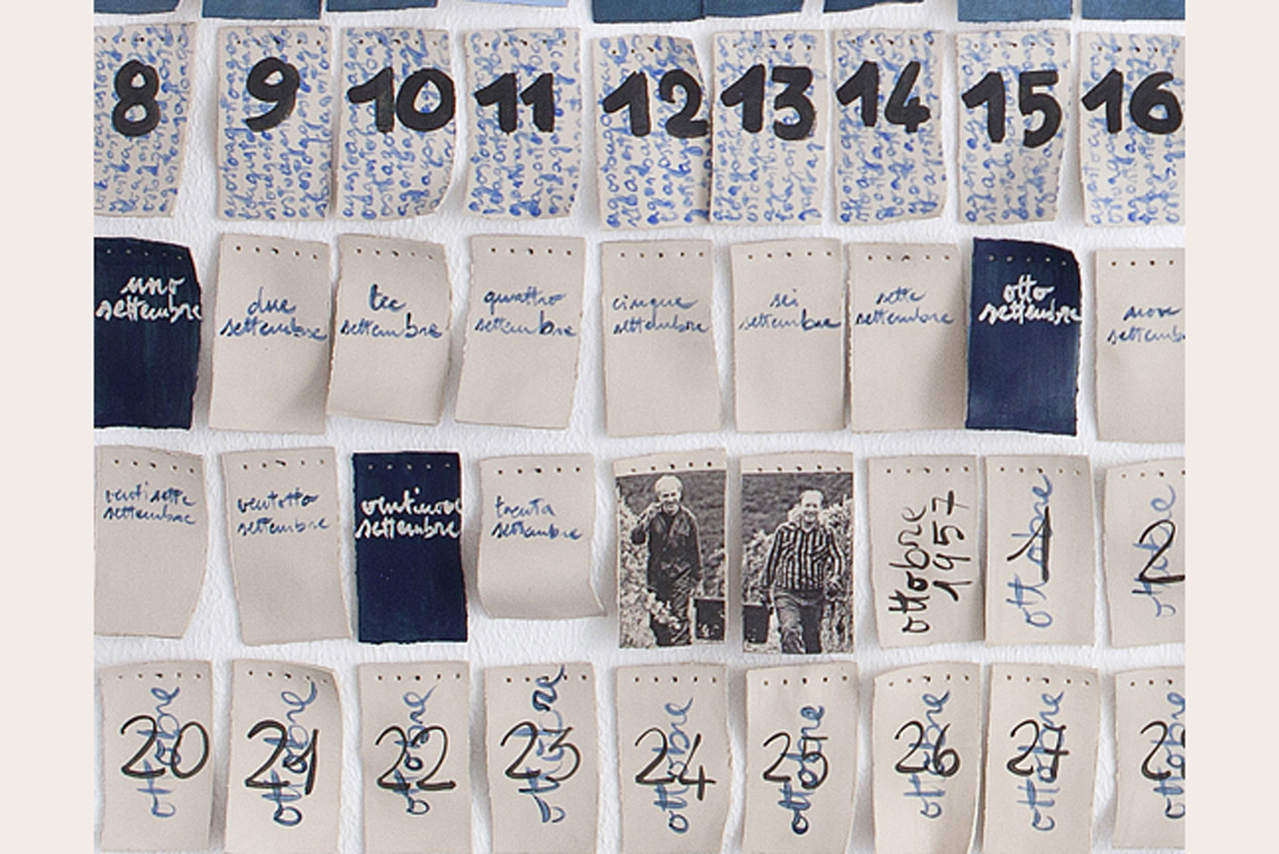
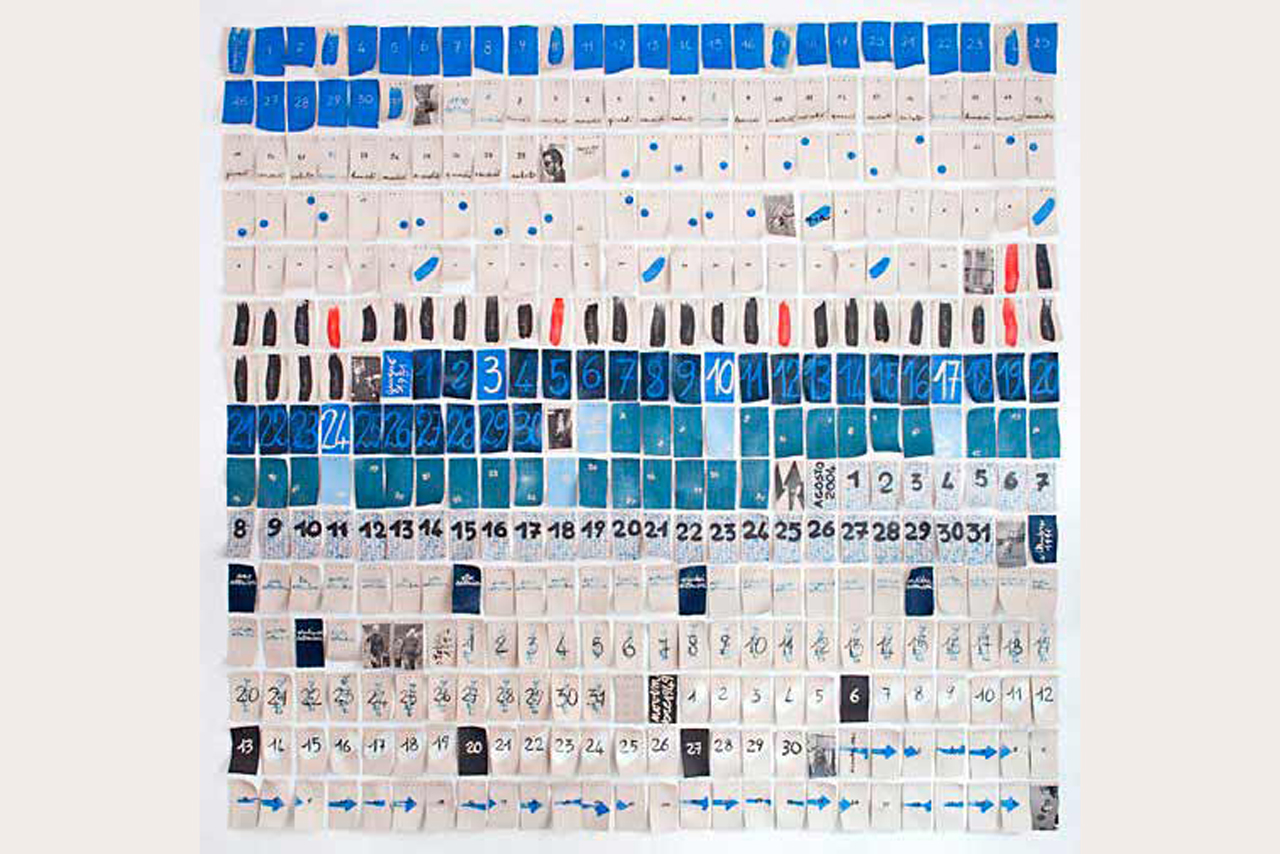
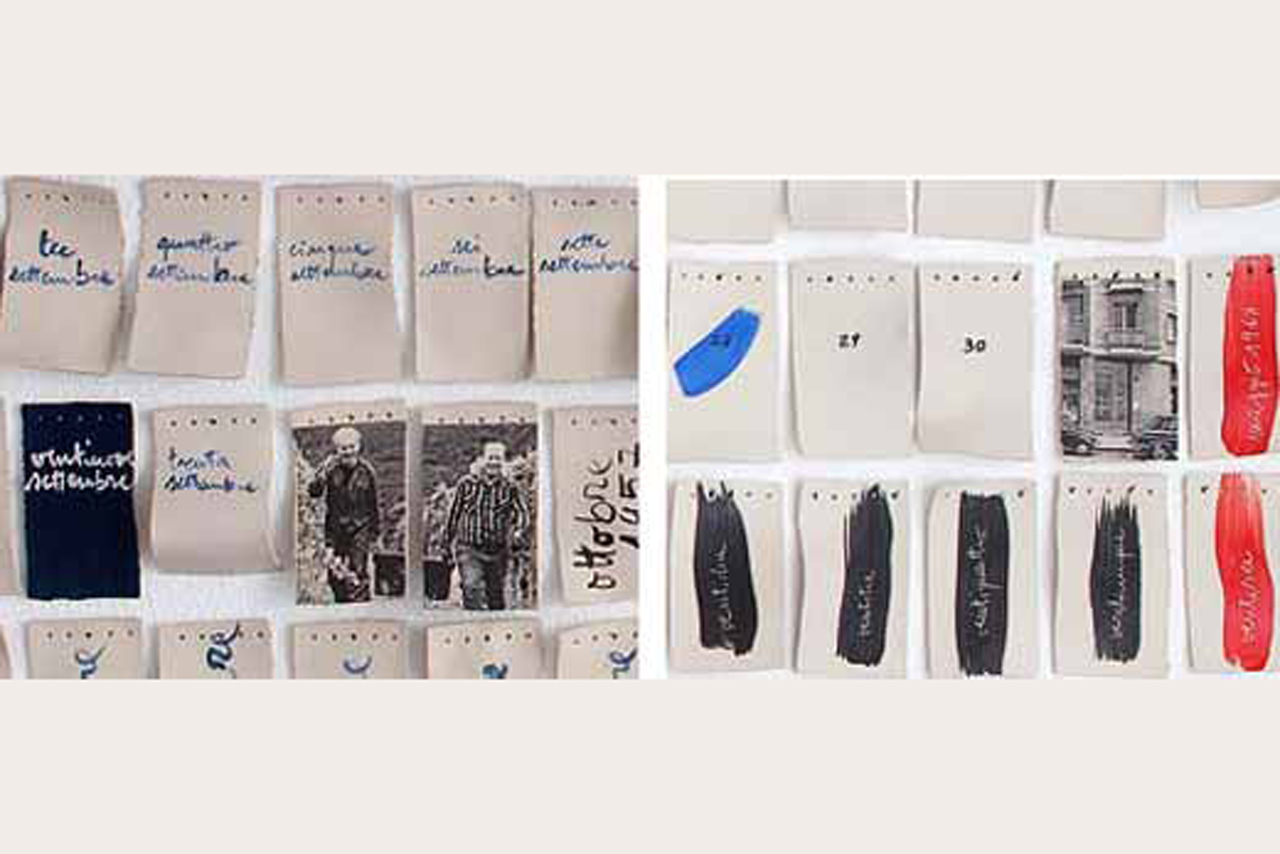
October 1957
2011
70x90xh2 cm
Stoneware, slip, ceramic serigraphy
The sheets of the calendar refer to the month of October of the year 1957. In this year I started my educational way. At the beginning of this way I couldn’t imagine that writing, both from the point of view of its form and from the point of view of its meaning, would have been one of the most recurrent elements in my artistic work.
In 2011 this work was elected at the International Triennial of Kecskemét, Hungary.




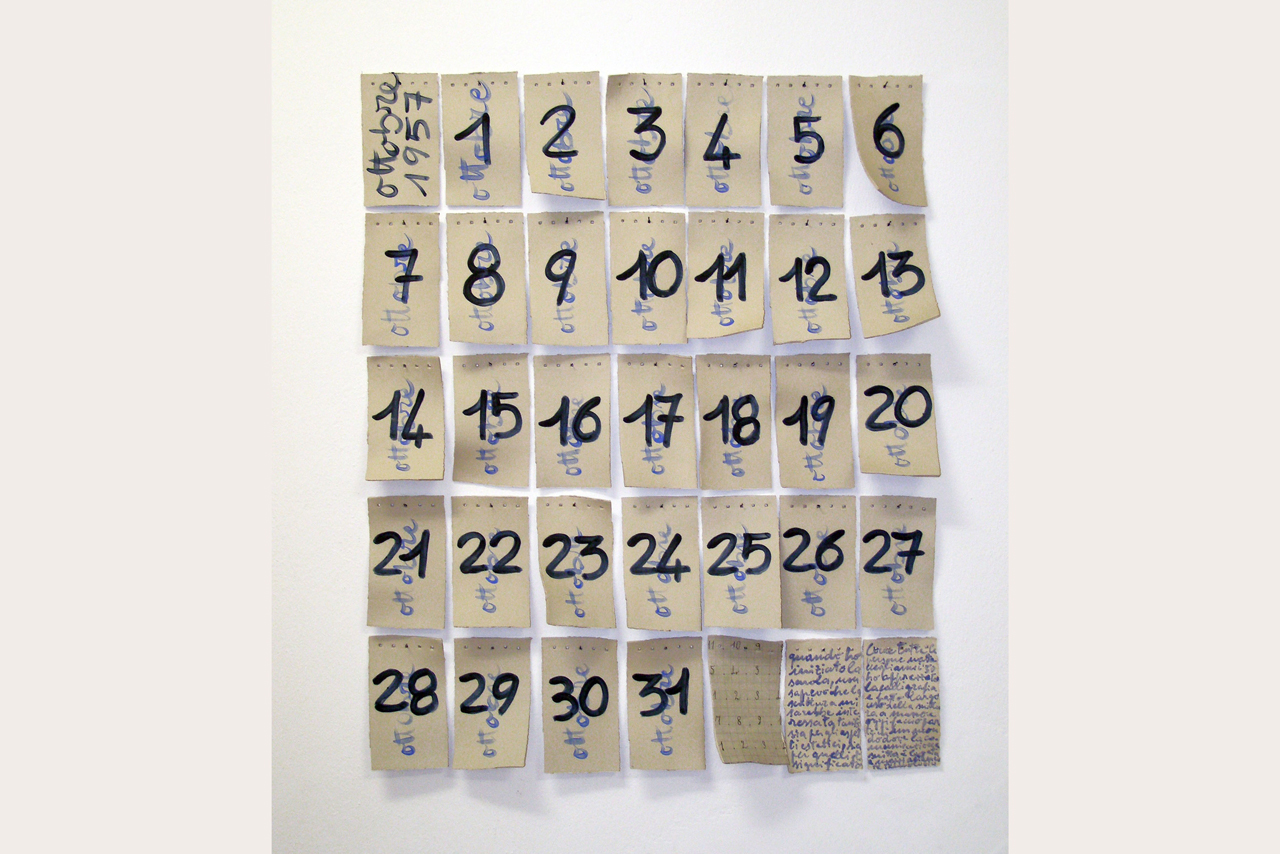
February 1970
2011
Diameter 150xh8 cm
Stoneware, slip, ceramic serigraphy, cardboard boxes
There are events that mark the life of people significantly. In this work the calendar fixes in time the image of people and the memory of events that have been determinant for my life. The arrangement of the calendar sheets as a spiral evokes the infinite flow of time.
In 2011 this work was selected at the International Ceramic Contest of Aveiro, Portugal.


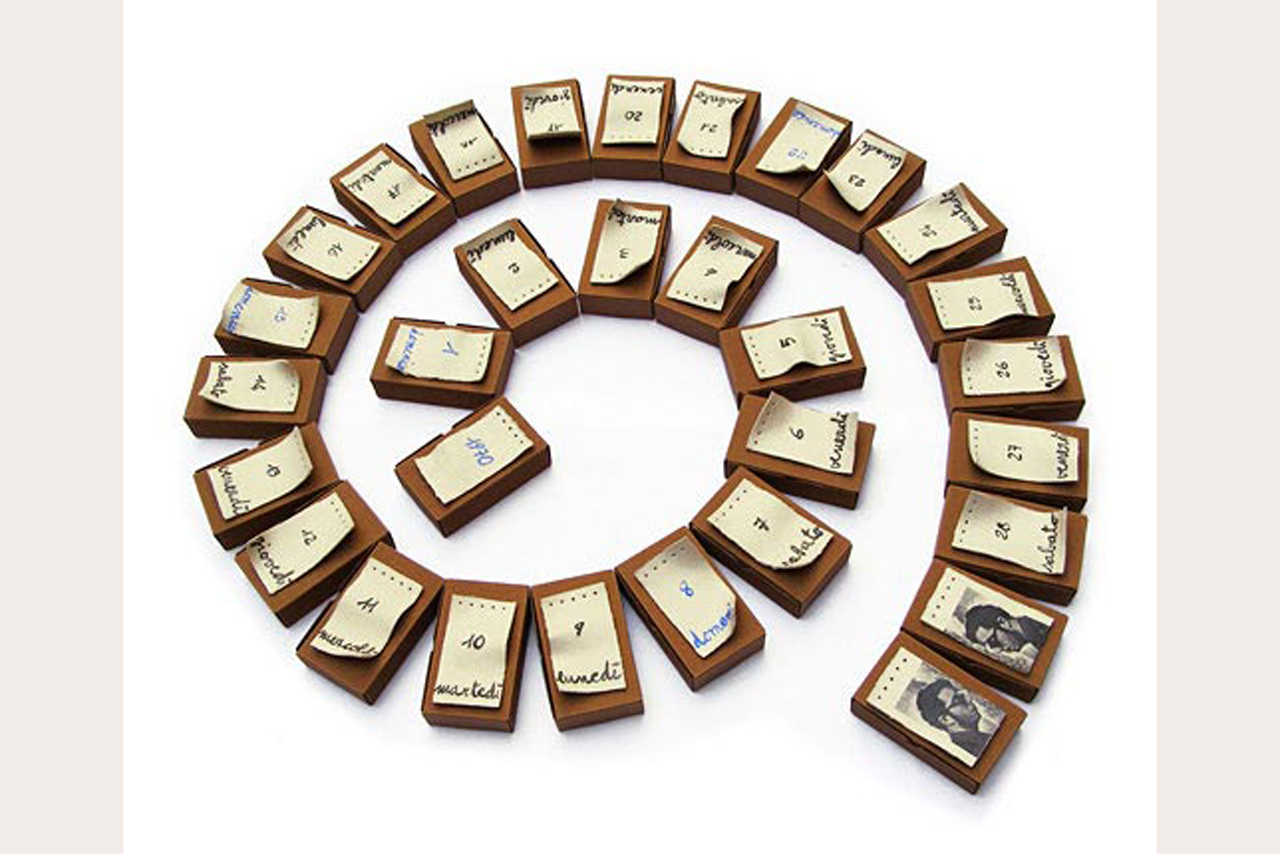
Thirty Years
2011
Each slab measures 9x16xh5 cm
Stoneware, slip, ceramic serigraphy
This installation was created on occasion of the thirtieth anniversary of the foundation of my ceramic studio, which took place in December 1981. Each sheet of the calendar represents one year of life of my studio.
In 2013 this work was selected at the International Ceramic Contest of Faenza, Italy.




From A to Z
2010
112x147xh4 cm
Stoneware, slip, oxides
The names of the materials used in the ceramic work process are shown in alphabetical order on sixty-three stoneware slabs.

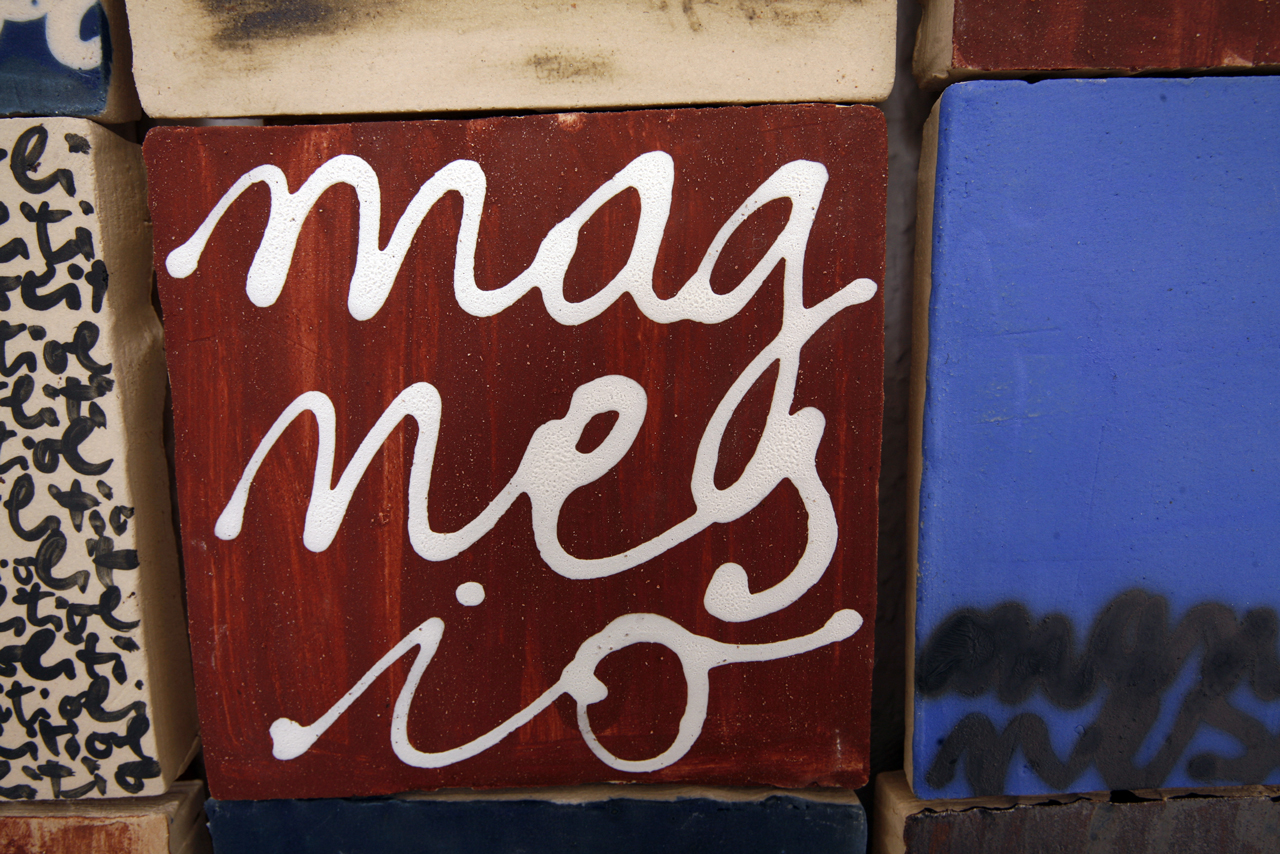
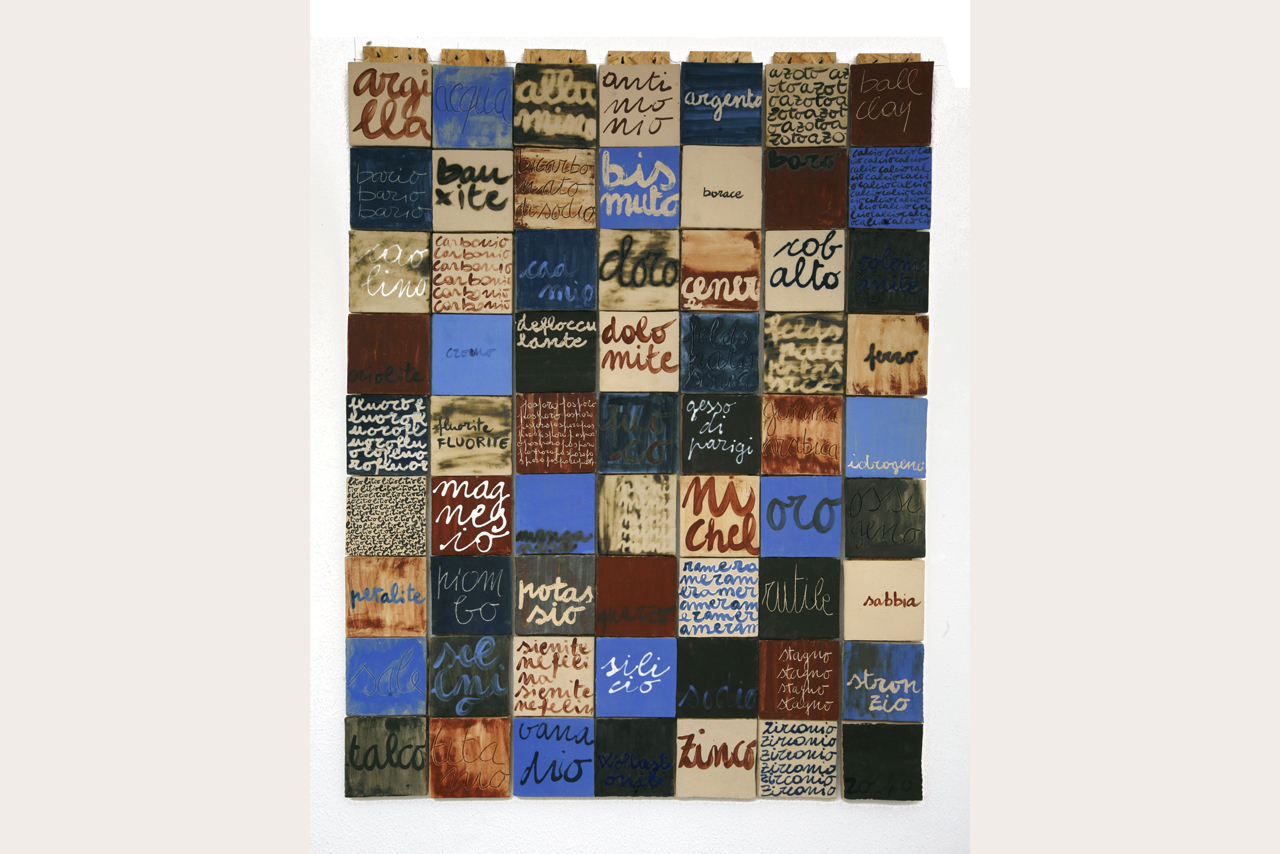
Public Diary
2010 – in progress
203x216xh2 cm
Stoneware, slip, ceramic serigraphy
Diario pubblico
2010 – in progress
203x216xh2 cm
Gres, ingobbi, serigrafia ceramica
In Public Diary sixty-four people have narrated something of themselves and one of their beloved ceramic objects. This work is a narration that speaks of the relationship between people and objects, between individual and community, between the human being and passing time.
In 2010 this work was selected at the International Ceramic Contest of L’Alcora (Spain).



Six Months of My Life
2010
170x200xh5 cm
Stoneware, slip, oxides, ceramic serigraphy
The personal perception of time doesn’t always agree with the official passage of time. In the personal calendar, the hours, months and years acquire particular meanings, both as regards the emotional impact that is attributed to them and as regards the perception of their duration. In this work six months of my life, that have been particularly significant for me, have been represented.
In 2010 this work was selected at the 10th International Ceramic Biennial of Manises (Spain).

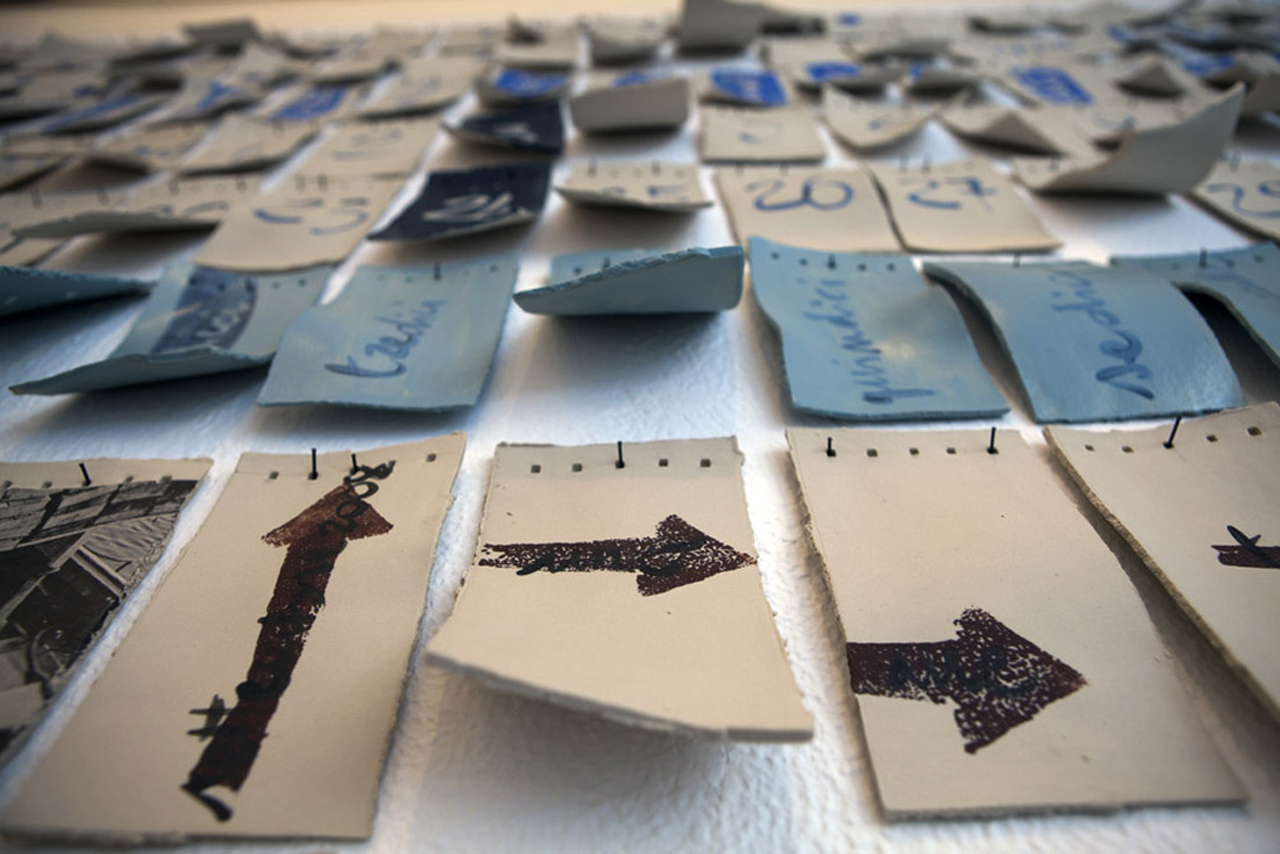
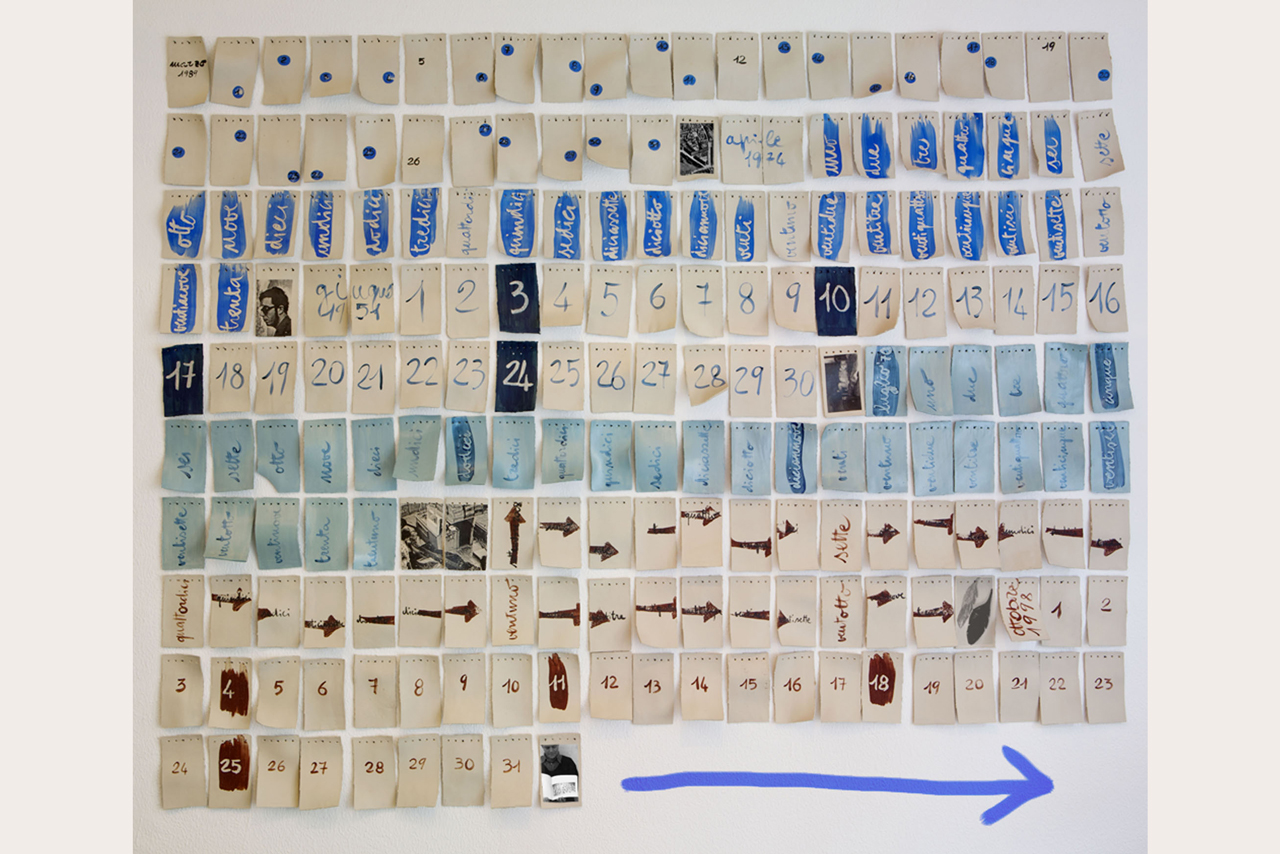
Where Are We Going?
2009 – in progress
Different dimensions from 38x20xh36 to 55x33xh65 cm
Stoneware, slip, ceramic serigraphy
Many of the children, who have emigrated from their country of origin or were born in the places where their parents decided to stop, are already part of our society. When these children are adult, the boats will be part of their memories or will be a subject of a tale or a game to play with their own children.
Some of these works were selected in different manifestations:
in 2009 at the Biennial of Kapfenberg, Austria.
In 2009 at the Ceramic Biennial of Aveiro, Portugal.
In 2010 at the International Ceramic Biennial of Marratxì, Spain.

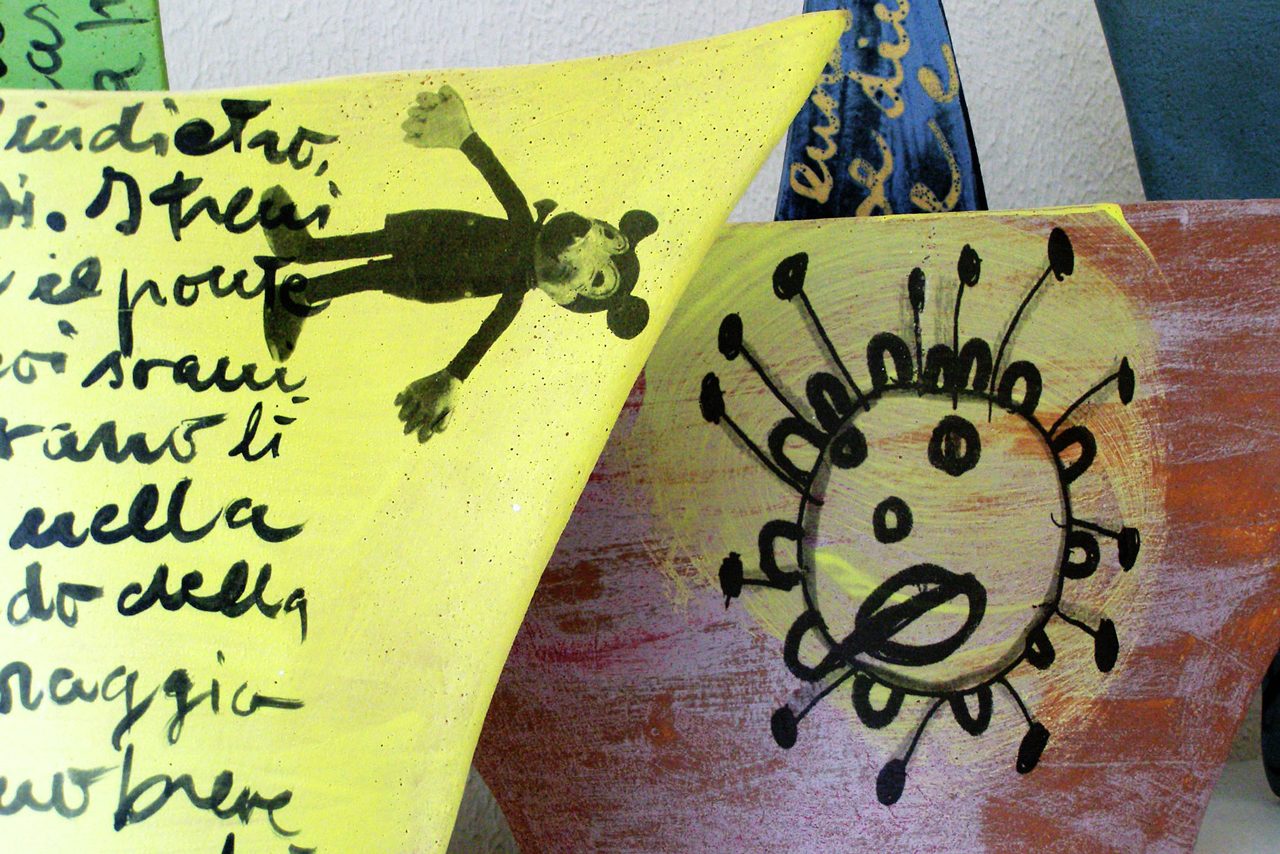
Feathers
2009
200x180xh3 cm
Stoneware, slip, glazes
The feather is very often used to represent lightness and frailty. In reality it is a strong and powerful element so as to constitute a flight apparatus that allows birds to cover long ways. Maybe for this reason, one feather collected on a beach or woods suggests an unknown elsewhere.

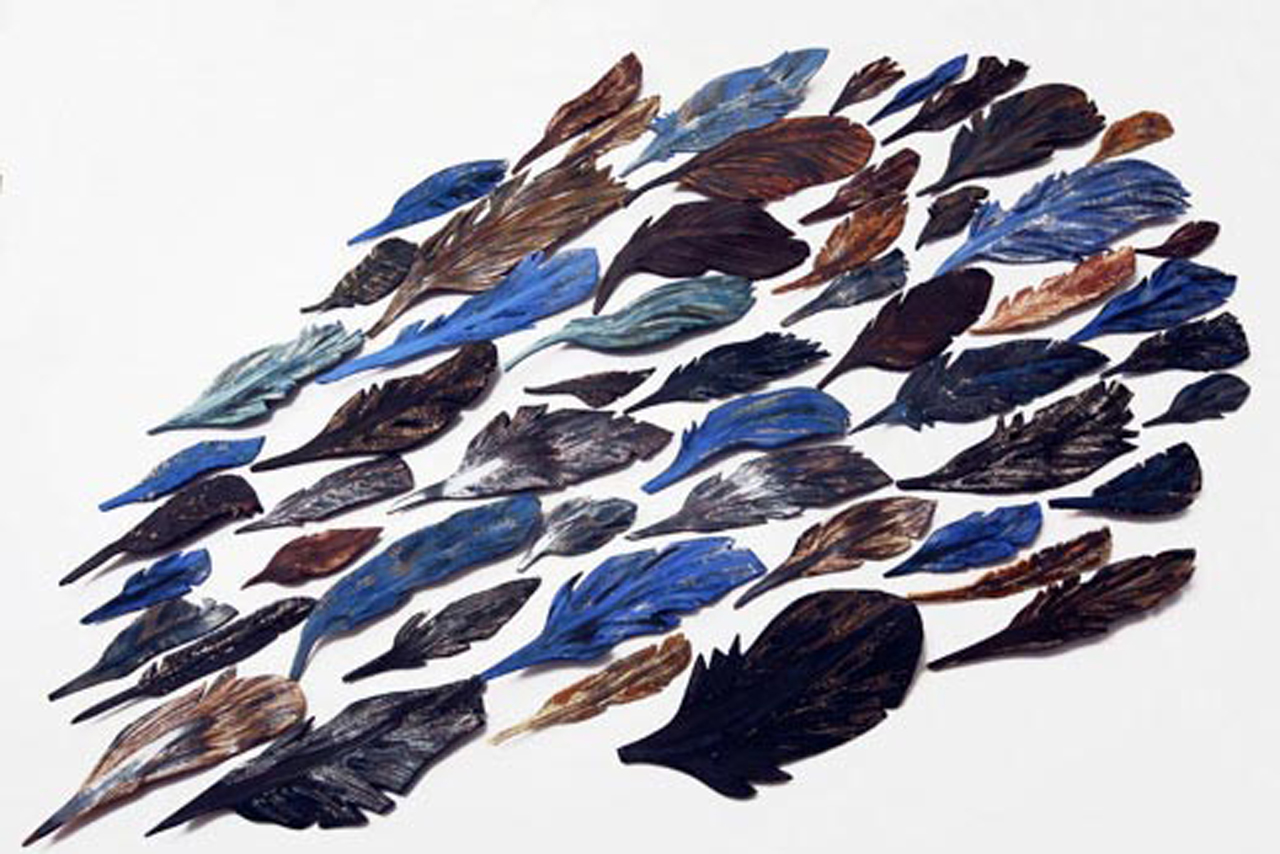
Games of Earth
2009
Different dimensions from diameter 30 to diameter 42 cm
Stoneware, slip
The engravings, drawings, marks, made on the surface of the plastic clay, suggest the games and marks that all of us have made on the sand to leave a sign of our presence.


The Book of Islands
2008
70x30xh8 cm
Stoneware, slip, plastic
The mind of each human being is like a novel that narrates the story of a personal Treasure Island, containing dreamers, aspirations, desires. There are as many Treasure Islands as there are minds that perceive them.
In 2008 this work was selected at the International Ceramic Contest of Marratxì, Spain.
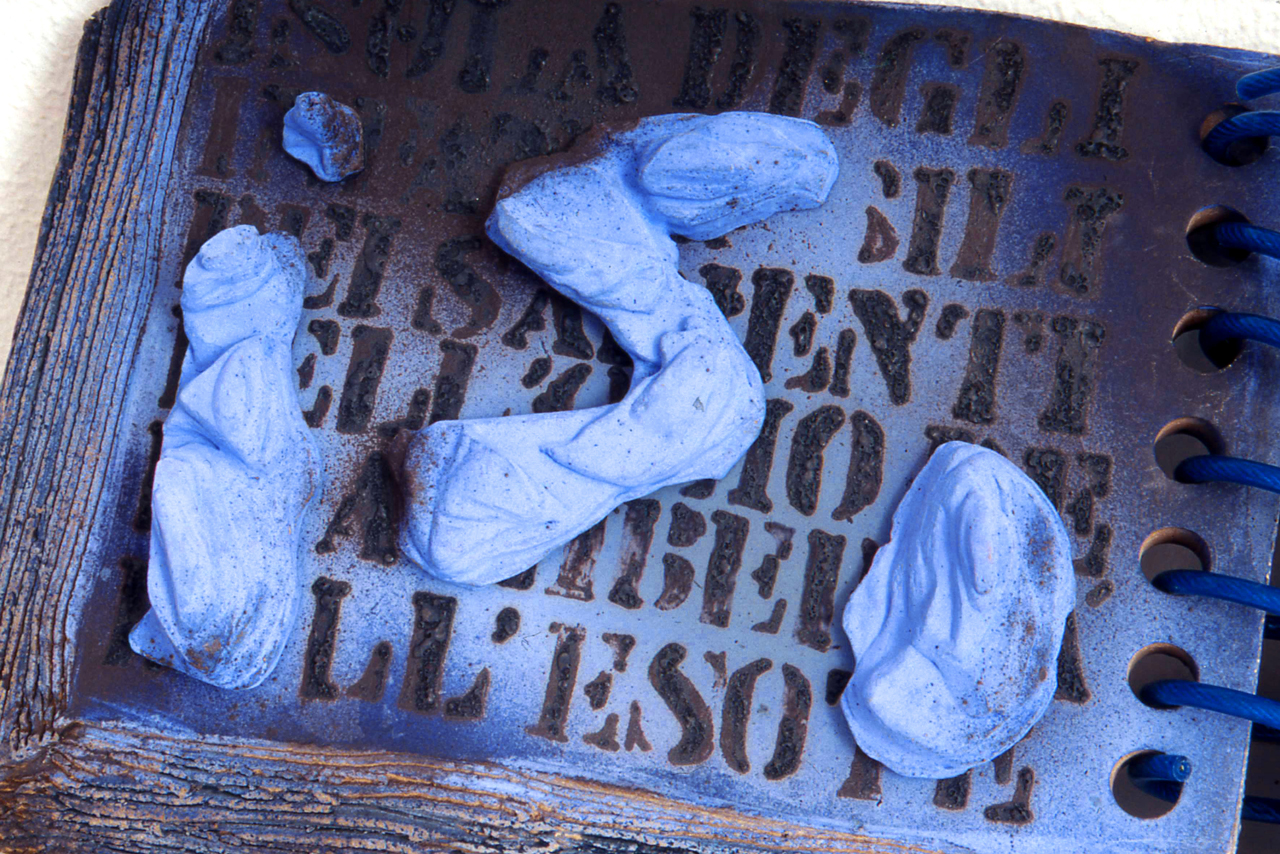

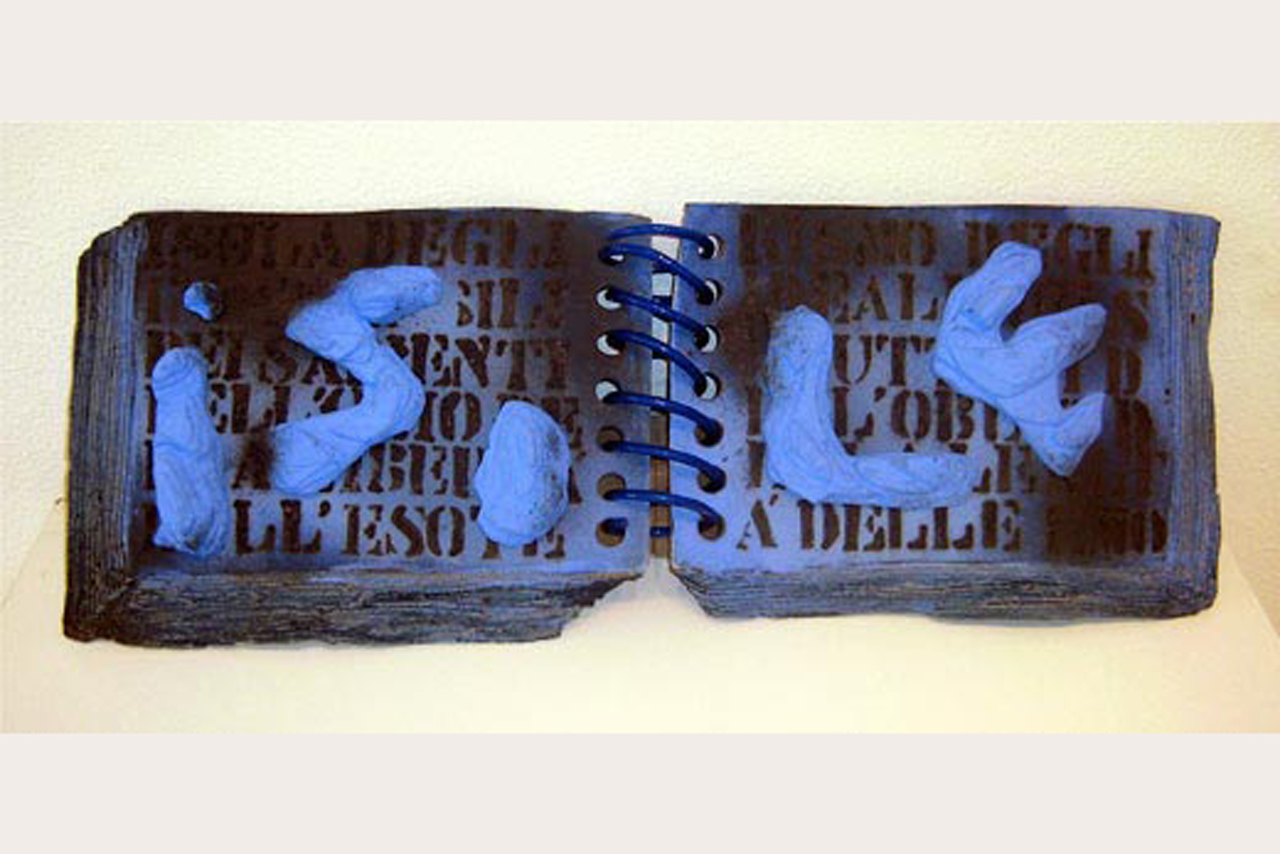
Migrant Children
2008
210x67xh28 cm
Stoneware, majolica, slip, glazes
The presence of children, among migrant people, arouses hard and conflicting emotions. In the
childhood of our children the duckling toy represents an occasion of amusement, while in this installation it symbolizes the travel toward other worlds that the migrant children make.


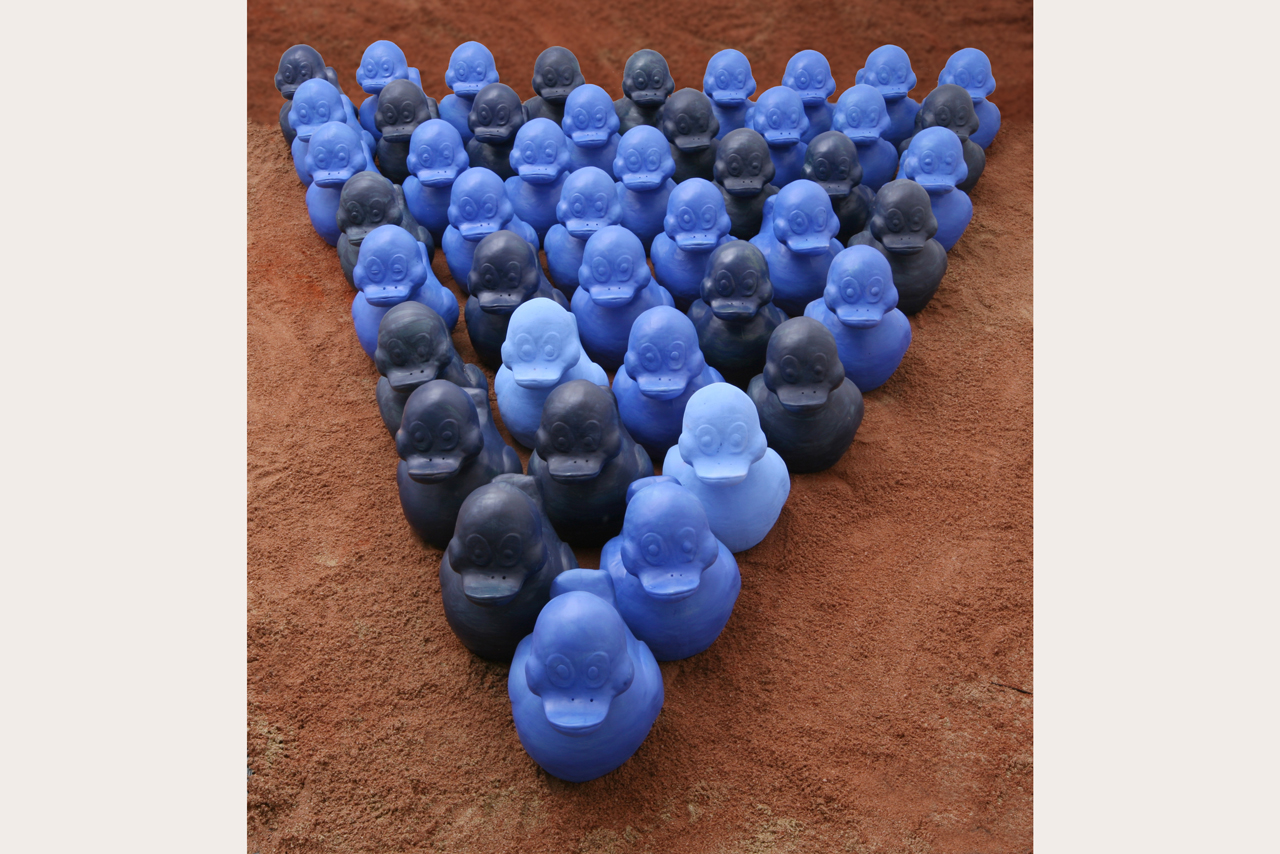
Emigrants
2008
Slabs 200x216xh5 cm The vases have different dimensions
Stoneware, slip, glazes, water
The feathers have been chosen as the symbolic forms to represent the emigrants. The vases, full of water, evoke the concept of home and, in the same time, they symbolize the sea and territories that need to be crossed to reach other worlds.
In 2008 this work was selected at the International Contest Cerco of Saragoza, Spain.
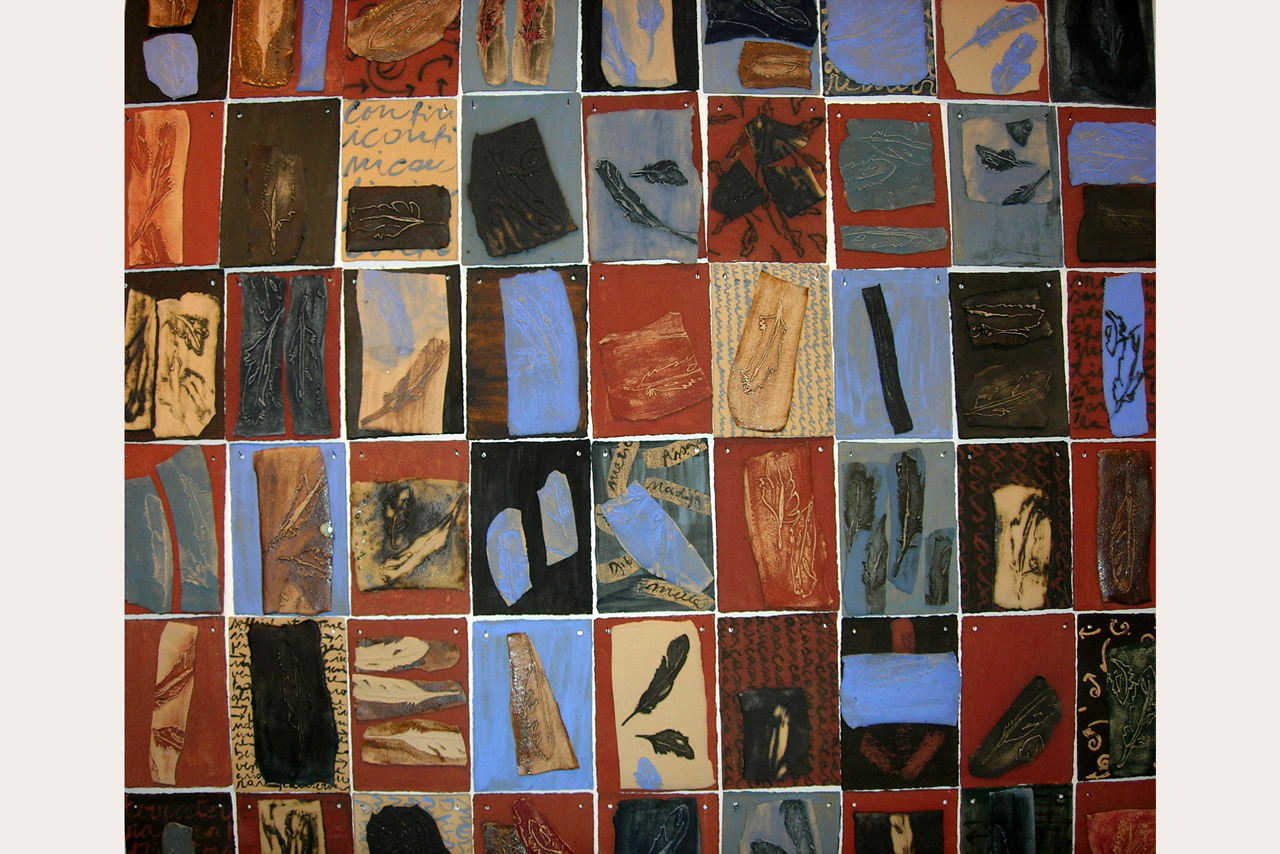
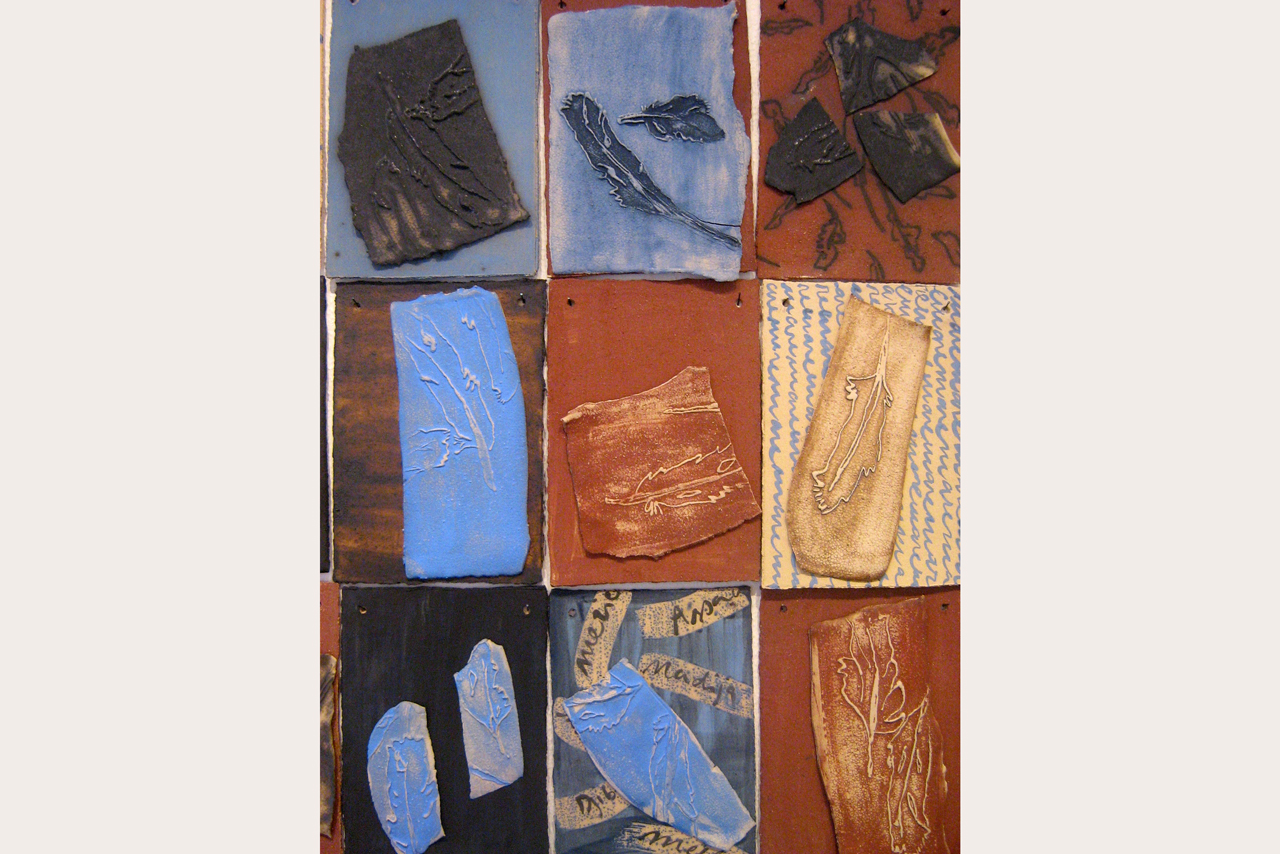
Elsewhere 1-2-3
2007 – in progress
Variable dimensions
Smoked terracotta, stoneware, slip
The arrow is present in all cultures as a directional symbol and it evokes an idea of space and time. This symbol has been chosen to represent the travels of migrant people to an elsewhere.
Forms, colours and graphic signs represent the different territories crossed and the paths and changes of cultures.


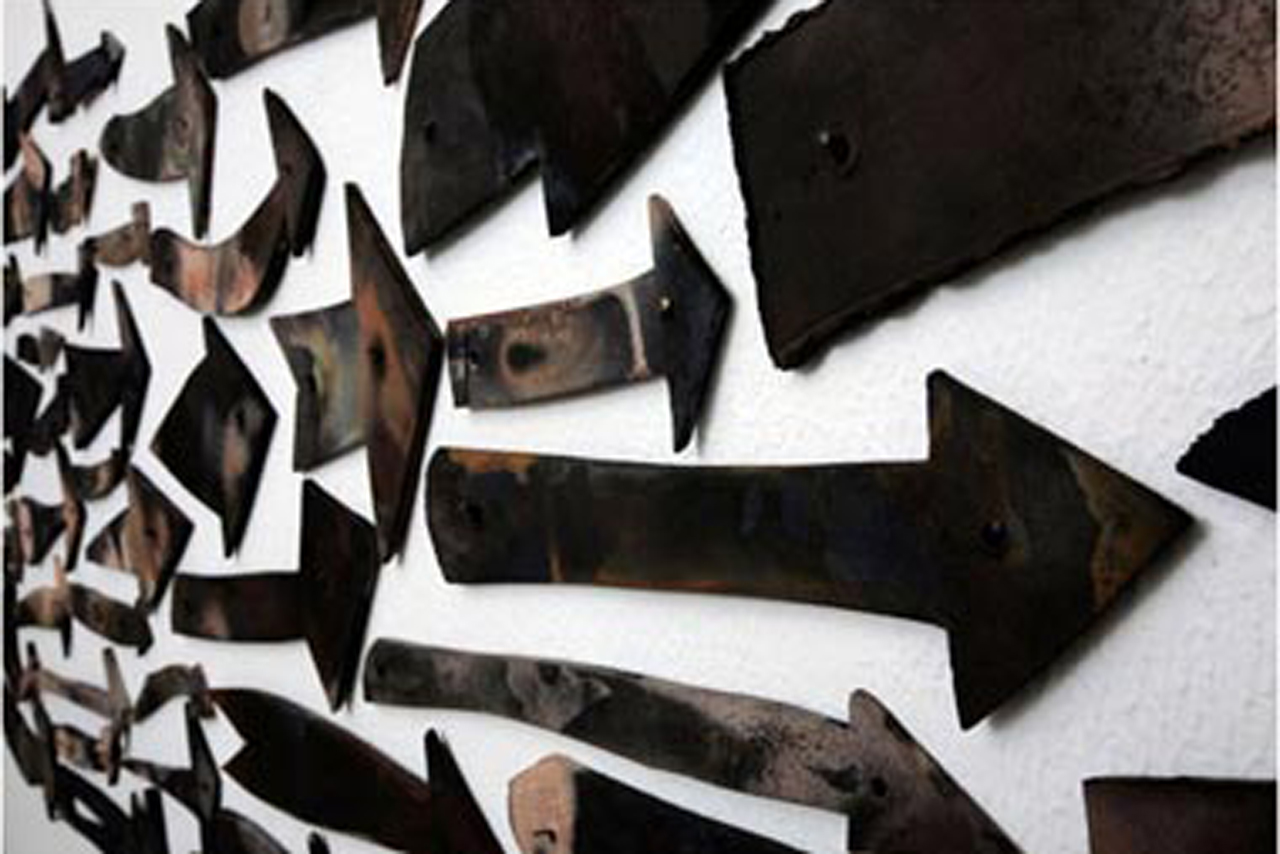
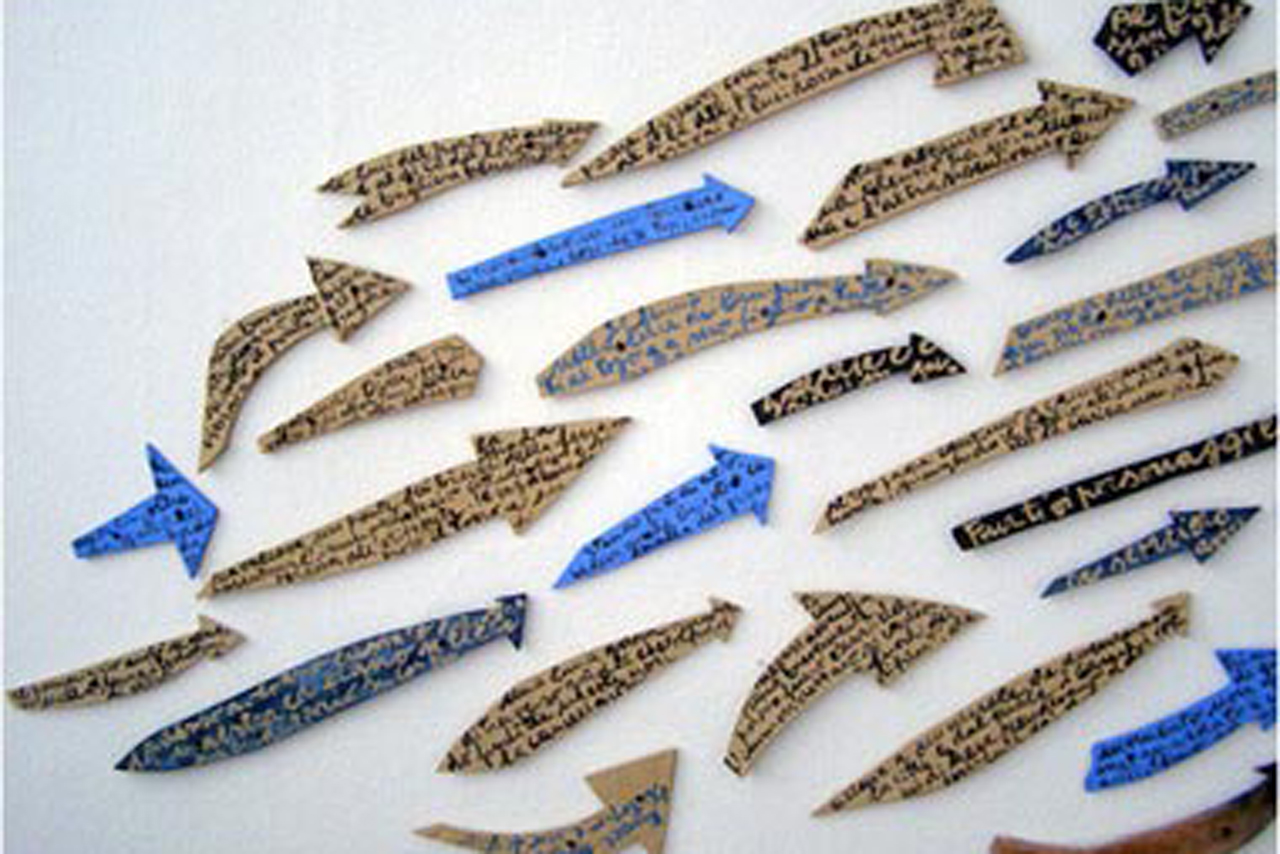
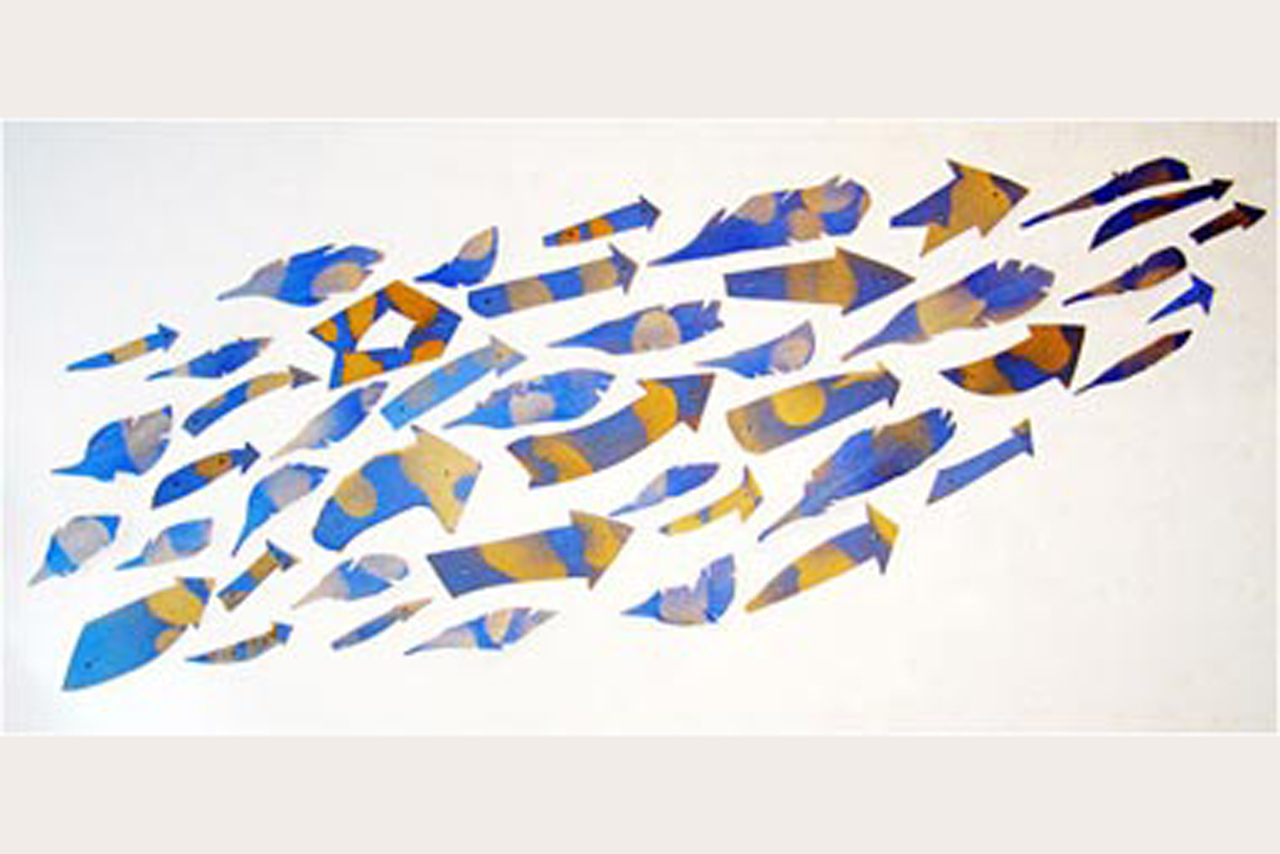
Saint Valentine
2007
Dimension of each slab 40x30xh5 cm
Stoneware, slip, ceramic serigraphy, plastic
Different people were involved in this project, that was born on the occasion of Saint Valentine’s Day.
Each of them expressed dreams, hopes, desires connected with love. Their messages show that languages change while people are joined by the universal sentiment of love.
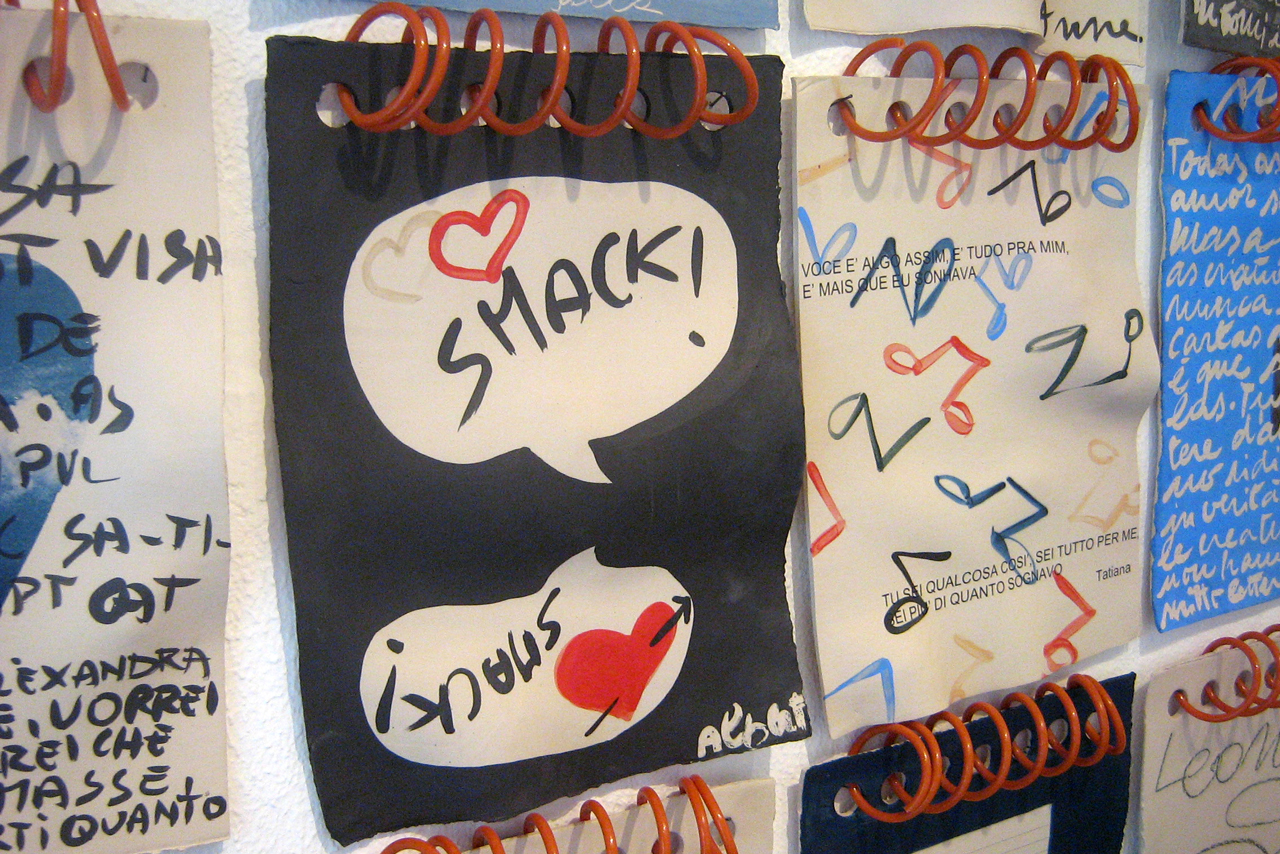


Penelope and Ulysses
2007 – in progress
Dimensions of the slabs 90x135xh1 cm
Dimension of the object 45x35xh48 cm
Stoneware, slip, glazes
The marks on the slabs evoke the weft and warp of cloth, that represent Penelope’s life. The object in the foreground, that symbolizes the sea and the elements that characterize it, represents the world of travelling Ulysses.

I Wrote to You in My Dream
2006 – in progress
Variable dimensions from 35 to 51 cm
Stoneware, slip, glazes
Each pencil has a different personality and it is used as a symbol to evoke the communication process created through writing.
In 2006 this work was selected at the International Ceramic Contest of L’Alcora, Spain.

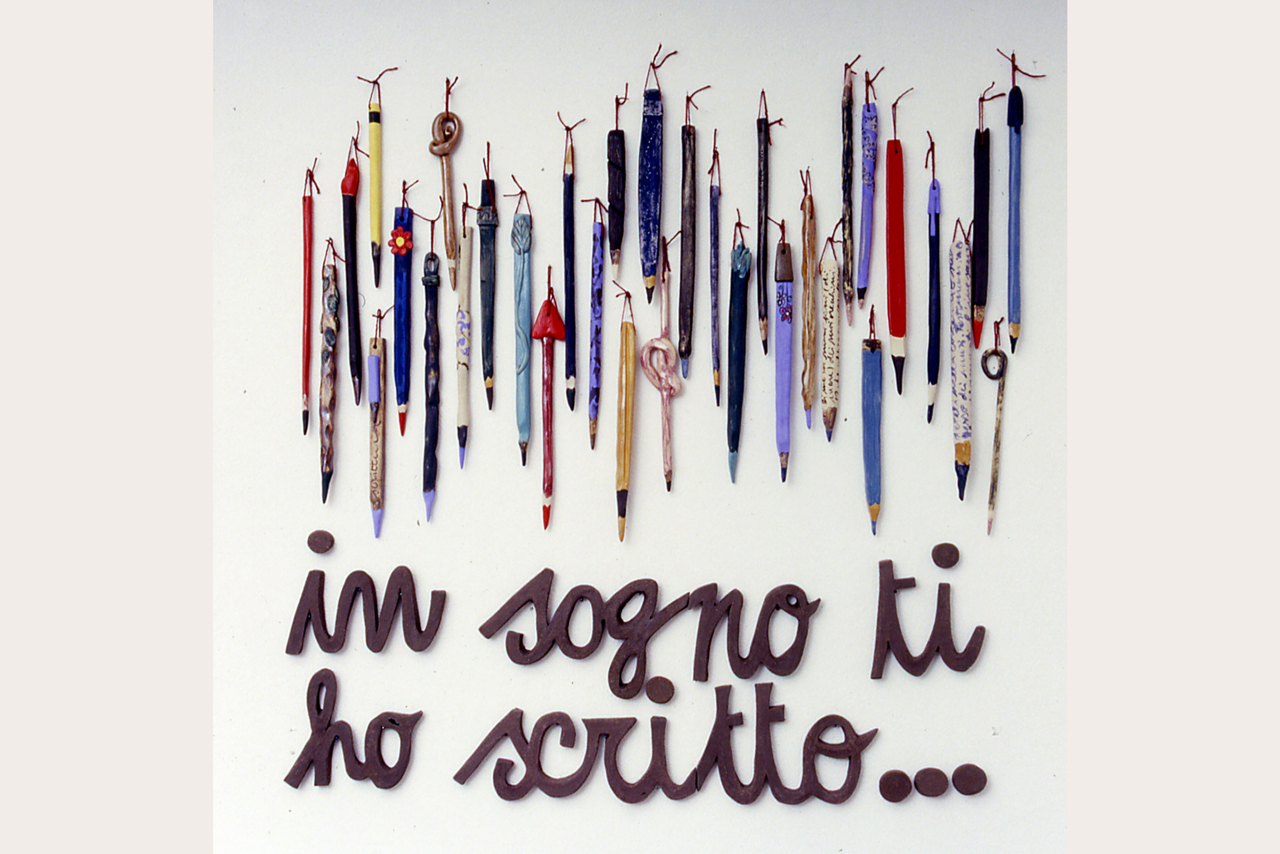

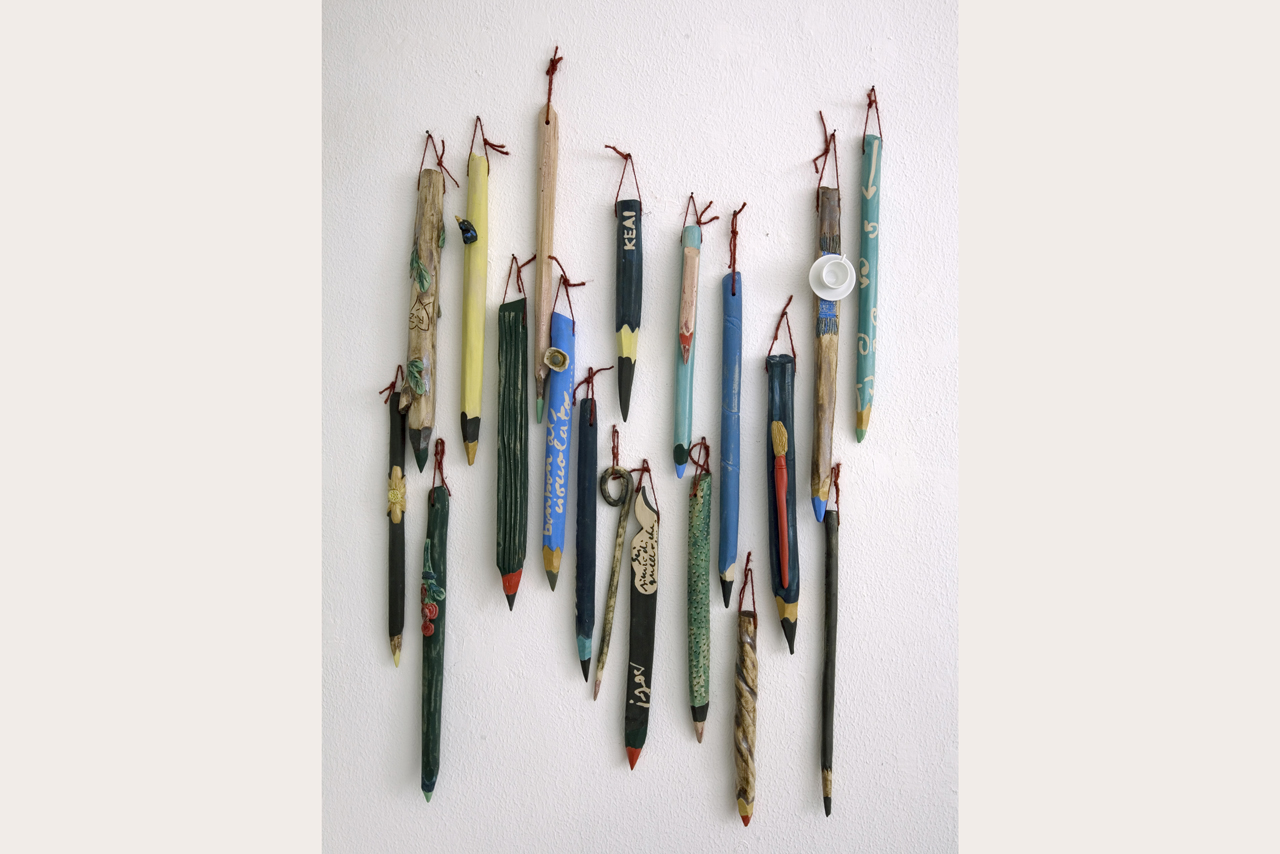
Travels
2006 – in progress
Each sculpture measures about 18x17x13 cm
Stoneware, slip, ceramic serigraphy
Human history is characterized by real or mental movings, migrations, nomadism. Each travel is like a box containing memories, sensations, emotions, desires and it is metaphor for the way of life. The pictures of this work are accompanied by texts written by some of the masters of fiction.
This work was selected in different manifestations:
In 2003 at the International Ceramic Contest “Cerco” of Saragoza, Spain.
In 2014 at the XVIIth International Ceramic Biennial of Chateauroux, France.




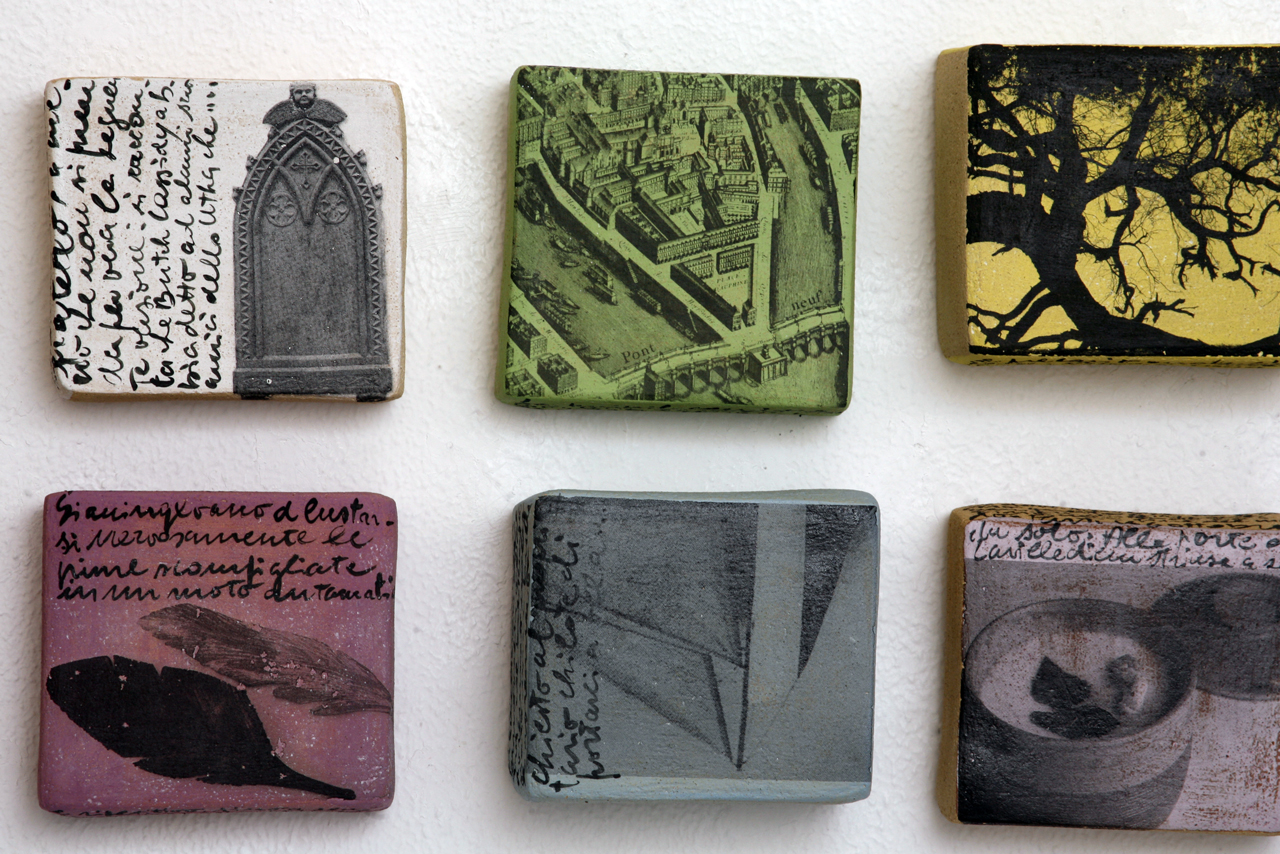

Toward the South
2006 – in progress
Variable dimension, about 130x100xh6 cm
Stoneware, slip, glazes
Bruce Chatwin wrote in the book “The Songlines”: “ In The Descent of Man Darwin points out that the migratory instinct is stronger than the mother instinct in certain kinds of birds. One mother leaves its little birds in the nest in order not to give up the long journey toward the South.”
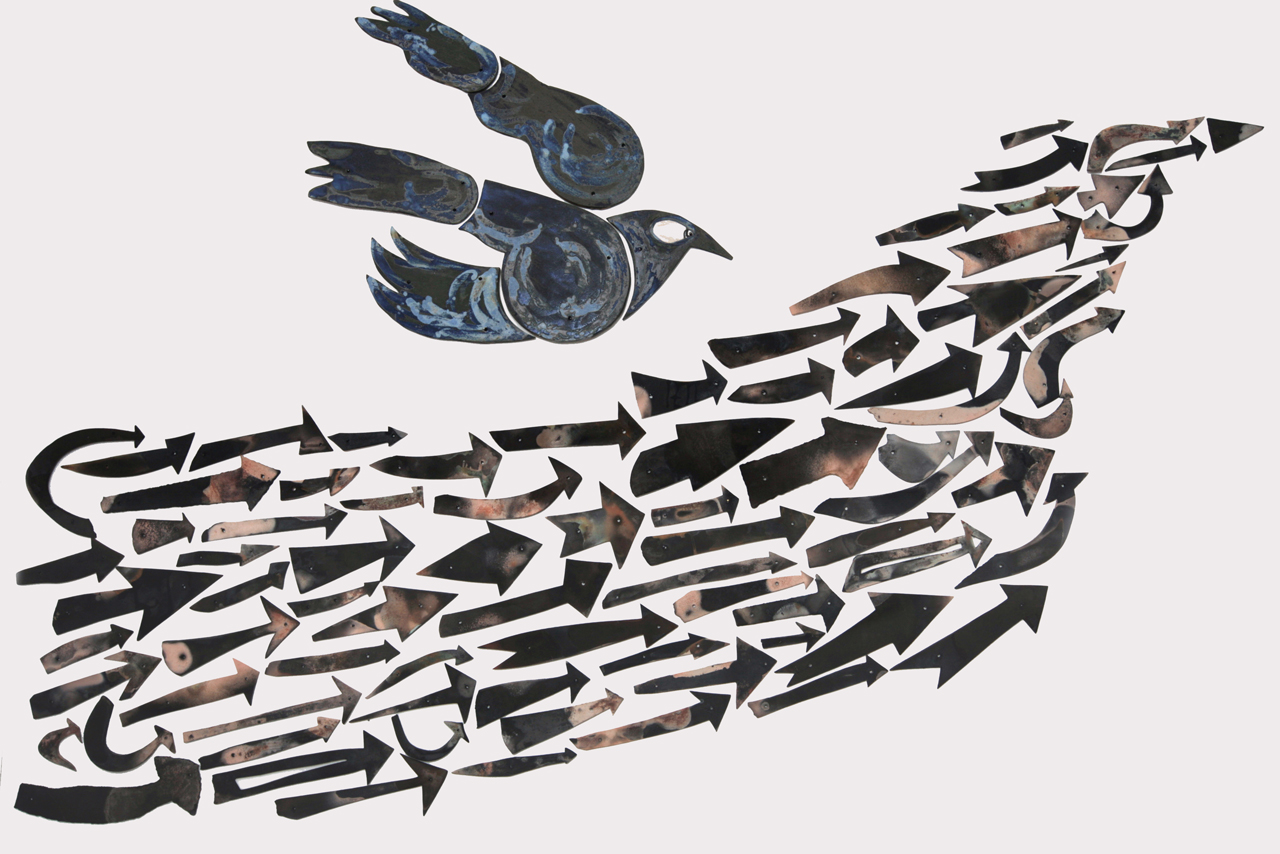

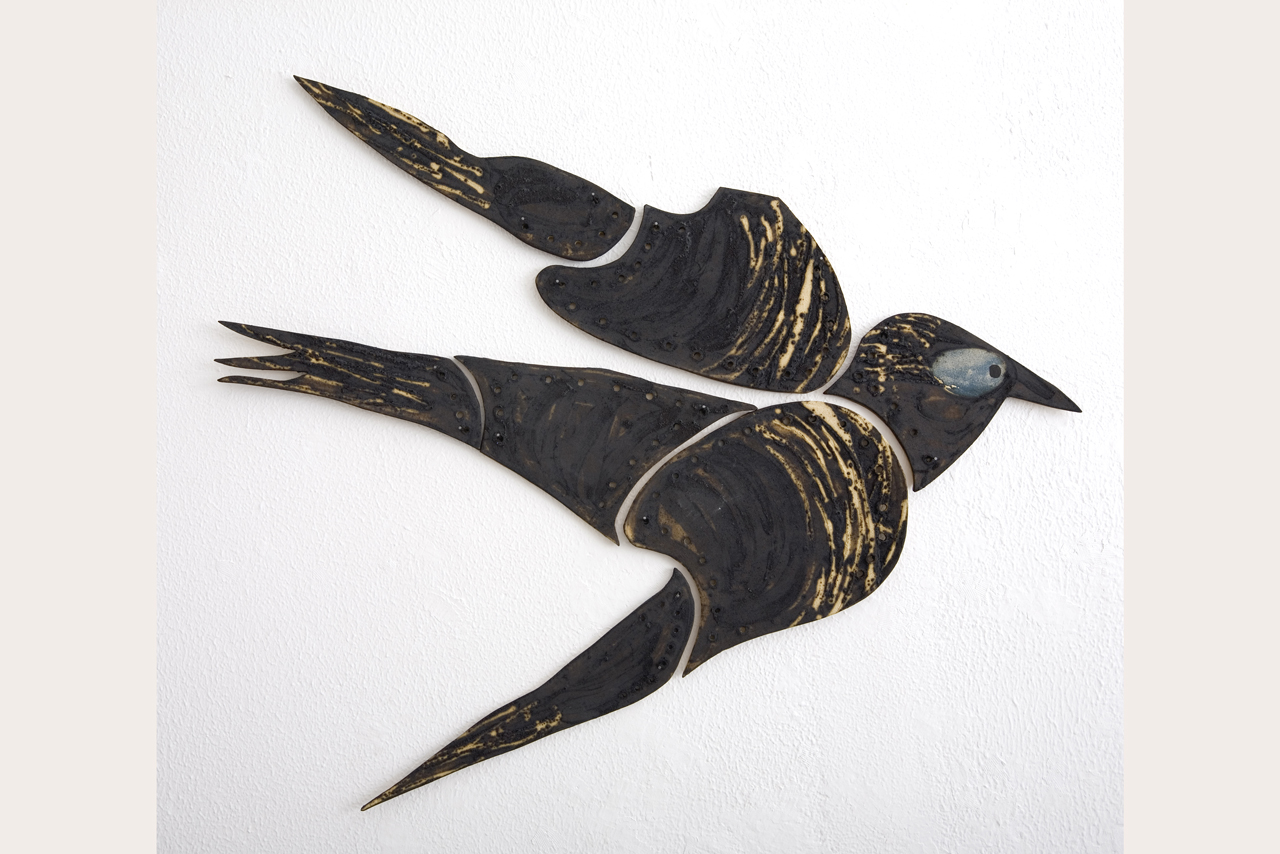

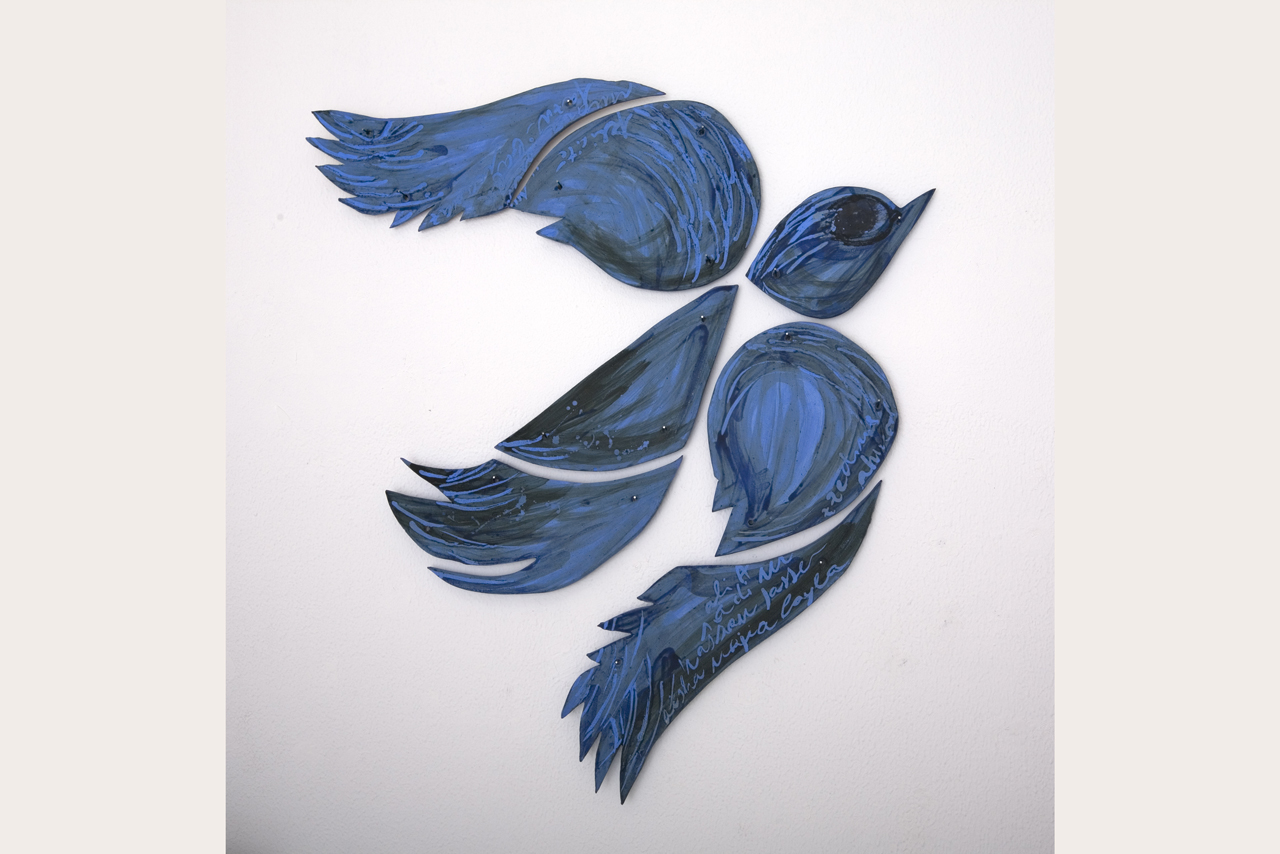
Love Poem 1-2-3
2005 – in progress
90x60xh0,5 cm – 25x133xh0,5 cm – 60x123xh0,5 cm
Stoneware, slip, ceramic serigraphy
The poetic texts accompany the floreal images and the vases/sky that represent the universality of love. Each of these works is a tribute to the love feeling in its infinite variations.

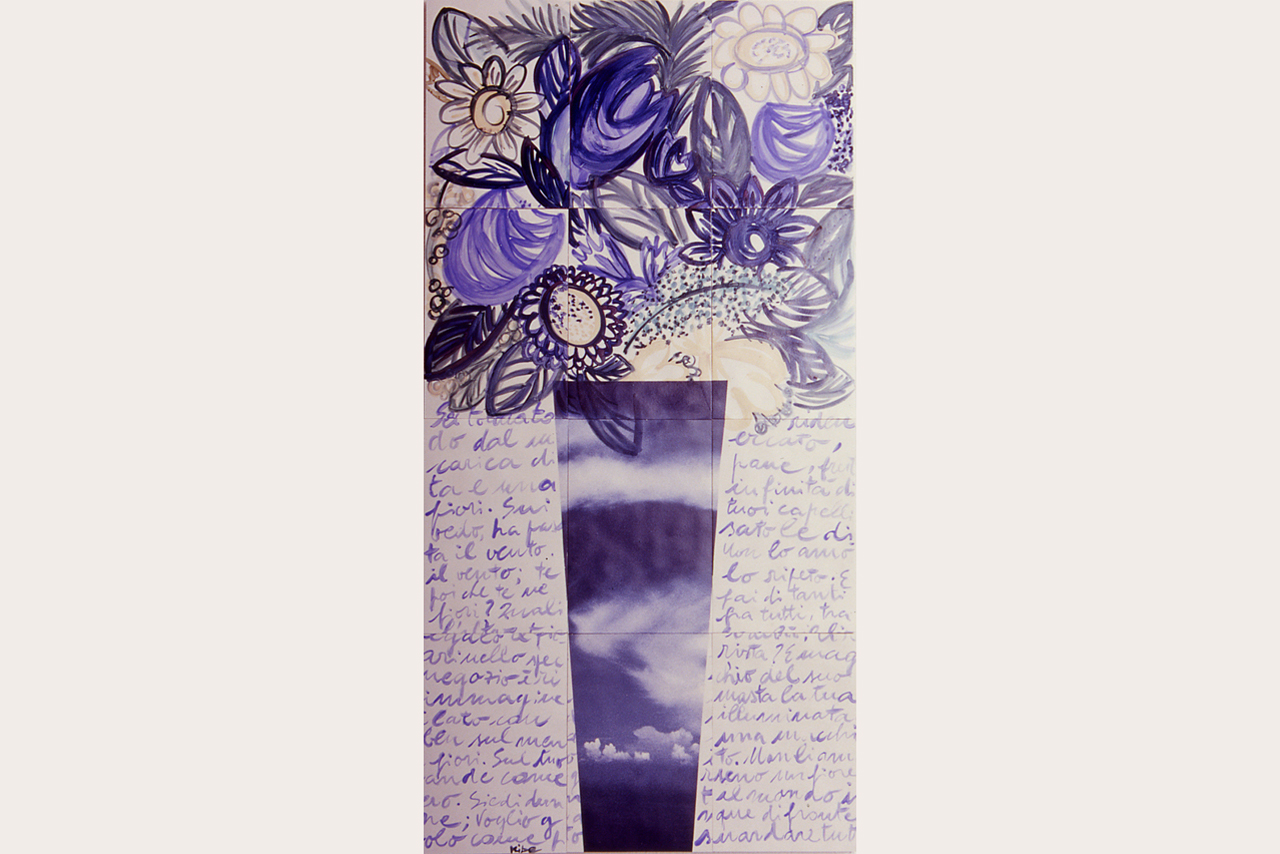

Treasure Island
2005
135x135xh3 cm
Stoneware, porcelain, slip
Thirty-five slabs, corresponding to the chapters of the novel, evoke the treasure island imagined and described by Robert Louis Stevenson. This work is a tribute to the dreams and travels of mind that characterize the life of each person.
In 2005 this work was selected at the International Ceramic Contest of L’Alcora, Spain.
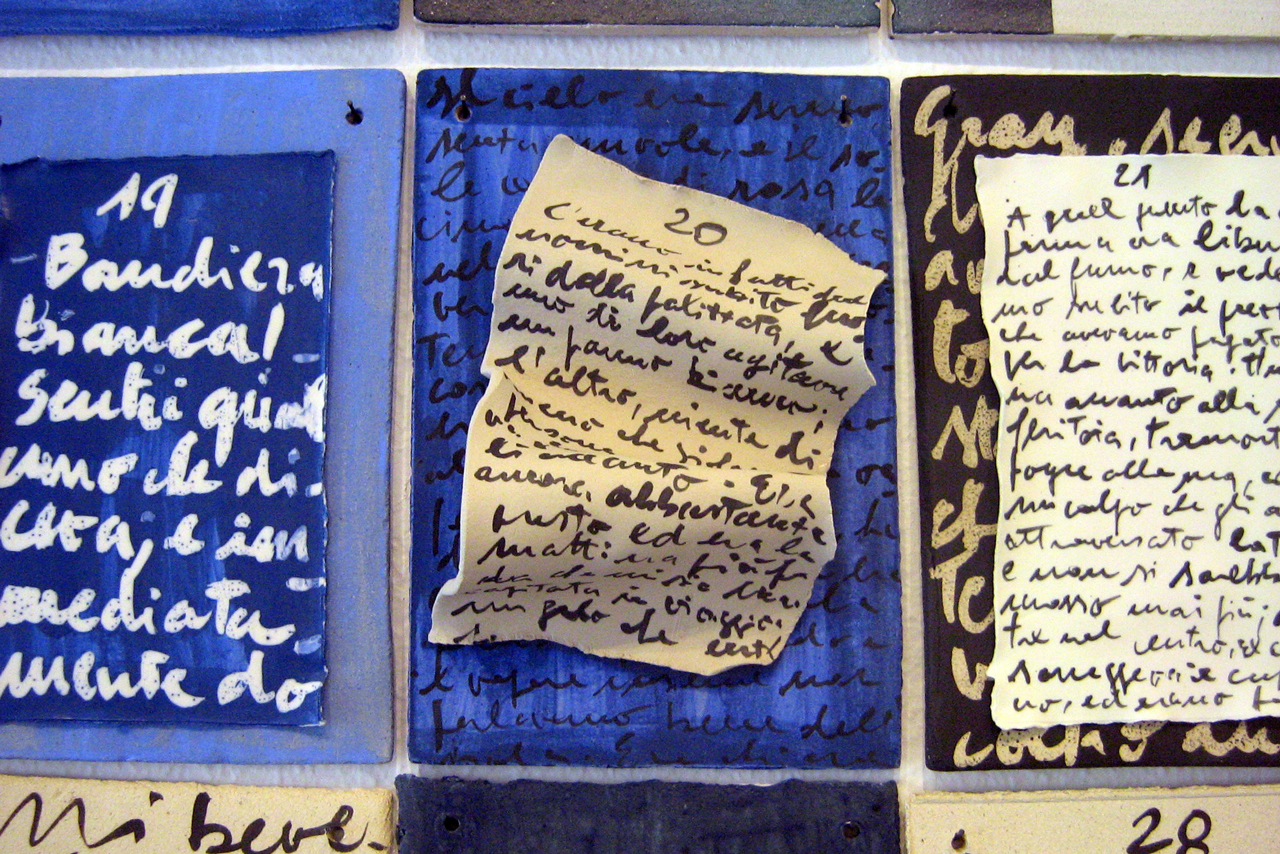
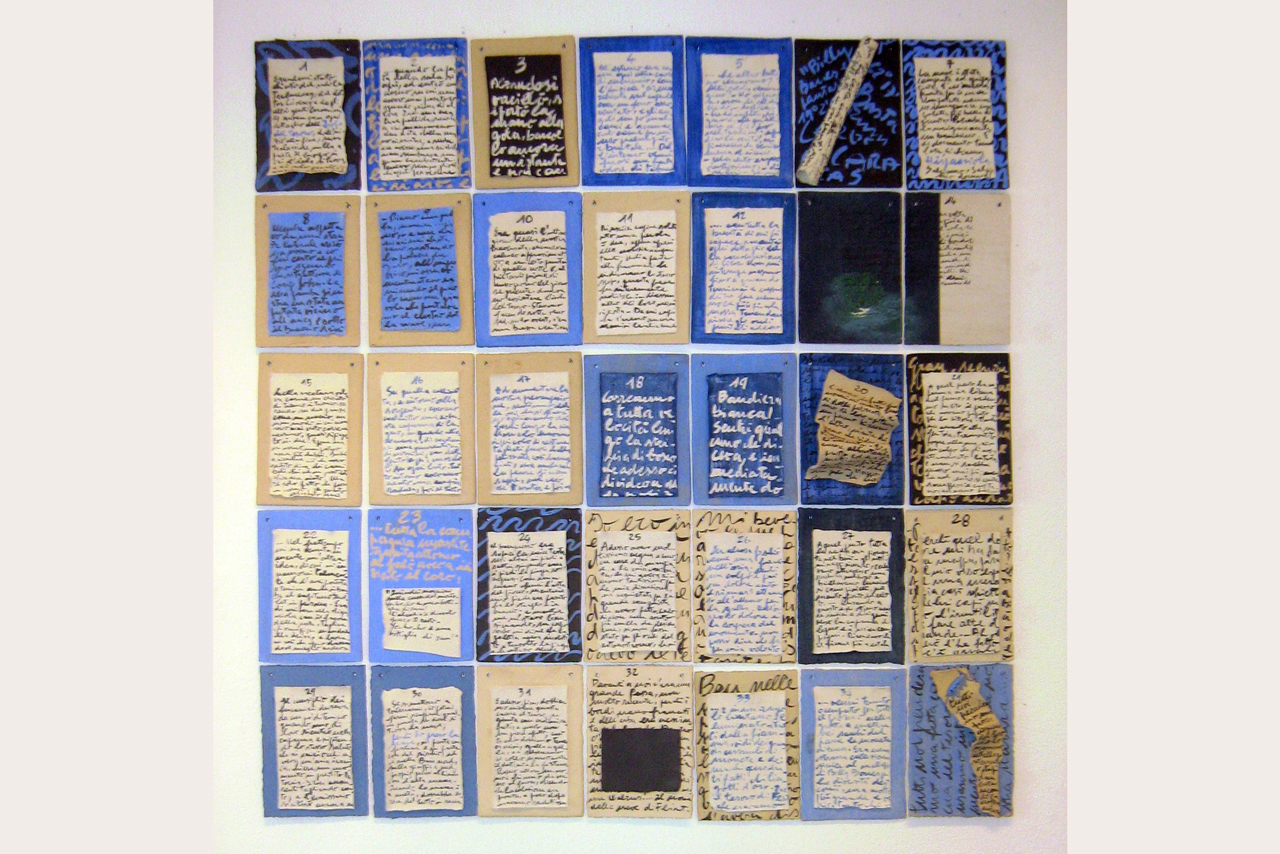
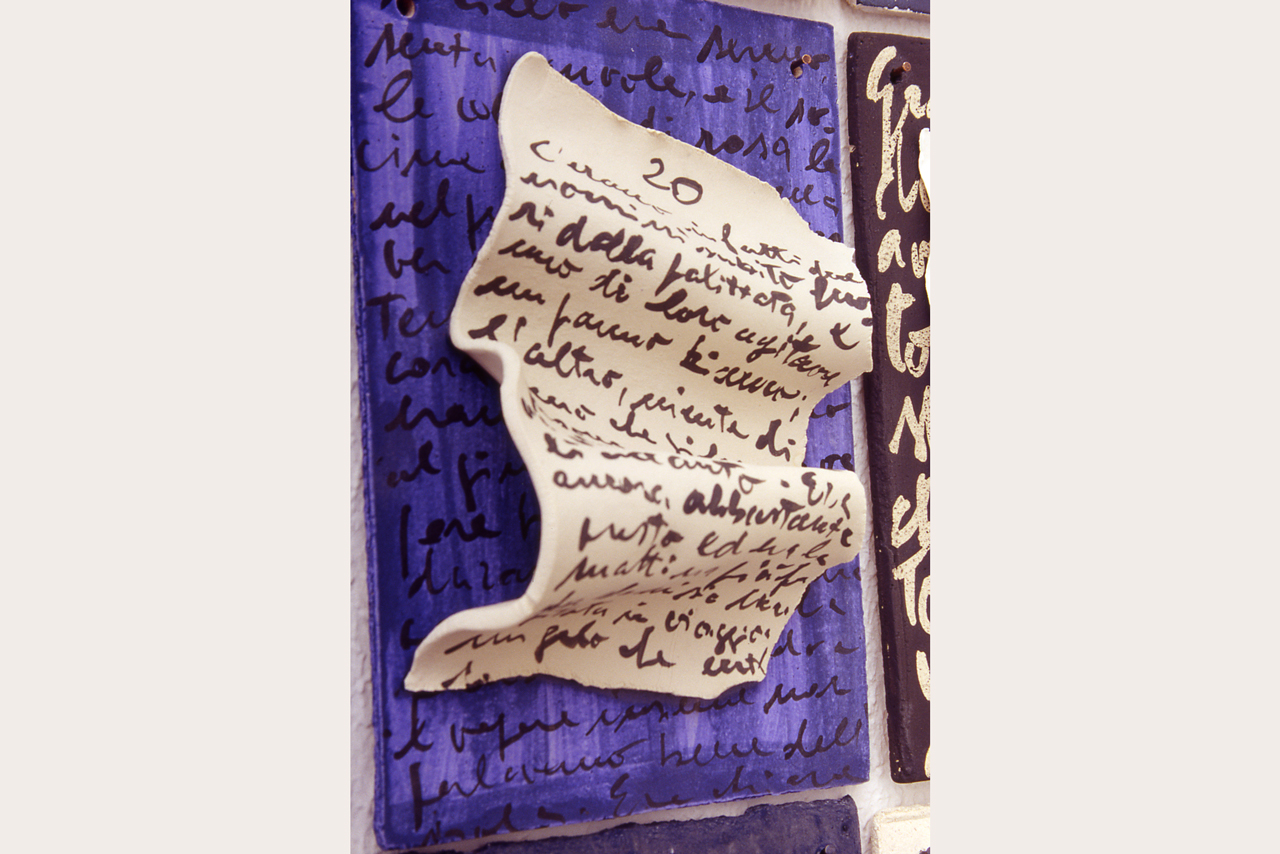
Conversations 1-2-3
1. 2005
36x25xh48 cm
Stoneware, slip, glazes
2. 33x42xh55 cm
Stoneware, slip, glazes
3. 32x41xh47 cm
Stoneware, slip, glazes
The places of conversation are intimate, cosy, domestic rooms, that remind memory of theatrical spaces in which words and feelings involve a wider audience.
In 2005 this work was selected at the International Ceramic Biennial of Manises (Spain).

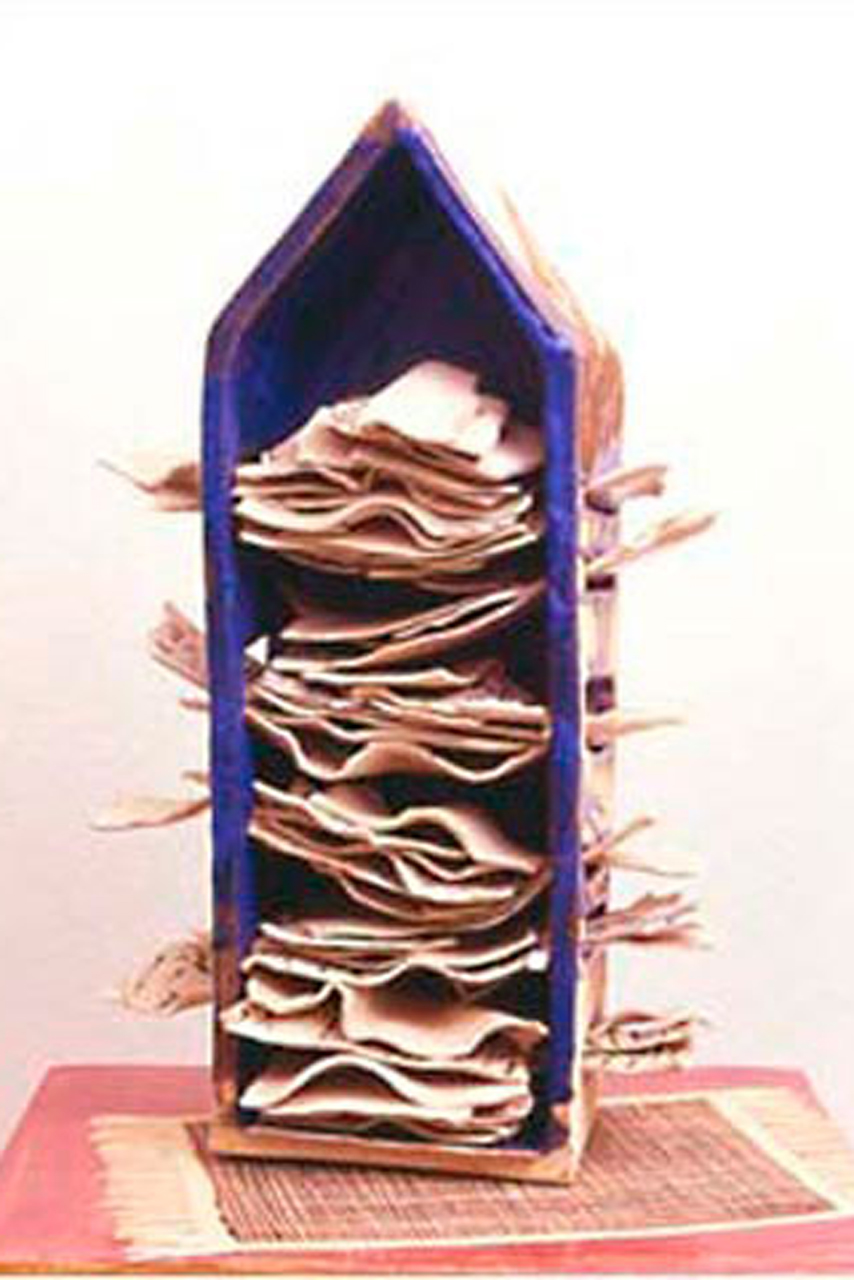

Celestial Loves and Other Loves
2005 – in progress
Variable dimensions from 16 to 56 cm
Stoneware, slip, glazes
The theme of love is represented by a universal symbol of collective imagination: heart. This symbolic object is utilized to narrate the infinite expressions of love, sometimes in an ironic and easygoing way, sometimes in a romantic and yearning way.
In 2006 this work was selected at the International Ceramic Contest Cerco of Saragoza, Spain.
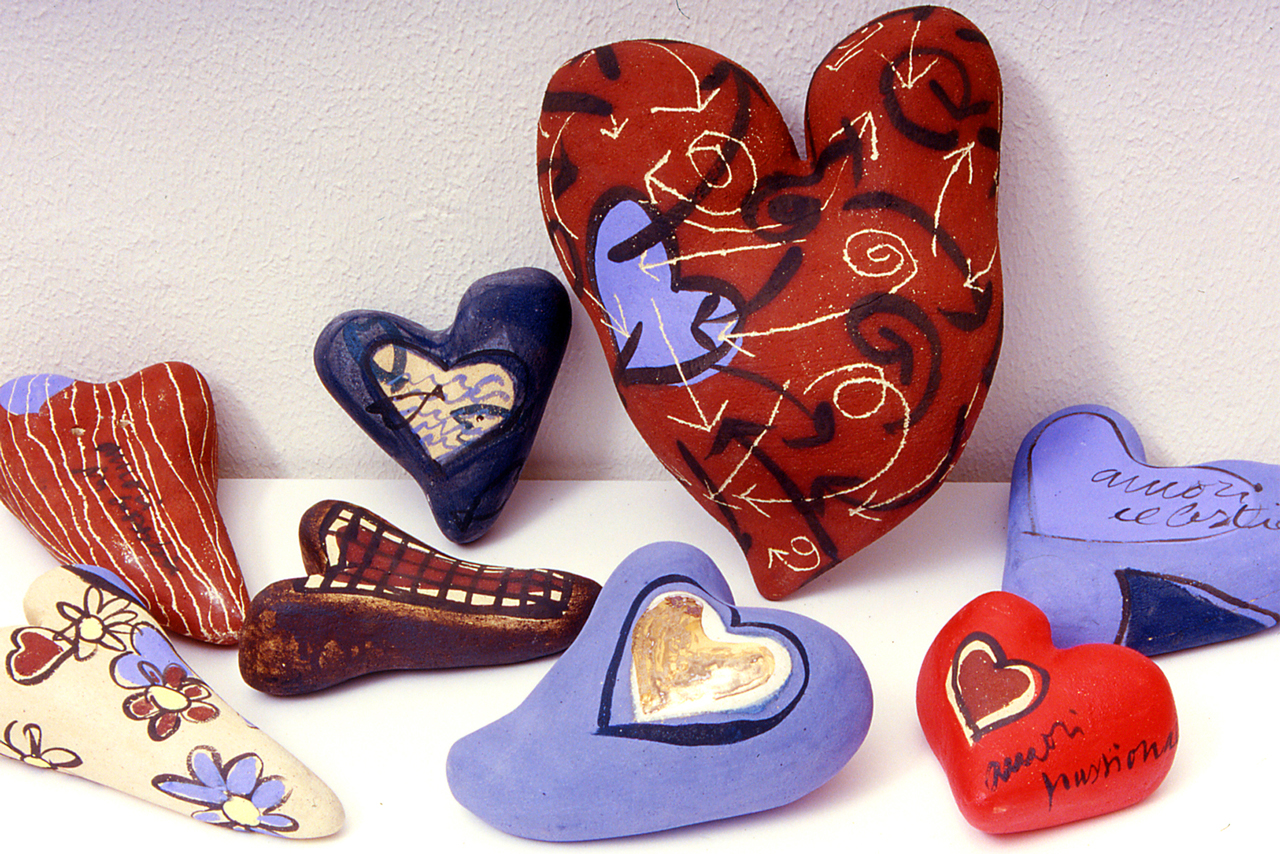


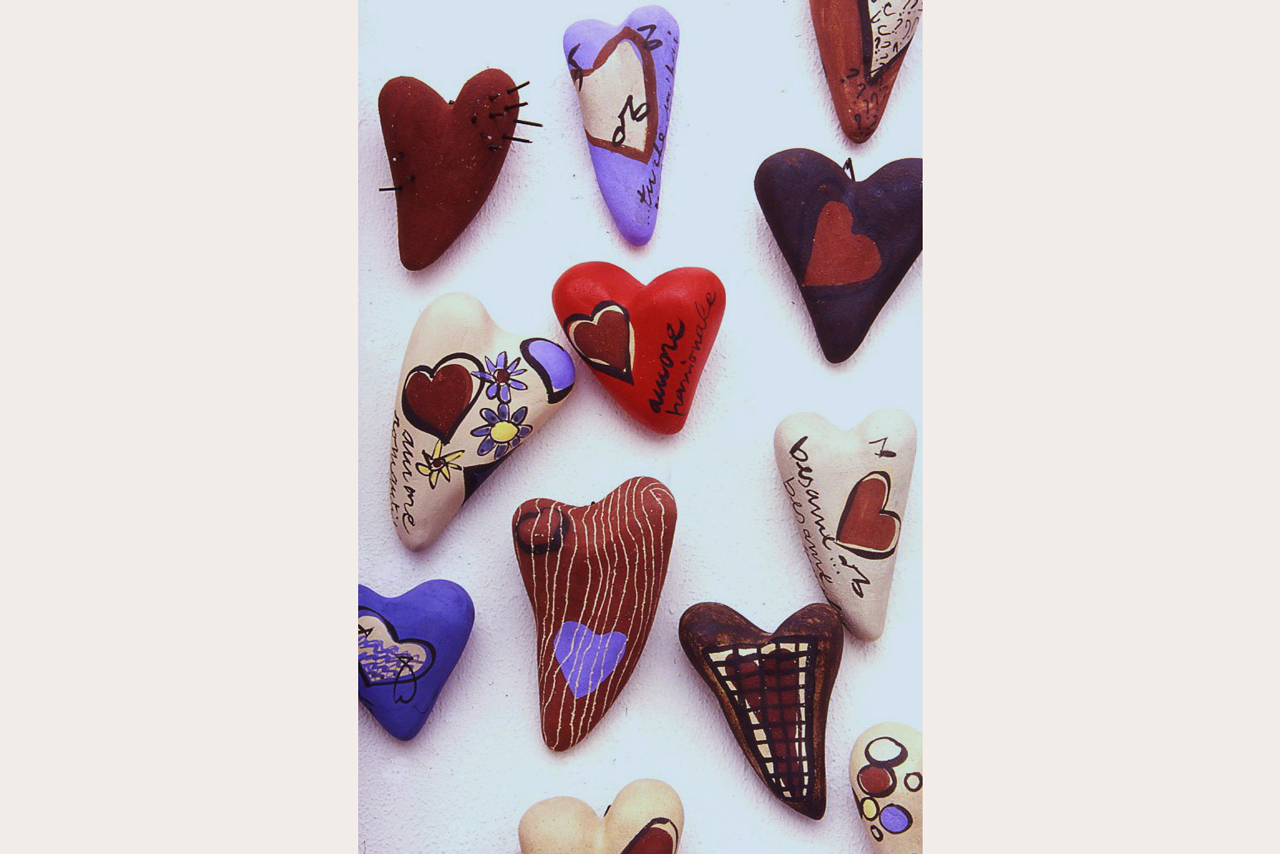
Ulysses is at Home
2004
The fish have different dimensions.
Object 30x38xh59 cm
Stoneware, slip, oxides, glazes
The fish in the background represent the sedentary activity that Ulysses has chosen after a life engaged by travels. In the foreground there is a little sea that evokes memories and sensations.
In 2004 this work was selected at the international Ceramic Contest of L’Alcora, Spain.
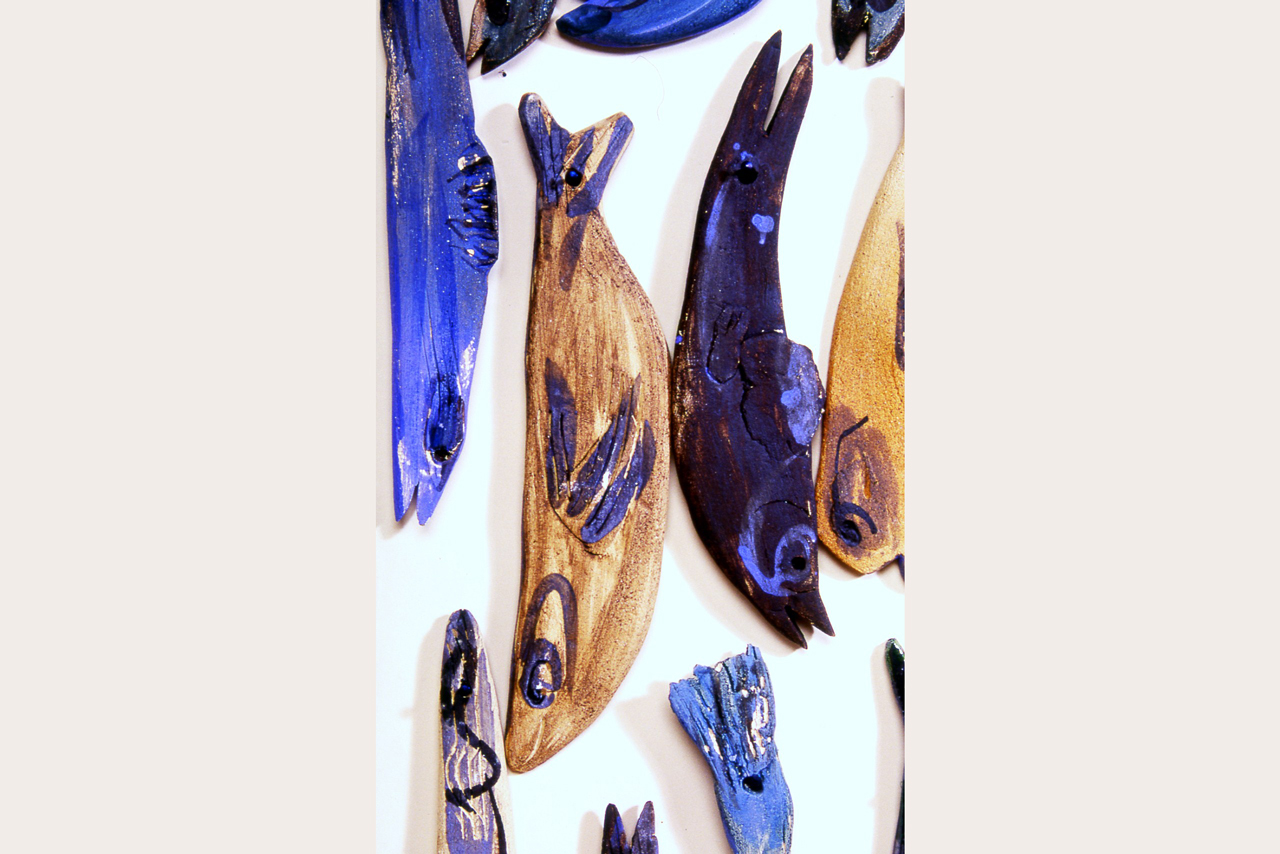
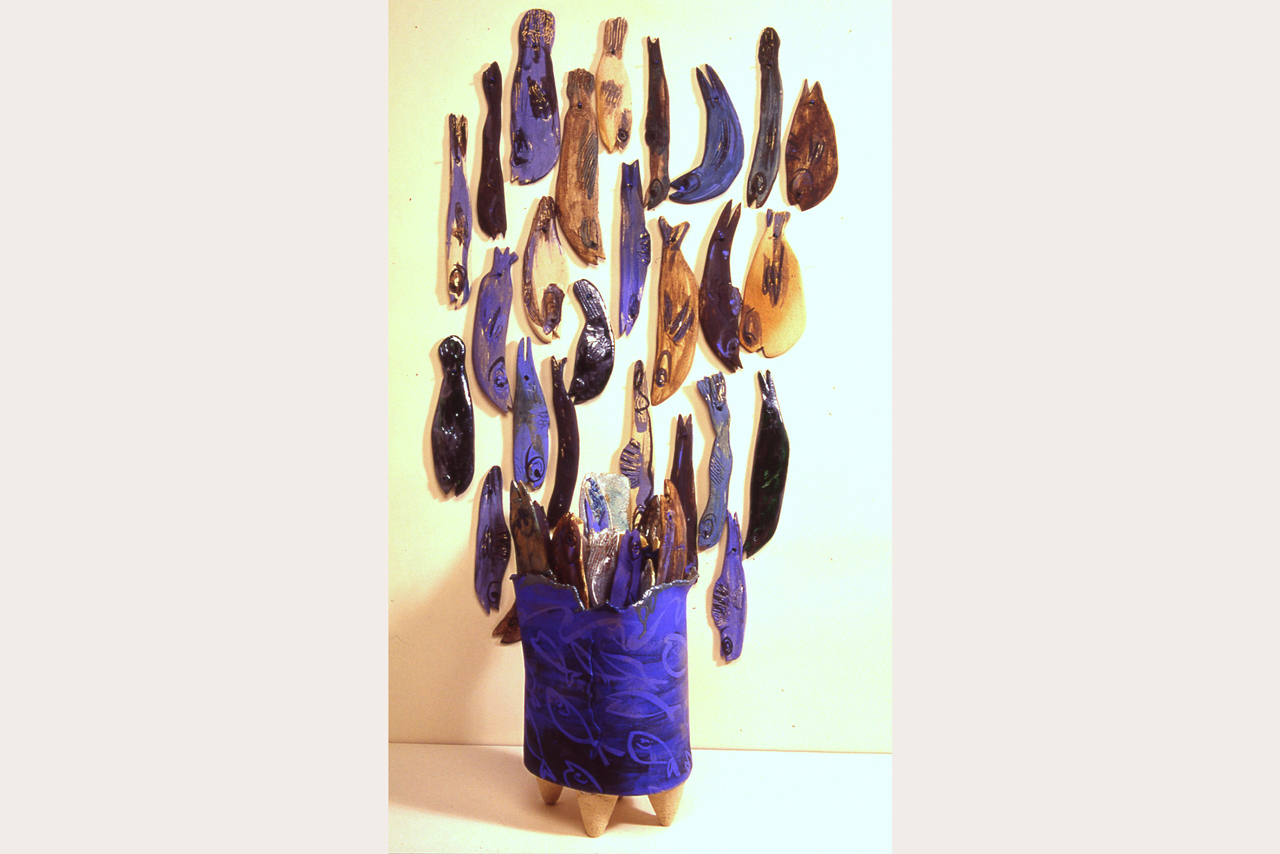
Love Words
2004
Slabs 76x136xh1 cm
Vases Ø 28xh41 e Ø 19x h29 cm
Stoneware, slip, oxides, glazes
Diario pubblico a Grottaglie
2019
00x00x00
Gres, ingobbi, serigrafia ceramica
A lot of words, typical of loving language, run after each other following a path that suggests infinite time and space. Even the objects in the foreground are containers of love messages.
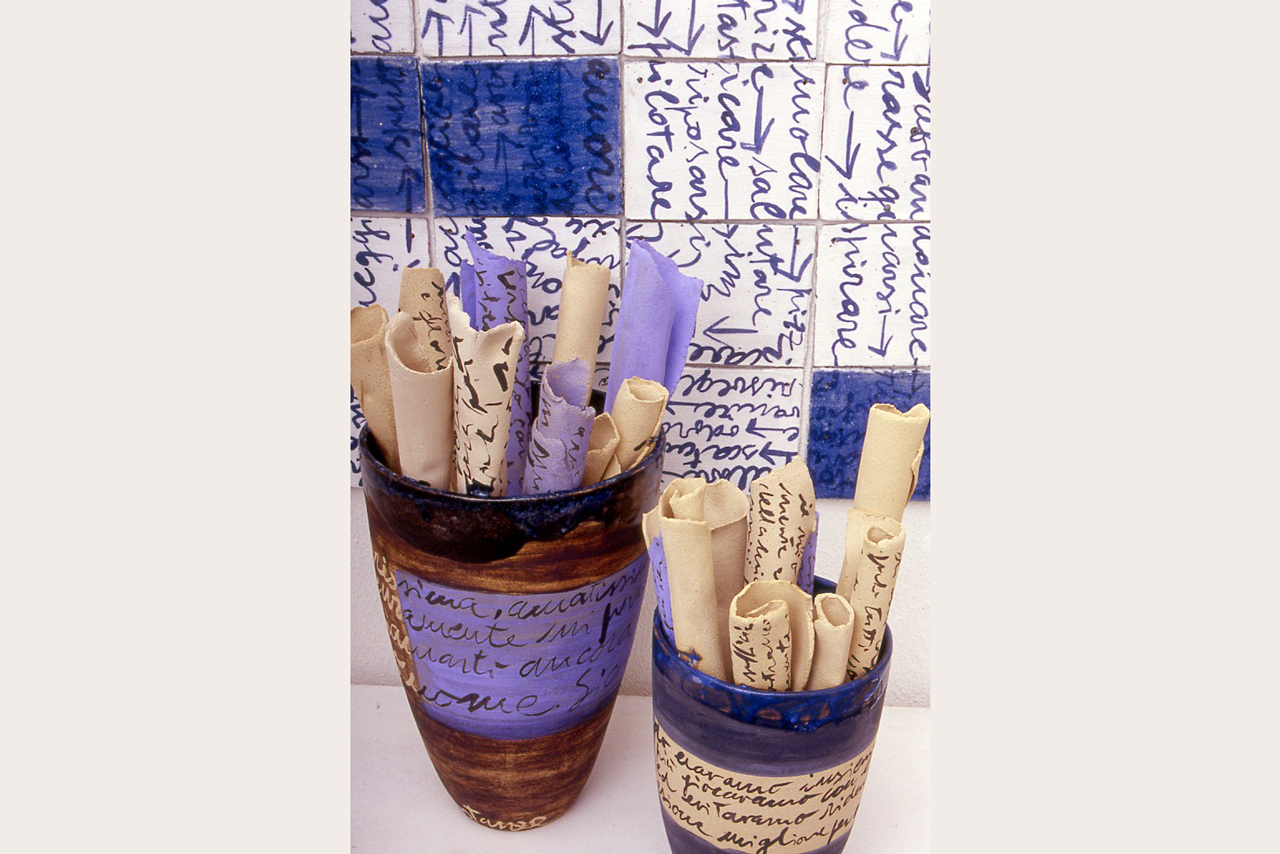

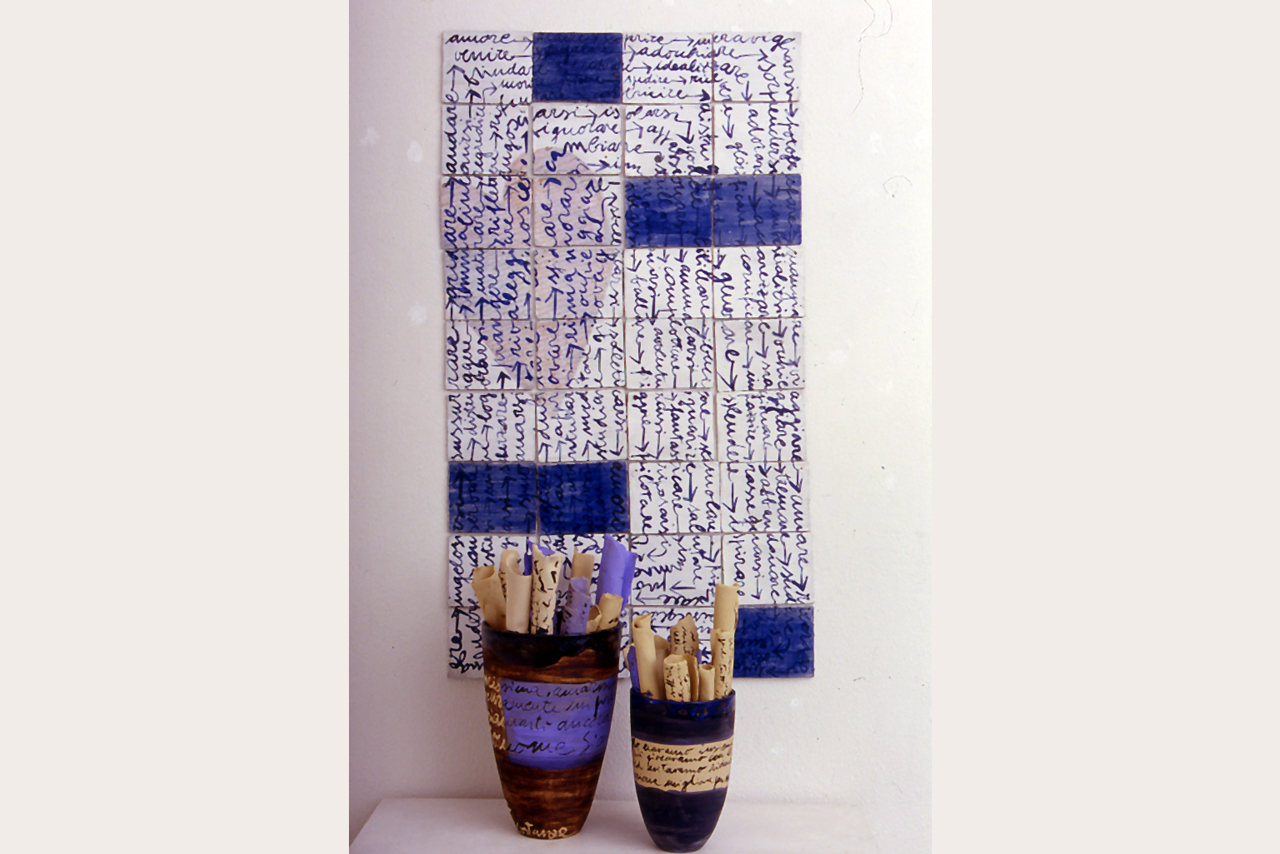
Shadow and Light
2003
Slabs 131x92xh1 cm
Object 48x20xh29 cm
Stoneware, slip, glazes, ceramic serigraphy
Diario pubblico a Grottaglie
2019
00x00x00
Gres, ingobbi, serigrafia ceramica
This work is a reflection upon the language of visual communication and infinite potentialities offered by form, colour, composition, bidimensionality, tridimensionality, shadow and light. In this work the objects lose their utilitarian function to acquire an aesthetic function.
In 2003 this work obtained the Honourable Mention at the International Ceramic Contest of L’Alcora, Spain.

Diary
2003 – in progress
Slabs 93x153xh1 cm
Object 47x27xh35 cm
Stoneware, slip, ceramic serigraphy
Diario pubblico a Grottaglie
2019
00x00x00
Gres, ingobbi, serigrafia ceramica
In this work the passion for ceramics expresses itself, as a diary, through words and pictures. The photos and writings on the slabs narrate the story of the objects I collected in different places of the world. The object in the foreground represents the ceramic work, from its design to realization. This is a work in progress that is enriched by the new objects collected over time.
In 2003 this work was selected at the International Biennial of Icheon, Korea.


Utz
2003
Slabs 145x181xh1 cm
Object 45x29xh41 cm
Porcelain, stoneware, slip, glazes
Diario pubblico a Grottaglie
2019
00x00x00
Gres, ingobbi, serigrafia ceramica
This work was inspired by the novel of the English writer Bruce Chatwin. Utz, who is the protagonist of this novel, dedicates his life to a mission: the search of one missing collection of porcelains. This mission becomes the reason of life and salt of existence for Utz. In 2003 this work won the Prize “Gres de Valls” at the International Ceramic Biennial of Manises, Spain.
This work is part of the Permanent Collection of the Ceramic Museum of Manises, Spain.

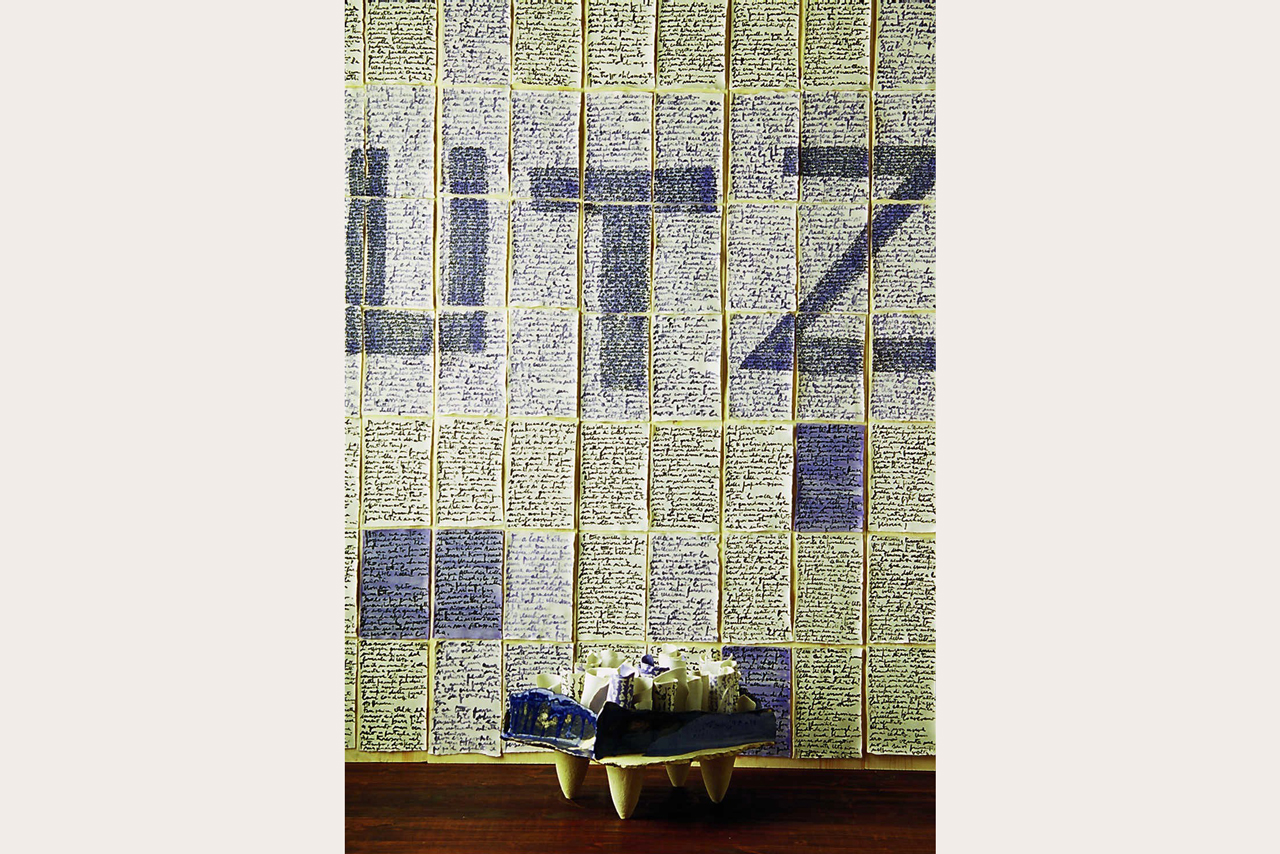
Object / Subject
2002 – in progress cm
Slabs 88x124xh1 cm
Object 21x15xh28 cm
Stoneware, oxides, glazes, ceramic serigraphy
Diario pubblico a Grottaglie
2019
00x00x00
Gres, ingobbi, serigrafia ceramica
The collective imagery identifies ceramics with the utilitarian object. Some kinds of ceramic objects, such as the teapot, symbolize ceramics and its connection with everyday life. In the work Object/Subject the teapot, having especially an aesthetic value, loses its utilitarian function becoming a hub of a research on the element of visual communication.
This work was selected in 2002 at the International Ceramic Biennial of Vallauris (France).

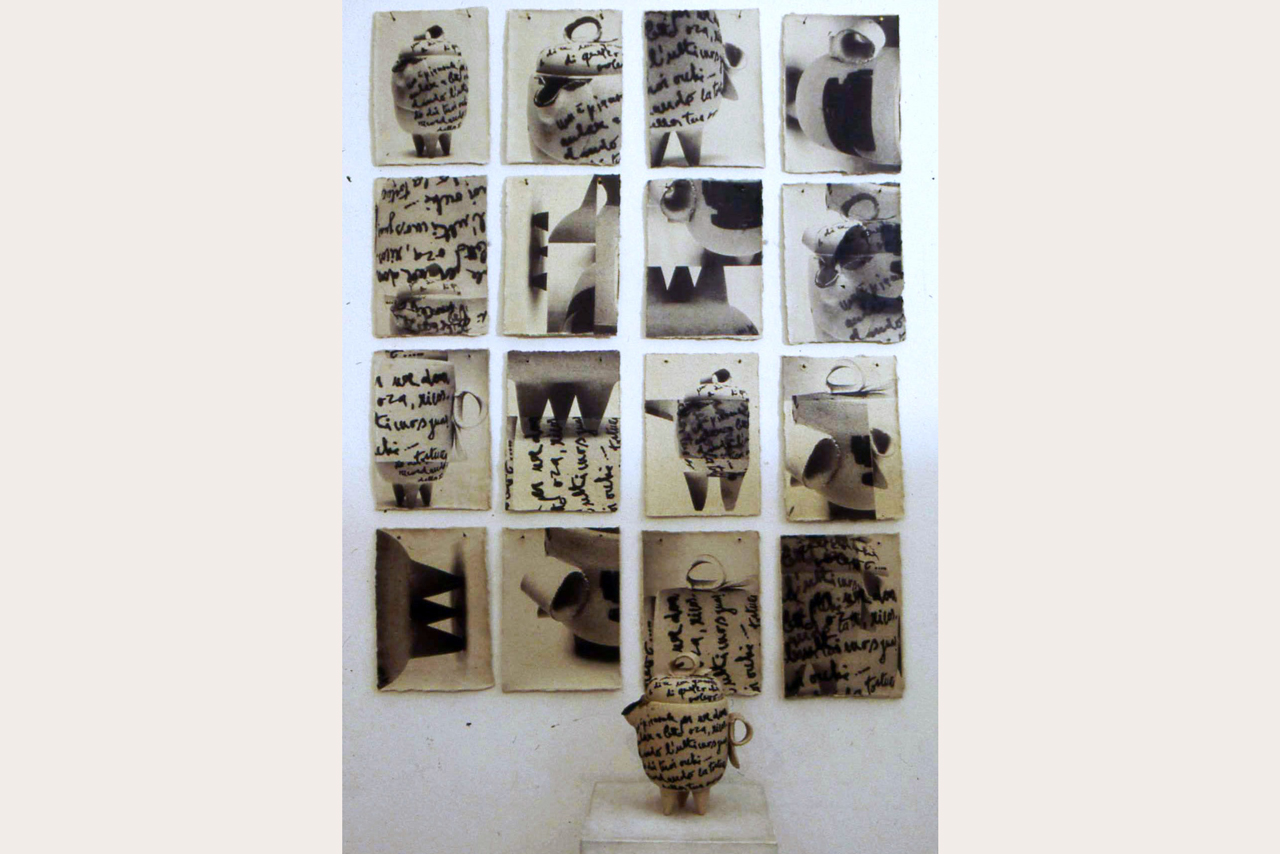
A Letter for You
2002 – in progress
Variable dimensions
Variable dimensions
Diario pubblico a Grottaglie
2019
00x00x00
Gres, ingobbi, serigrafia ceramica
The authors of these letters are writers, musicians, poets, artists who lived in different times. The writings are testimonies of the age in which they were born and they represent the passage of time. In this work written and visual communication are compared through literary contents, graphic and colour choices.
In 2010 this work participated in the exhibition Paginas de Barro/Palabras in Cordoba, Spain.

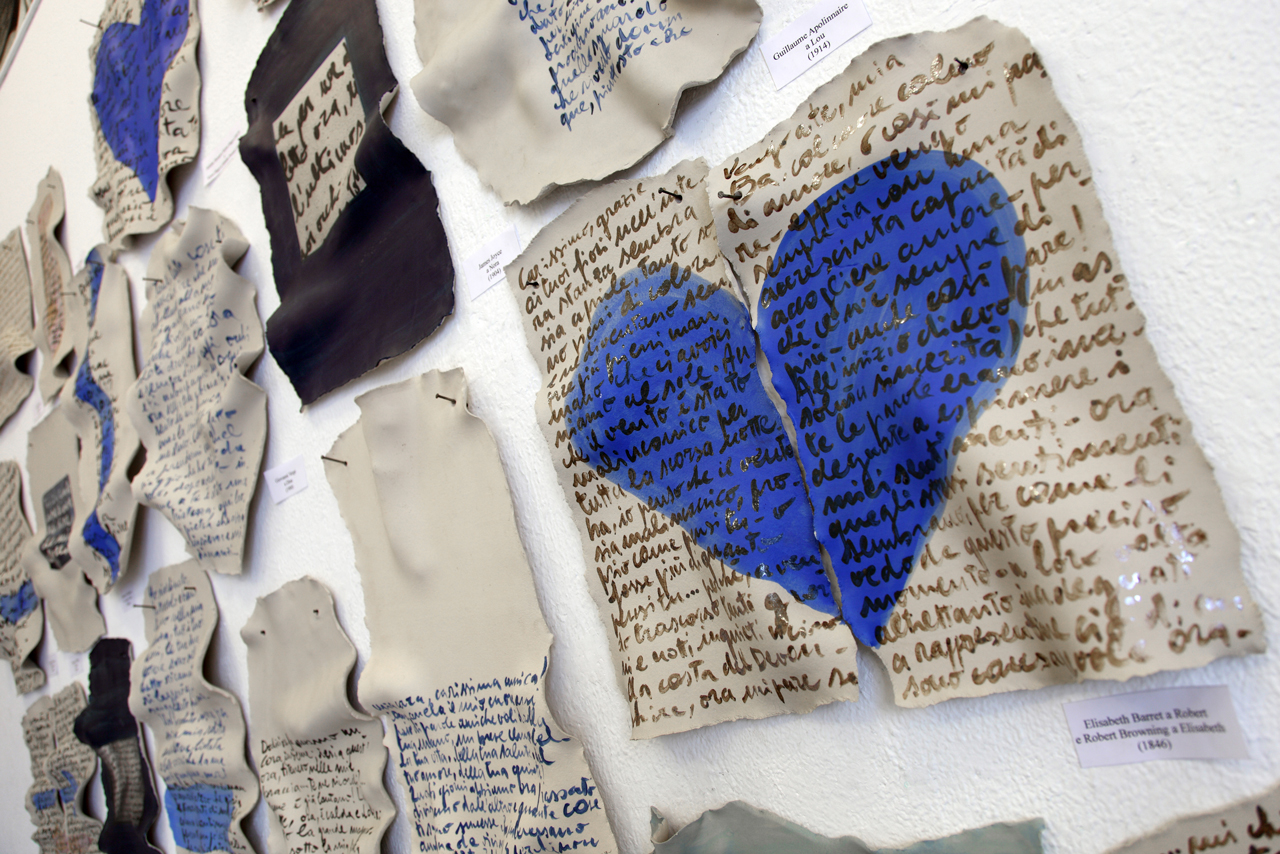

Ulysses’ Bed
2002
Slabs 89x134xh1 cm
Object 46x26xh56 cm
Stoneware, slip, oxides, glazes, ceramic serigraphya
Diario pubblico a Grottaglie
2019
00x00x00
Gres, ingobbi, serigrafia ceramica
The little sea in the foreground is like a memory box containing memories, feelings, real-life experiences. In this work the past of the travelling Ulysses is compared with the present of the sedentary Ulysses, represented by the domestic objects in the background.

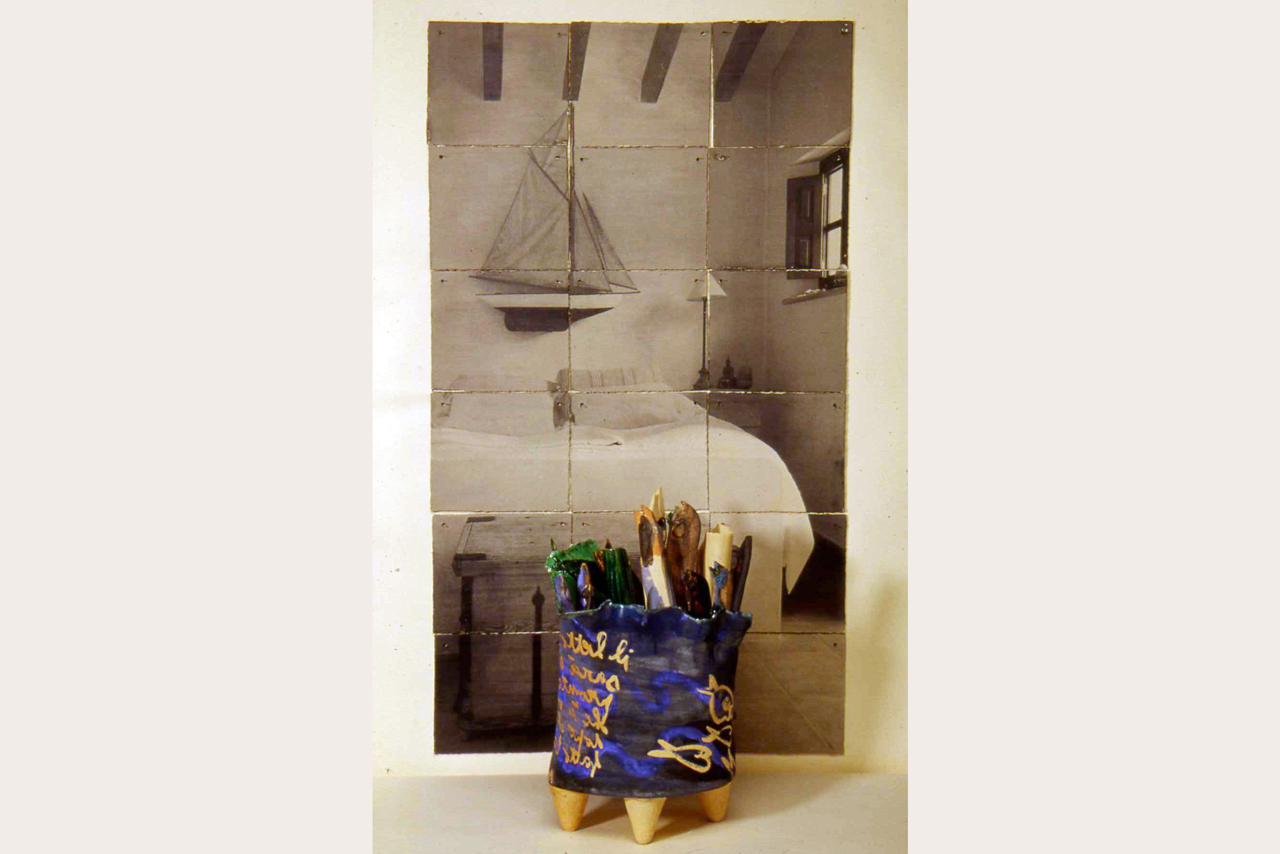

Sea of Words
2001 – in progress
About 150x200xh50 cm
Stoneware, oxides, slip
Diario pubblico a Grottaglie
2019
00x00x00
Gres, ingobbi, serigrafia ceramica
The installation is made of many slabs evoking the wave of the sea. The slabs can be arranged according to the different spatial requirements. Sea animals, graphic designs, symbologies connected with water and even a lot of words live in this sea.
In 2001 this work was been selected at the International Ceramic Competition of L’Alcora (Spain).


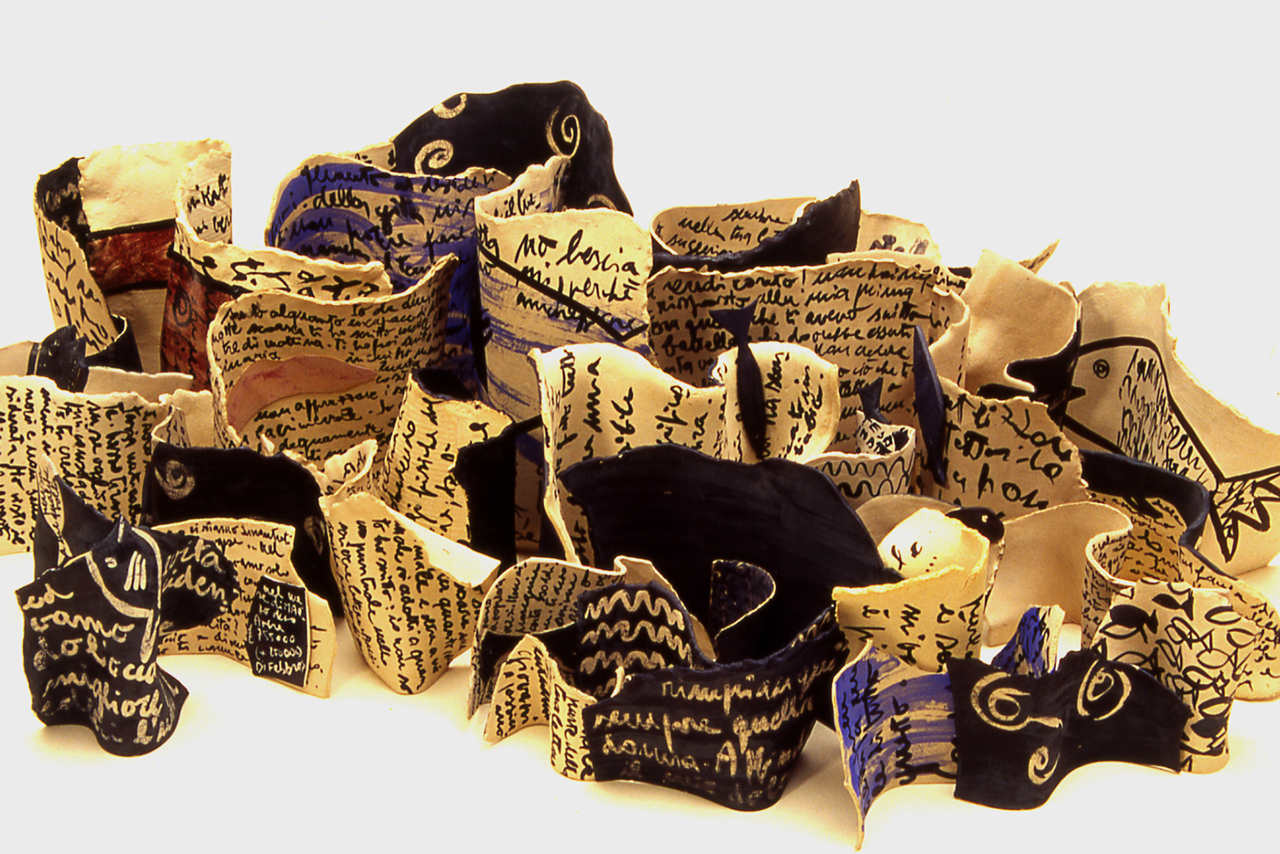
Marriage of Jugs
2001 – in progress
Variable dimensions
Stoneware, slip, glazes
Diario pubblico a Grottaglie
2019
00x00x00
Gres, ingobbi, serigrafia ceramica
The bowl, vase, teapot, jug are the archetypal forms we refer to when we think of ceramics. But, while the bowl, vase, teapot are conceived as single forms, the jug is generally conceived as a form forming a part of a group or a pair of objects. The jugs of this project symbolize the couple and the dynamics that it expresses, as the primary element of social organization.
Some of these works have been selected on different occasion:
in 2001 at the International Ceramic Competition Cerco of Saragoza, Spain.
In 2001 at the International Ceramic Competition of Taiwan.
